
251+ Math Research Topics [2024 Updated]
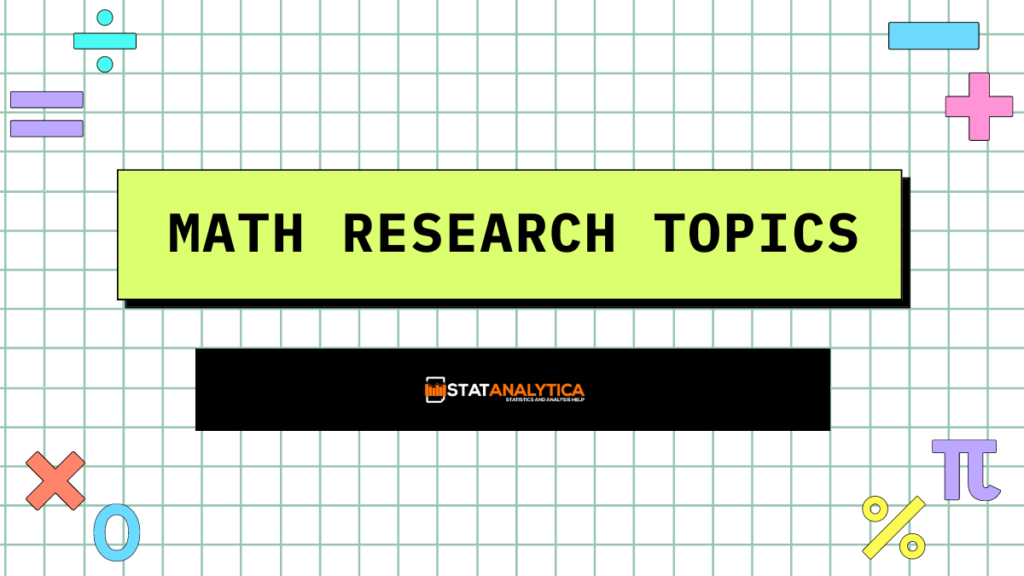
Mathematics, often dubbed as the language of the universe, holds immense significance in shaping our understanding of the world around us. It’s not just about crunching numbers or solving equations; it’s about unraveling mysteries, making predictions, and creating innovative solutions to complex problems. In this blog, we embark on a journey into the realm of math research topics, exploring various branches of mathematics and their real-world applications.
How Do You Write A Math Research Topic?
Writing a math research topic involves several steps to ensure clarity, relevance, and feasibility. Here’s a guide to help you craft a compelling math research topic:
- Identify Your Interests: Start by exploring areas of mathematics that interest you. Whether it’s pure mathematics, applied mathematics, or interdisciplinary topics, choose a field that aligns with your passion and expertise.
- Narrow Down Your Focus: Mathematics is a broad field, so it’s essential to narrow down your focus to a specific area or problem. Consider the scope of your research and choose a topic that is manageable within your resources and time frame.
- Review Existing Literature: Conduct a thorough literature review to understand the current state of research in your chosen area. Identify gaps, controversies, or unanswered questions that could form the basis of your research topic.
- Formulate a Research Question: Based on your exploration and literature review, formulate a clear and concise research question. Your research question should be specific, measurable, achievable, relevant, and time-bound (SMART).
- Consider Feasibility: Assess the feasibility of your research topic in terms of available resources, data availability, and research methodologies. Ensure that your topic is realistic and achievable within the constraints of your project.
- Consult with Experts: Seek feedback from mentors, advisors, or experts in the field to validate your research topic and refine your ideas. Their insights can help you identify potential challenges and opportunities for improvement.
- Refine and Iterate: Refine your research topic based on feedback and further reflection. Iterate on your ideas to ensure clarity, coherence, and relevance to the broader context of mathematics research.
- Craft a Title: Once you have finalized your research topic, craft a compelling title that succinctly summarizes the essence of your research. Your title should be descriptive, engaging, and reflective of the key themes of your study.
- Write a Research Proposal: Develop a comprehensive research proposal outlining the background, objectives, methodology, and expected outcomes of your research. Your research proposal should provide a clear roadmap for your study and justify the significance of your research topic.
By following these steps, you can effectively write a math research topic that is well-defined, relevant, and poised to make a meaningful contribution to the field of mathematics.
251+ Math Research Topics: Beginners To Advanced
- Prime Number Distribution in Arithmetic Progressions
- Diophantine Equations and their Solutions
- Applications of Modular Arithmetic in Cryptography
- The Riemann Hypothesis and its Implications
- Graph Theory: Exploring Connectivity and Coloring Problems
- Knot Theory: Unraveling the Mathematics of Knots and Links
- Fractal Geometry: Understanding Self-Similarity and Dimensionality
- Differential Equations: Modeling Physical Phenomena and Dynamical Systems
- Chaos Theory: Investigating Deterministic Chaos and Strange Attractors
- Combinatorial Optimization: Algorithms for Solving Optimization Problems
- Computational Complexity: Analyzing the Complexity of Algorithms
- Game Theory: Mathematical Models of Strategic Interactions
- Number Theory: Exploring Properties of Integers and Primes
- Algebraic Topology: Studying Topological Invariants and Homotopy Theory
- Analytic Number Theory: Investigating Properties of Prime Numbers
- Algebraic Geometry: Geometry Arising from Algebraic Equations
- Galois Theory: Understanding Field Extensions and Solvability of Equations
- Representation Theory: Studying Symmetry in Linear Spaces
- Harmonic Analysis: Analyzing Functions on Groups and Manifolds
- Mathematical Logic: Foundations of Mathematics and Formal Systems
- Set Theory: Exploring Infinite Sets and Cardinal Numbers
- Real Analysis: Rigorous Study of Real Numbers and Functions
- Complex Analysis: Analytic Functions and Complex Integration
- Measure Theory: Foundations of Lebesgue Integration and Probability
- Topological Groups: Investigating Topological Structures on Groups
- Lie Groups and Lie Algebras: Geometry of Continuous Symmetry
- Differential Geometry: Curvature and Topology of Smooth Manifolds
- Algebraic Combinatorics: Enumerative and Algebraic Aspects of Combinatorics
- Ramsey Theory: Investigating Structure in Large Discrete Structures
- Analytic Geometry: Studying Geometry Using Analytic Methods
- Hyperbolic Geometry: Non-Euclidean Geometry of Curved Spaces
- Nonlinear Dynamics: Chaos, Bifurcations, and Strange Attractors
- Homological Algebra: Studying Homology and Cohomology of Algebraic Structures
- Topological Vector Spaces: Vector Spaces with Topological Structure
- Representation Theory of Finite Groups: Decomposition of Group Representations
- Category Theory: Abstract Structures and Universal Properties
- Operator Theory: Spectral Theory and Functional Analysis of Operators
- Algebraic Number Theory: Study of Algebraic Structures in Number Fields
- Cryptanalysis: Breaking Cryptographic Systems Using Mathematical Methods
- Discrete Mathematics: Combinatorics, Graph Theory, and Number Theory
- Mathematical Biology: Modeling Biological Systems Using Mathematical Tools
- Population Dynamics: Mathematical Models of Population Growth and Interaction
- Epidemiology: Mathematical Modeling of Disease Spread and Control
- Mathematical Ecology: Dynamics of Ecological Systems and Food Webs
- Evolutionary Game Theory: Evolutionary Dynamics and Strategic Behavior
- Mathematical Neuroscience: Modeling Brain Dynamics and Neural Networks
- Mathematical Physics: Mathematical Models in Physical Sciences
- Quantum Mechanics: Foundations and Applications of Quantum Theory
- Statistical Mechanics: Statistical Methods in Physics and Thermodynamics
- Fluid Dynamics: Modeling Flow of Fluids Using Partial Differential Equations
- Mathematical Finance: Stochastic Models in Finance and Risk Management
- Option Pricing Models: Black-Scholes Model and Beyond
- Portfolio Optimization: Maximizing Returns and Minimizing Risk
- Stochastic Calculus: Calculus of Stochastic Processes and Itô Calculus
- Financial Time Series Analysis: Modeling and Forecasting Financial Data
- Operations Research: Optimization of Decision-Making Processes
- Linear Programming: Optimization Problems with Linear Constraints
- Integer Programming: Optimization Problems with Integer Solutions
- Network Flow Optimization: Modeling and Solving Flow Network Problems
- Combinatorial Game Theory: Analysis of Games with Perfect Information
- Algorithmic Game Theory: Computational Aspects of Game-Theoretic Problems
- Fair Division: Methods for Fairly Allocating Resources Among Parties
- Auction Theory: Modeling Auction Mechanisms and Bidding Strategies
- Voting Theory: Mathematical Models of Voting Systems and Social Choice
- Social Network Analysis: Mathematical Analysis of Social Networks
- Algorithm Analysis: Complexity Analysis of Algorithms and Data Structures
- Machine Learning: Statistical Learning Algorithms and Data Mining
- Deep Learning: Neural Network Models with Multiple Layers
- Reinforcement Learning: Learning by Interaction and Feedback
- Natural Language Processing: Statistical and Computational Analysis of Language
- Computer Vision: Mathematical Models for Image Analysis and Recognition
- Computational Geometry: Algorithms for Geometric Problems
- Symbolic Computation: Manipulation of Mathematical Expressions
- Numerical Analysis: Algorithms for Solving Numerical Problems
- Finite Element Method: Numerical Solution of Partial Differential Equations
- Monte Carlo Methods: Statistical Simulation Techniques
- High-Performance Computing: Parallel and Distributed Computing Techniques
- Quantum Computing: Quantum Algorithms and Quantum Information Theory
- Quantum Information Theory: Study of Quantum Communication and Computation
- Quantum Error Correction: Methods for Protecting Quantum Information from Errors
- Topological Quantum Computing: Using Topological Properties for Quantum Computation
- Quantum Algorithms: Efficient Algorithms for Quantum Computers
- Quantum Cryptography: Secure Communication Using Quantum Key Distribution
- Topological Data Analysis: Analyzing Shape and Structure of Data Sets
- Persistent Homology: Topological Invariants for Data Analysis
- Mapper Algorithm: Method for Visualization and Analysis of High-Dimensional Data
- Algebraic Statistics: Statistical Methods Based on Algebraic Geometry
- Tropical Geometry: Geometric Methods for Studying Polynomial Equations
- Model Theory: Study of Mathematical Structures and Their Interpretations
- Descriptive Set Theory: Study of Borel and Analytic Sets
- Ergodic Theory: Study of Measure-Preserving Transformations
- Combinatorial Number Theory: Intersection of Combinatorics and Number Theory
- Additive Combinatorics: Study of Additive Properties of Sets
- Arithmetic Geometry: Interplay Between Number Theory and Algebraic Geometry
- Proof Theory: Study of Formal Proofs and Logical Inference
- Reverse Mathematics: Study of Logical Strength of Mathematical Theorems
- Nonstandard Analysis: Alternative Approach to Analysis Using Infinitesimals
- Computable Analysis: Study of Computable Functions and Real Numbers
- Graph Theory: Study of Graphs and Networks
- Random Graphs: Probabilistic Models of Graphs and Connectivity
- Spectral Graph Theory: Analysis of Graphs Using Eigenvalues and Eigenvectors
- Algebraic Graph Theory: Study of Algebraic Structures in Graphs
- Metric Geometry: Study of Geometric Structures Using Metrics
- Geometric Measure Theory: Study of Measures on Geometric Spaces
- Discrete Differential Geometry: Study of Differential Geometry on Discrete Spaces
- Algebraic Coding Theory: Study of Error-Correcting Codes
- Information Theory: Study of Information and Communication
- Coding Theory: Study of Error-Correcting Codes
- Cryptography: Study of Secure Communication and Encryption
- Finite Fields: Study of Fields with Finite Number of Elements
- Elliptic Curves: Study of Curves Defined by Cubic Equations
- Hyperelliptic Curves: Study of Curves Defined by Higher-Degree Equations
- Modular Forms: Analytic Functions with Certain Transformation Properties
- L-functions: Analytic Functions Associated with Number Theory
- Zeta Functions: Analytic Functions with Special Properties
- Analytic Number Theory: Study of Number Theoretic Functions Using Analysis
- Dirichlet Series: Analytic Functions Represented by Infinite Series
- Euler Products: Product Representations of Analytic Functions
- Arithmetic Dynamics: Study of Iterative Processes on Algebraic Structures
- Dynamics of Rational Maps: Study of Dynamical Systems Defined by Rational Functions
- Julia Sets: Fractal Sets Associated with Dynamical Systems
- Mandelbrot Set: Fractal Set Associated with Iterations of Complex Quadratic Polynomials
- Arithmetic Geometry: Study of Algebraic Geometry Over Number Fields
- Diophantine Geometry: Study of Solutions of Diophantine Equations Using Geometry
- Arithmetic of Elliptic Curves: Study of Elliptic Curves Over Number Fields
- Rational Points on Curves: Study of Rational Solutions of Algebraic Equations
- Galois Representations: Study of Representations of Galois Groups
- Automorphic Forms: Analytic Functions with Certain Transformation Properties
- L-functions: Analytic Functions Associated with Automorphic Forms
- Selberg Trace Formula: Tool for Studying Spectral Theory and Automorphic Forms
- Langlands Program: Program to Unify Number Theory and Representation Theory
- Hodge Theory: Study of Harmonic Forms on Complex Manifolds
- Riemann Surfaces: One-dimensional Complex Manifolds
- Shimura Varieties: Algebraic Varieties Associated with Automorphic Forms
- Modular Curves: Algebraic Curves Associated with Modular Forms
- Hyperbolic Manifolds: Manifolds with Constant Negative Curvature
- Teichmüller Theory: Study of Moduli Spaces of Riemann Surfaces
- Mirror Symmetry: Duality Between Calabi-Yau Manifolds
- Kähler Geometry: Study of Hermitian Manifolds with Special Symmetries
- Algebraic Groups: Linear Algebraic Groups and Their Representations
- Lie Algebras: Study of Algebraic Structures Arising from Lie Groups
- Representation Theory of Lie Algebras: Study of Representations of Lie Algebras
- Quantum Groups: Deformation of Lie Groups and Lie Algebras
- Algebraic Topology: Study of Topological Spaces Using Algebraic Methods
- Homotopy Theory: Study of Continuous Deformations of Spaces
- Homology Theory: Study of Algebraic Invariants of Topological Spaces
- Cohomology Theory: Study of Dual Concepts to Homology Theory
- Singular Homology: Homology Theory Defined Using Simplicial Complexes
- Sheaf Theory: Study of Sheaves and Their Cohomology
- Differential Forms: Study of Multilinear Differential Forms
- De Rham Cohomology: Cohomology Theory Defined Using Differential Forms
- Morse Theory: Study of Critical Points of Smooth Functions
- Symplectic Geometry: Study of Symplectic Manifolds and Their Geometry
- Floer Homology: Study of Symplectic Manifolds Using Pseudoholomorphic Curves
- Gromov-Witten Invariants: Invariants of Symplectic Manifolds Associated with Pseudoholomorphic Curves
- Mirror Symmetry: Duality Between Symplectic and Complex Geometry
- Calabi-Yau Manifolds: Ricci-Flat Complex Manifolds
- Moduli Spaces: Spaces Parameterizing Geometric Objects
- Donaldson-Thomas Invariants: Invariants Counting Sheaves on Calabi-Yau Manifolds
- Algebraic K-Theory: Study of Algebraic Invariants of Rings and Modules
- Homological Algebra: Study of Homology and Cohomology of Algebraic Structures
- Derived Categories: Categories Arising from Homological Algebra
- Stable Homotopy Theory: Homotopy Theory with Stable Homotopy Groups
- Model Categories: Categories with Certain Homotopical Properties
- Higher Category Theory: Study of Higher Categories and Homotopy Theory
- Higher Topos Theory: Study of Higher Categorical Structures
- Higher Algebra: Study of Higher Categorical Structures in Algebra
- Higher Algebraic Geometry: Study of Higher Categorical Structures in Algebraic Geometry
- Higher Representation Theory: Study of Higher Categorical Structures in Representation Theory
- Higher Category Theory: Study of Higher Categorical Structures
- Homotopical Algebra: Study of Algebraic Structures in Homotopy Theory
- Homotopical Groups: Study of Groups with Homotopical Structure
- Homotopical Categories: Study of Categories with Homotopical Structure
- Homotopy Groups: Algebraic Invariants of Topological Spaces
- Homotopy Type Theory: Study of Foundations of Mathematics Using Homotopy Theory
In conclusion, the world of mathematics is vast and multifaceted, offering endless opportunities for exploration and discovery. Whether delving into the abstract realms of pure mathematics or applying mathematical principles to solve real-world problems, mathematicians play a vital role in advancing human knowledge and shaping the future of our world.
By embracing diverse math research topics and interdisciplinary collaborations, we can unlock new possibilities and harness the power of mathematics to address the challenges of today and tomorrow. So, let’s embark on this journey together as we unravel the mysteries of numbers and explore the boundless horizons of mathematical inquiry.
Related Posts

Step by Step Guide on The Best Way to Finance Car

The Best Way on How to Get Fund For Business to Grow it Efficiently
Leave a comment cancel reply.
Your email address will not be published. Required fields are marked *
- Write my thesis
- Thesis writers
- Buy thesis papers
- Bachelor thesis
- Master's thesis
- Thesis editing services
- Thesis proofreading services
- Buy a thesis online
- Write my dissertation
- Dissertation proposal help
- Pay for dissertation
- Custom dissertation
- Dissertation help online
- Buy dissertation online
- Cheap dissertation
- Dissertation editing services
- Write my research paper
- Buy research paper online
- Pay for research paper
- Research paper help
- Order research paper
- Custom research paper
- Cheap research paper
- Research papers for sale
- Thesis subjects
- How It Works
181 Mathematics Research Topics From PhD Experts
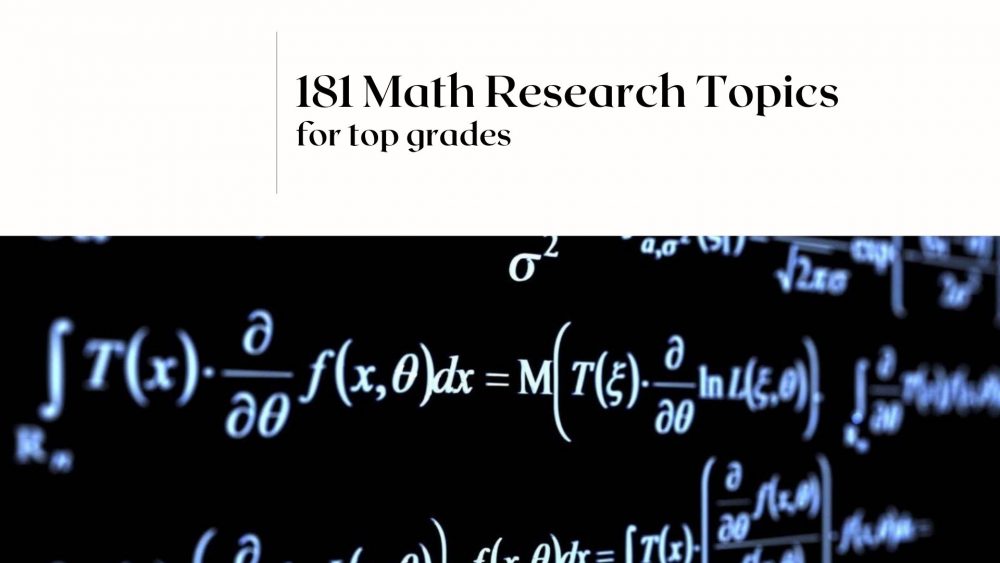
If you are reading this blog post, it means you are looking for some exceptional math research topics. You want them to be original, unique even. If you manage to find topics like this, you can be sure your professor will give you a top grade (if you write a decent paper, that is). The good news is that you have arrived at just the right place – at the right time. We have just finished updating our list of topics, so you will find plenty of original ideas right on this page. All our topics are 100 percent free to use as you see fit. You can reword them and you don’t need to give us any credit.
And remember: if you need assistance from a professional, don’t hesitate to reach out to us. We are not just the best place for math research topics for high school students; we are also the number one choice for students looking for top-notch research paper writing services.
Our Newest Research Topics in Math
We know you probably want the best and most recent research topics in math. You want your paper to stand out from all the rest. After all, this is the best way to get some bonus points from your professor. On top of this, finding some great topics for your next paper makes it easier for you to write the essay. As long as you know at least something about the topic, you’ll find that writing a great paper or buy phd thesis isn’t as difficult as you previously thought.
So, without further ado, here are the 181 brand new topics for your next math research paper:
Cool Math Topics to Research
Are you looking for some cool math topics to research? We have a list of original topics for your right here. Pick the one you like and start writing now:
- Roll two dice and calculate a probability
- Discuss ancient Greek mathematics
- Is math really important in school?
- Discuss the binomial theorem
- The math behind encryption
- Game theory and its real-life applications
- Analyze the Bernoulli scheme
- What are holomorphic functions and how do they work?
- Describe big numbers
- Solving the Tower of Hanoi problem
Undergraduate Math Research Topics
If you are an undergraduate looking for some research topics for your next math paper, you will surely appreciate our list of interesting undergraduate math research topics:
- Methods to count discrete objects
- The origins of Greek symbols in mathematics
- Methods to solve simultaneous equations
- Real-world applications of the theorem of Pythagoras
- Discuss the limits of diffusion
- Use math to analyze the abortion data in the UK over the last 100 years
- Discuss the Knot theory
- Analyze predictive models (take meteorology as an example)
- In-depth analysis of the Monte Carlo methods for inverse problems
- Squares vs. rectangles (compare and contrast)
Number Theory Topics to Research
Interested in writing about number theory? It is not an easy subject to discuss, we know. However, we are sure you will appreciate these number theory topics:
- Discuss the greatest common divisor
- Explain the extended Euclidean algorithm
- What are RSA numbers?
- Discuss Bézout’s lemma
- In-depth analysis of the square-free polynomial
- Discuss the Stern-Brocot tree
- Analyze Fermat’s little theorem
- What is a discrete logarithm?
- Gauss’s lemma in number theory
- Analyze the Pentagonal number theorem
Math Research Topics for High School
High school students shouldn’t be too worried about their math papers because we have some unique, and quite interesting, math research topics for high school right here:
- Discuss Brun’s constant
- An in-depth look at the Brahmagupta–Fibonacci identity
- What is derivative algebra?
- Describe the Symmetric Boolean function
- Discuss orders of approximation in limits
- Solving Regiomontanus’ angle maximization problem
- What is a Quadratic integral?
- Define and describe complementary angles
- Analyze the incircle and excircles of a triangle
- Analyze the Bolyai–Gerwien theorem in geometry
- Math in our everyday life
Complex Math Topics
If you want to give some complex math topics a try, we have the best examples below. Remember, these topics should only be attempted by students who are proficient in mathematics:
- Mathematics and its appliance in Artificial Intelligence
- Try to solve an unsolved problem in math
- Discuss Kolmogorov’s zero-one law
- What is a discrete random variable?
- Analyze the Hewitt–Savage zero-one law
- What is a transferable belief model?
- Discuss 3 major mathematical theorems
- Describe and analyze the Dempster-Shafer theory
- An in-depth analysis of a continuous stochastic process
- Identify and analyze Gauss-Markov processes
Easy Math Research Paper Topics
Perhaps you don’t want to spend too much time working on your next research paper. Who can blame you? Check out these easy math research paper topics:
- Define the hyperbola
- Do we need to use a calculator during math class?
- The binomial theorem and its real-world applications
- What is a parabola in geometry?
- How do you calculate the slope of a curve?
- Define the Jacobian matrix
- Solving matrix problems effectively
- Why do we need differential equations?
- Should math be mandatory in all schools?
- What is a Hessian matrix?
Logic Topics to Research
We have some interesting logical topics for research papers. These are perfect for students interested in writing about math logic. Pick one right now:
- Discuss the reductio ad absurdum approach
- Discuss Boolean algebra
- What is consistency proof?
- Analyze Trakhtenbrot’s theorem (the finite model theory)
- Discuss the Gödel completeness theorem
- An in-depth analysis of Morley’s categoricity theorem
- How does the Back-and-forth method work?
- Discuss the Ehrenfeucht–Fraïssé game technique
- Discuss Aleph numbers (Aleph-null and Aleph-one)
- Solving the Suslin problem
Algebra Topics for a Research Paper
Would you like to write about an algebra topic? No problem, our seasoned writers have compiled a list of the best algebra topics for a research paper:
- Discuss the differential equation
- Analyze the Jacobson density theorem
- The 4 properties of a binary operation in algebra
- Analyze the unary operator in depth
- Analyze the Abel–Ruffini theorem
- Epimorphisms vs. monomorphisms: compare and contrast
- Discuss the Morita duality in algebraic structures
- Idempotent vs. nilpotent in Ring theory
- Discuss the Artin-Wedderburn theorem
- What is a commutative ring in algebra?
- Analyze and describe the Noetherian ring
Math Education Research Topics
There is nothing wrong with writing about math education, especially if your professor did not give you writing prompts. Here are some very nice math education research topics:
- What are the goals a mathematics professor should have?
- What is math anxiety in the classroom?
- Teaching math in UK schools: the difficulties
- Computer programming or math in high school?
- Is math education in Europe at a high enough level?
- Common Core Standards and their effects on math education
- Culture and math education in Africa
- What is dyscalculia and how does it manifest itself?
- When was algebra first thought in schools?
- Math education in the United States versus the United Kingdom
Computability Theory Topics to Research
Writing about computability theory can be a very interesting adventure. Give it a try! Here are some of our most interesting computability theory topics to research:
- What is a multiplication table?
- Analyze the Scholz conjecture
- Explain exponentiating by squaring
- Analyze the Myhill-Nerode theorem
- What is a tree automaton?
- Compare and contrast the Pushdown automaton and the Büchi automaton
- Discuss the Markov algorithm
- What is a Turing machine?
- Analyze the post correspondence problem
- Discuss the linear speedup theorem
- Discuss the Boolean satisfiability problem
Interesting Math Research Topics
We know you want topics that are interesting and relatively easy to write about. This is why we have a separate list of our most interesting math research topics:
- What is two-element Boolean algebra?
- The life of Gauss
- The life of Isaac Newton
- What is an orthodiagonal quadrilateral?
- Tessellation in Euclidean plane geometry
- Describe a hyperboloid in 3D geometry
- What is a sphericon?
- Discuss the peculiarities of Borel’s paradox
- Analyze the De Finetti theorem in statistics
- What are Martingales?
- The basics of stochastic calculus
Applied Math Research Topics
Interested in writing about applied mathematics? Our team managed to create a list of awesome applied math research topics from scratch for you:
- Discuss Newton’s laws of motion
- Analyze the perpendicular axes rule
- How is a Galilean transformation done?
- The conservation of energy and its applications
- Discuss Liouville’s theorem in Hamiltonian mechanics
- Analyze the quantum field theory
- Discuss the main components of the Lorentz symmetry
- An in-depth look at the uncertainty principle
Geometry Topics for a Research Paper
Geometry can be a very captivating subject, especially when you know plenty about it. Check out our list of geometry topics for a research paper and pick the best one today:
- Most useful trigonometry functions in math
- The life of Archimedes and his achievements
- Trigonometry in computer graphics
- Using Vincenty’s formulae in geodesy
- Define and describe the Heronian tetrahedron
- The math behind the parabolic microphone
- Discuss the Japanese theorem for concyclic polygons
- Analyze Euler’s theorem in geometry
Math Research Topics for Middle School
Yes, even middle school children can write about mathematics. We have some original math research topics for middle school right here:
- Finding critical points in a graph
- The basics of calculus
- What makes a graph ultrahomogeneous?
- How do you calculate the area of different shapes?
- What contributions did Euclid have to the field of mathematics?
- What is Diophantine geometry?
- What makes a graph regular?
- Analyze a full binary tree
Math Research Topics for College Students
As you’ve probably already figured out, college students should pick topics that are a bit more complex. We have some of the best math research topics for college students right here:
- What are extremal problems and how do you solve them?
- Discuss an unsolvable math problem
- How can supercomputers solve complex mathematical problems?
- An in-depth analysis of fractals
- Discuss the Boruvka’s algorithm (related to the minimum spanning tree)
- Discuss the Lorentz–FitzGerald contraction hypothesis in relativity
- An in-depth look at Einstein’s field equation
- The math behind computer vision and object recognition
Calculus Topics for a Research Paper
Let’s face it: calculus is not a very difficult field. So, why don’t you pick one of our excellent calculus topics for a research paper and start writing your essay right away:
- When do we need to apply the L’Hôpital rule?
- Discuss the Leibniz integral rule
- Calculus in ancient Egypt
- Discuss and analyze linear approximations
- The applications of calculus in real life
- The many uses of Stokes’ theorem
- Discuss the Borel regular measure
- An in-depth analysis of Lebesgue’s monotone convergence theorem
Simple Math Research Paper Topics for High School
This is the place where you can find some pretty simple topics if you are a high school student. Check out our simple math research paper topics for high school:
- The life and work of the famous Pierre de Fermat
- What are limits and why are they useful in calculus?
- Explain the concept of congruency
- The life and work of the famous Jakob Bernoulli
- Analyze the rhombicosidodecahedron and its applications
- Calculus and the Egyptian pyramids
- The life and work of the famous Jean d’Alembert
- Discuss the hyperplane arrangement in combinatorial computational geometry
- The smallest enclosing sphere method in combinatorics
Business Math Topics
If you want to surprise your professor, why don’t you write about business math? We have some exceptional topics that nobody has thought about right here:
- Is paying a loan with another loan a good approach?
- Discuss the major causes of a stock market crash
- Best debt amortization methods in the US
- How do bank loans work in the UK?
- Calculating interest rates the easy way
- Discuss the pros and cons of annuities
- Basic business math skills everyone should possess
- Business math in United States schools
- Analyze the discount factor
Probability and Statistics Topics for Research
Probability and statistics are not easy fields. However, you can impress your professor with one of our unique probability and statistics topics for research:
- What is the autoregressive conditional duration?
- Applying the ANOVA method to ranks
- Discuss the practical applications of the Bates distribution
- Explain the principle of maximum entropy
- Discuss Skorokhod’s representation theorem in random variables
- What is the Factorial moment in the Theory of Probability?
- Compare and contrast Cochran’s C test and his Q test
- Analyze the De Moivre-Laplace theorem
- What is a negative probability?
Need Help With Research Paper?
We offer the absolute best high school and college research paper writing service on the Internet. When you need any kind of research paper help, our experienced ENL writers and professional editors are here to help. With years of experience under their belts, our experts can get your research paper done in as little as 3 hours.
Getting cheap online help with research papers has never been easier. College students should just get in touch with us and tell us what they need. We will assign them our most affordable and experienced math writer in minutes, even during the night. We are the best-rated online writing company on the Internet because we always deliver high-quality academic content at the most competitive prices. Give us a try today!
Leave a Reply Cancel reply
260 Interesting Math Topics for Essays & Research Papers
Mathematics is the science of numbers and shapes. Writing about it can give you a fresh perspective and help to clarify difficult concepts. You can even use mathematical writing as a tool in problem-solving.
In this article, you will find plenty of interesting math topics. Besides, you will learn about branches of mathematics that you can choose from. And if the thought of letters and numbers makes your head swim, try our custom writing service . Our professionals will craft a paper for you in no time!
And now, let’s proceed to math essay topics and tips.
🔝 Top 10 Interesting Math Topics
✅ branches of mathematics, ✨ fun math topics.
- 🏫 Math Topics for High School
- 🎓 College Math Topics
- 🤔 Advanced Math
- 📚 Math Research
- ✏️ Math Education
- 💵 Business Math
🔍 References
- Number theory in everyday life.
- Logicist definitions of mathematics.
- Multivariable vs. vector calculus.
- 4 conditions of functional analysis.
- Random variable in probability theory.
- How is math used in cryptography?
- The purpose of homological algebra.
- Concave vs. convex in geometry.
- The philosophical problem of foundations.
- Is numerical analysis useful for machine learning?
What exactly is mathematics ? First and foremost, it is very old. Ancient Greeks and Persians were already utilizing mathematical tools. Nowadays, we consider it an interdisciplinary language.
Biologists, linguists, and sociologists alike use math in their work. And not only that, we all deal with it in our daily lives. For instance, it manifests in the measurement of time. We often need it to calculate how much our groceries cost and how much paint we need to buy to cover a wall.

Simply put, mathematics is a universal instrument for problem-solving. We can divide pure math into three branches: geometry, arithmetic, and algebra. Let’s take a closer look:
- Geometry By studying geometry, we try to comprehend our physical surroundings. Geometric shapes can be simple, like a triangle. Or, they can form complicated figures, like a rhombicosidodecahedron.
- Arithmetic Arithmetic deals with numbers and simple operations: subtraction, addition, division, and multiplication.
- Algebra Algebra is used when the exact numbers are unclear. Instead, they are replaced with letters. Businesses often need algebra to predict their sales.
It’s true that most high school students don’t like math. However, that doesn’t mean it can’t be a fun and compelling subject. In the following section, you will find plenty of enthralling mathematical topics for your paper.
If you’re struggling to start working on your essay, we have some fun and cool math topics to offer. They will definitely engage you and make the writing process enjoyable. Besides, fun math topics can show everyone that even math can be entertaining or even a bit silly.
- The link between mathematics and art – analyzing the Golden Ratio in Renaissance-era paintings.
- An evaluation of Georg Cantor’s set theory.
- The best approaches to learning math facts and developing number sense.
- Different approaches to probability as explored through analyzing card tricks.
- Chess and checkers – the use of mathematics in recreational activities.
- The five types of math used in computer science.
- Real-life applications of the Pythagorean Theorem .
- A study of the different theories of mathematical logic.
- The use of game theory in social science.
- Mathematical definitions of infinity and how to measure it.
- What is the logic behind unsolvable math problems?
- An explanation of mean, mode, and median using classroom math grades.
- The properties and geometry of a Möbius strip.
- Using truth tables to present the logical validity of a propositional expression.
- The relationship between Pascal’s Triangle and The Binomial Theorem.
- The use of different number types: the history.
- The application of differential geometry in modern architecture.
- A mathematical approach to the solution of a Rubik’s Cube.
- Comparison of predictive and prescriptive statistical analyses.
- Explaining the iterations of the Koch snowflake.
- The importance of limits in calculus.
- Hexagons as the most balanced shape in the universe.
- The emergence of patterns in chaos theory.
- What were Euclid’s contributions to the field of mathematics?
- The difference between universal algebra and abstract algebra.
🏫 Math Essay Topics for High School
When writing a math paper, you want to demonstrate that you understand a concept. It can be helpful if you need to prepare for an exam. Choose a topic from this section and decide what you want to discuss.
- Explain what we need Pythagoras’ theorem for.
- What is a hyperbola?
- Describe the difference between algebra and arithmetic.
- When is it unnecessary to use a calculator ?
- Find a connection between math and the arts.
- How do you solve a linear equation?
- Discuss how to determine the probability of rolling two dice.
- Is there a link between philosophy and math?
- What types of math do you use in your everyday life?
- What is the numerical data?
- Explain how to use the binomial theorem.
- What is the distributive property of multiplication?
- Discuss the major concepts in ancient Egyptian mathematics .
- Why do so many students dislike math?
- Should math be required in school?
- How do you do an equivalent transformation?
- Why do we need imaginary numbers?
- How can you calculate the slope of a curve?
- What is the difference between sine, cosine, and tangent?
- How do you define the cross product of two vectors?
- What do we use differential equations for?
- Investigate how to calculate the mean value.
- Define linear growth.
- Give examples of different number types.
- How can you solve a matrix?
🎓 College Math Topics for a Paper
Sometimes you need more than just formulas to explain a complex idea. That’s why knowing how to express yourself is crucial. It is especially true for college-level mathematics. Consider the following ideas for your next research project:
- What do we need n-dimensional spaces for?
- Explain how card counting works.
- Discuss the difference between a discrete and a continuous probability distribution .
- How does encryption work?
- Describe extremal problems in discrete geometry.
- What can make a math problem unsolvable?
- Examine the topology of a Möbius strip.

- What is K-theory?
- Discuss the core problems of computational geometry.
- Explain the use of set theory .
- What do we need Boolean functions for?
- Describe the main topological concepts in modern mathematics.
- Investigate the properties of a rotation matrix.
- Analyze the practical applications of game theory.
- How can you solve a Rubik’s cube mathematically?
- Explain the math behind the Koch snowflake.
- Describe the paradox of Gabriel’s Horn.
- How do fractals form?
- Find a way to solve Sudoku using math.
- Why is the Riemann hypothesis still unsolved?
- Discuss the Millennium Prize Problems.
- How can you divide complex numbers?
- Analyze the degrees in polynomial functions.
- What are the most important concepts in number theory?
- Compare the different types of statistical methods.
🤔 Advanced Topics in Math to Write a Paper on
Once you have passed the trials of basic math, you can move on to the advanced section. This area includes topology, combinatorics, logic, and computational mathematics. Check out the list below for enticing topics to write about:
- What is an abelian group?
- Explain the orbit-stabilizer theorem.
- Discuss what makes the Burnside problem influential.
- What fundamental properties do holomorphic functions have?
- How does Cauchy’s integral theorem lead to Cauchy’s integral formula?
- How do the two Picard theorems relate to each other?
- When is a trigonometric series called a Fourier series?
- Give an example of an algorithm used for machine learning.
- Compare the different types of knapsack problems.
- What is the minimum overlap problem?
- Describe the Bernoulli scheme.
- Give a formal definition of the Chinese restaurant process.
- Discuss the logistic map in relation to chaos.
- What do we need the Feigenbaum constants for?
- Define a difference equation.
- Explain the uses of the Fibonacci sequence.
- What is an oblivious transfer?
- Compare the Riemann and the Ruelle zeta functions.
- How can you use elementary embeddings in model theory?
- Analyze the problem with the wholeness axiom and Kunen’s inconsistency theorem.
- How is Lie algebra used in physics ?
- Define various cases of algebraic cycles.
- Why do we need étale cohomology groups to calculate algebraic curves?
- What does non-Euclidean geometry consist of?
- How can two lines be ultraparallel?
📚 Math Research Topics for a Paper
Choosing the right topic is crucial for a successful research paper in math. It should be hard enough to be compelling, but not exceeding your level of competence. If possible, stick to your area of knowledge. This way your task will become more manageable. Here are some ideas:
- Write about the history of calculus.
- Why are unsolved math problems significant?
- Find reasons for the gender gap in math students.
- What are the toughest mathematical questions asked today?
- Examine the notion of operator spaces.
- How can we design a train schedule for a whole country?
- What makes a number big?
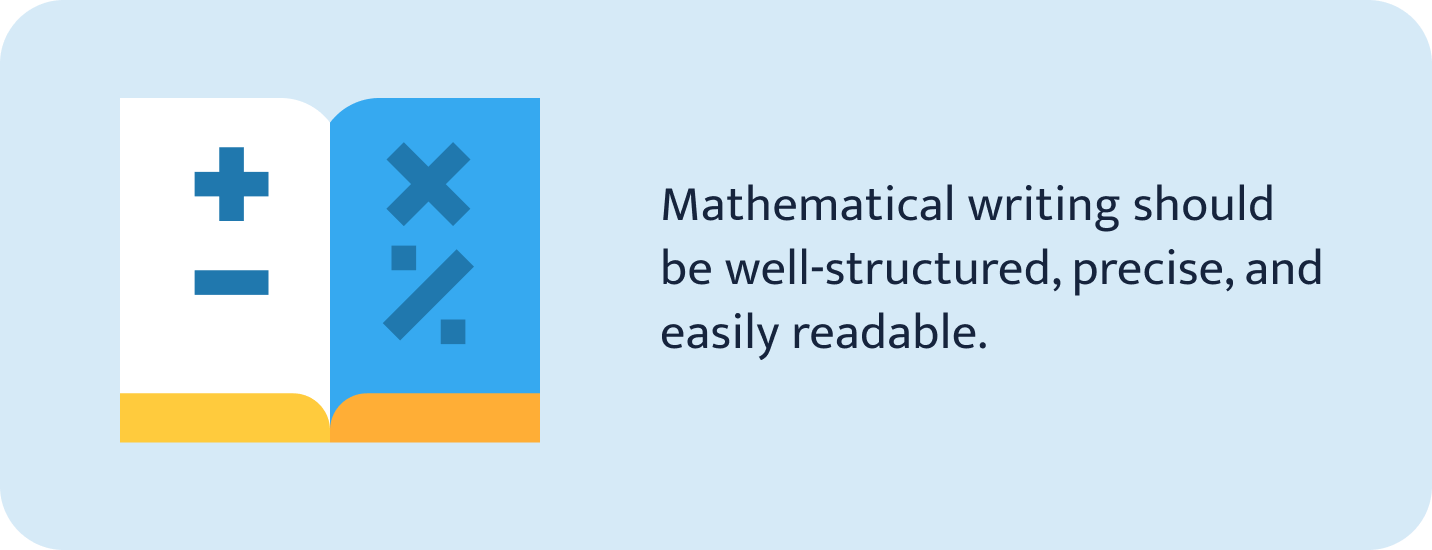
- How can infinities have various sizes?
- What is the best mathematical strategy to win a game of Go?
- Analyze natural occurrences of random walks in biology.
- Explain what kind of mathematics was used in ancient Persia.
- Discuss how the Iwasawa theory relates to modular forms.
- What role do prime numbers play in encryption?
- How did the study of mathematics evolve?
- Investigate the different Tower of Hanoi solutions.
- Research Napier’s bones. How can you use them?
- What is the best mathematical way to find someone who is lost in a maze?
- Examine the Traveling Salesman Problem. Can you find a new strategy?
- Describe how barcodes function.
- Study some real-life examples of chaos theory. How do you define them mathematically?
- Compare the impact of various ground-breaking mathematical equations .
- Research the Seven Bridges of Königsberg. Relate the problem to the city of your choice.
- Discuss Fisher’s fundamental theorem of natural selection.
- How does quantum computing work?
- Pick an unsolved math problem and say what makes it so difficult.
✏️ Math Education Research Topics
For many teachers, the hardest part is to keep the students interested. When it comes to math, it can be especially challenging. It’s crucial to make complicated concepts easy to understand. That’s why we need research on math education.
- Compare traditional methods of teaching math with unconventional ones.
- How can you improve mathematical education in the U.S.?
- Describe ways of encouraging girls to pursue careers in STEM fields.
- Should computer programming be taught in high school?
- Define the goals of mathematics education .
- Research how to make math more accessible to students with learning disabilities .
- At what age should children begin to practice simple equations?
- Investigate the effectiveness of gamification in algebra classes.
- What do students gain from taking part in mathematics competitions?
- What are the benefits of moving away from standardized testing ?
- Describe the causes of “ math anxiety .” How can you overcome it?
- Explain the social and political relevance of mathematics education.
- Define the most significant issues in public school math teaching.
- What is the best way to get children interested in geometry?
- How can students hone their mathematical thinking outside the classroom?
- Discuss the benefits of using technology in math class.
- In what way does culture influence your mathematical education?
- Explore the history of teaching algebra.
- Compare math education in various countries.

- How does dyscalculia affect a student’s daily life?
- Into which school subjects can math be integrated?
- Has a mathematics degree increased in value over the last few years?
- What are the disadvantages of the Common Core Standards?
- What are the advantages of following an integrated curriculum in math?
- Discuss the benefits of Mathcamp.
🧮 Algebra Topics for a Paper
The elegance of algebra stems from its simplicity. It gives us the ability to express complex problems in short equations. The world was changed forever when Einstein wrote down the simple formula E=mc². Now, if your algebra seminar requires you to write a paper, look no further! Here are some brilliant prompts:
- Give an example of an induction proof.
- What are F-algebras used for?
- What are number problems?
- Show the importance of abstract algebraic thinking .
- Investigate the peculiarities of Fermat’s last theorem.
- What are the essentials of Boolean algebra?
- Explore the relationship between algebra and geometry.
- Compare the differences between commutative and noncommutative algebra.
- Why is Brun’s constant relevant?
- How do you factor quadratics?
- Explain Descartes’ Rule of Signs.
- What is the quadratic formula?
- Compare the four types of sequences and define them.
- Explain how partial fractions work.
- What are logarithms used for?
- Describe the Gaussian elimination.
- What does Cramer’s rule state?
- Explore the difference between eigenvectors and eigenvalues.
- Analyze the Gram-Schmidt process in two dimensions.
- Explain what is meant by “range” and “domain” in algebra.
- What can you do with determinants?
- Learn about the origin of the distance formula.
- Find the best way to solve math word problems.
- Compare the relationships between different systems of equations.
- Explore how the Rubik’s cube relates to group theory.
📏 Geometry Topics for a Research Paper
Shapes and space are the two staples of geometry. Since its appearance in ancient times, it has evolved into a major field of study. Geometry’s most recent addition, topology, explores what happens to an object if you stretch, shrink, and fold it. Things can get pretty crazy from here! The following list contains 25 interesting geometry topics:
- What are the Archimedean solids?
- Find real-life uses for a rhombicosidodecahedron.
- What is studied in projective geometry?
- Compare the most common types of transformations.
- Explain how acute square triangulation works.
- Discuss the Borromean ring configuration.
- Investigate the solutions to Buffon’s needle problem.
- What is unique about right triangles?

- Describe the notion of Dirac manifolds.
- Compare the various relationships between lines.
- What is the Klein bottle?
- How does geometry translate into other disciplines, such as chemistry and physics?
- Explore Riemannian manifolds in Euclidean space.
- How can you prove the angle bisector theorem?
- Do a research on M.C. Escher’s use of geometry.
- Find applications for the golden ratio .
- Describe the importance of circles.
- Investigate what the ancient Greeks knew about geometry.
- What does congruency mean?
- Study the uses of Euler’s formula.
- How do CT scans relate to geometry?
- Why do we need n-dimensional vectors?
- How can you solve Heesch’s problem?
- What are hypercubes?
- Analyze the use of geometry in Picasso’s paintings.
➗ Calculus Topics to Write a Paper on
You can describe calculus as a more complicated algebra. It’s a study of change over time that provides useful insights into everyday problems. Applied calculus is required in a variety of fields such as sociology, engineering, or business. Consult this list of compelling topics on a calculus paper:
- What are the differences between trigonometry, algebra, and calculus?
- Explain the concept of limits.
- Describe the standard formulas needed for derivatives.
- How can you find critical points in a graph?
- Evaluate the application of L’Hôpital’s rule.
- How do you define the area between curves?
- What is the foundation of calculus?
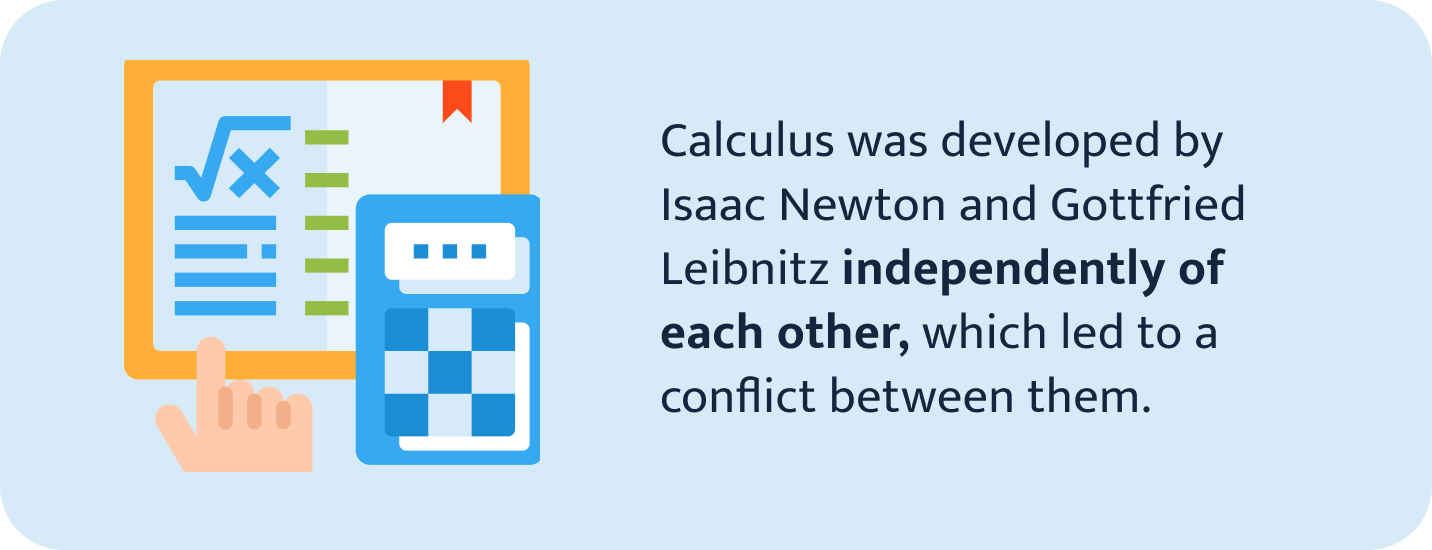
- How does multivariate calculus work?
- Discuss the use of Stokes’ theorem.
- What does Leibniz’s integral rule state?
- What is the Itô stochastic integral?
- Explore the influence of nonstandard analysis on probability theory.
- Research the origins of calculus.
- Who was Maria Gaetana Agnesi?
- Define a continuous function.
- What is the fundamental theorem of calculus?
- How do you calculate the Taylor series of a function?
- Discuss the ways to resolve Runge’s phenomenon.
- Explain the extreme value theorem.
- What do we need predicate calculus for?
- What are linear approximations?
- When does an integral become improper?
- Describe the Ratio and Root Tests.
- How does the method of rings work?
- Where do we apply calculus in real-life situations?
💵 Business Math Topics to Write About
You don’t have to own a company to appreciate business math. Its topics range from credits and loans to insurance, taxes, and investment. Even if you’re not a mathematician, you can use it to handle your finances. Sounds interesting? Then have a look at the following list:
- What are the essential skills needed for business math?
- How do you calculate interest rates?
- Compare business and consumer math.
- What is a discount factor?
- How do you know that an investment is reasonable?
- When does it make sense to pay a loan with another loan?
- Find useful financing techniques that everyone can use.
- How does critical path analysis work?
- Explain how loans work.
- Which areas of work utilize operations research?
- How do businesses use statistics?
- What is the economic lot scheduling problem?
- Compare the uses of different chart types.
- What causes a stock market crash?
- How can you calculate the net present value?
- Explore the history of revenue management.
- When do you use multi-period models?
- Explain the consequences of depreciation.
- Are annuities a good investment?
- Would the U.S. financially benefit from discontinuing the penny?
- What caused the United States housing crash in 2008?
- How do you calculate sales tax?
- Describe the notions of markups and markdowns.
- Investigate the math behind debt amortization.
- What is the difference between a loan and a mortgage?
With all these ideas, you are perfectly equipped for your next math paper. Good luck!
- What Is Calculus?: Southern State Community College
- What Is Mathematics?: Tennessee Tech University
- What Is Geometry?: University of Waterloo
- What Is Algebra?: BBC
- Ten Simple Rules for Mathematical Writing: Ohio State University
- Practical Algebra Lessons: Purplemath
- Topics in Geometry: Massachusetts Institute of Technology
- The Geometry Junkyard: All Topics: Donald Bren School of Information and Computer Sciences
- Calculus I: Lamar University
- Business Math for Financial Management: The Balance Small Business
- What Is Mathematics: Life Science
- What Is Mathematics Education?: University of California, Berkeley
- Share to Facebook
- Share to Twitter
- Share to LinkedIn
- Share to email

Cause and effect essays examine how an event happened and what consequences it had. Gaining weight after eating lots of fast food is an example of a cause-and-effect relationship. Possible topics cover a variety of subjects ranging from mental health to history and politics. This article gives you an outline...

An analysis essay aims to break down the subject in order to understand it. You can choose to analyze a text, a process, or an idea. This article will help you write a great essay! Selecting an interesting topic makes writing a lot easier. We’ve prepared a list of excellent...

Everybody knows that being healthy requires effort. We should exercise regularly and maintain a balanced diet. However, the reward is worth it. A healthy lifestyle prevents chronic illnesses and leads to better body performance. Besides, if you improve your physical well-being, your mental health will strengthen as well! In this...

Environment affects us all, whether we want it or not. Political leaders and students alike discuss ways to tackle environmental topics & issues. Some might argue about the role humans play in all this. The fact remains that our environment is a delicate matter. That’s why we must educate ourselves...

Our code of ethics is derived from what we think is right or wrong. On top of that, we have to agree to the moral standards established by the society we live in. Conventional norms generally label theft, murder, or harassment as bad. However, there are many influences that impact...

A definition explains the meaning of a term or a concept. In a dictionary, you’ll find a definition in a single sentence. A definition paper, however, encompasses several paragraphs. Such an essay, amongst other things, can include personal experience and examples. To write a successful definition paper, you need to...

As simple as it is, the purpose of the descriptive essay is to explain or portray its subject. It can focus on any topic or issue you want to write about. Be sure that any middle school, high school, or college student can manage this type of creative writing assignment!...

Rhetorical analysis essay focuses on assessing the method used for delivering a message. This assignment isn’t about giving an opinion on the topic. The purpose is to analyze how the author presents the argument and whether or not they succeeded. Keep reading to find out more strategies and prompts for...

A narrative essay tells a story about a series of events. At the core of this kind of essay can be a personal experience or a fictional plot. Any story can be a basis for a narrative essay! Narratives can look similar to descriptions. Still, they are different. A descriptive...

Similar to the instructions in a recipe book, process essays convey information in a step-by-step format. In this type of paper, you follow a structured chronological process. You can also call it a how-to essay. A closely related type is a process analysis essay. Here you have to carefully consider...

In a classification essay, you divide the subject into categories. To create these categories, you single out certain attributes of things. You can classify them according to their characteristics, themes, or traits. Sounds complicated? Be sure that any high school or college student can manage this type of essay!

Throughout your high school years, you are likely to write many evaluative papers. In an evaluation essay you aim is to justify your point of view through evidence.
I need a writer on algebra. I am a PhD student.Can i be helped by anybody/expert?
Please I want to do my MPhil research on algebra if you can help me
shall your university help me on research in mathematics ?
how I get the full pdf of those tittles
Print as pdf.

- Services Paper editing services Paper proofreading Business papers Philosophy papers Write my paper Term papers for sale Term paper help Academic term papers Buy research papers College writing services Paper writing help Student papers Original term papers Research paper help Nursing papers for sale Psychology papers Economics papers Medical papers Blog

166 Extraordinary Math Research Topics For Your Papers
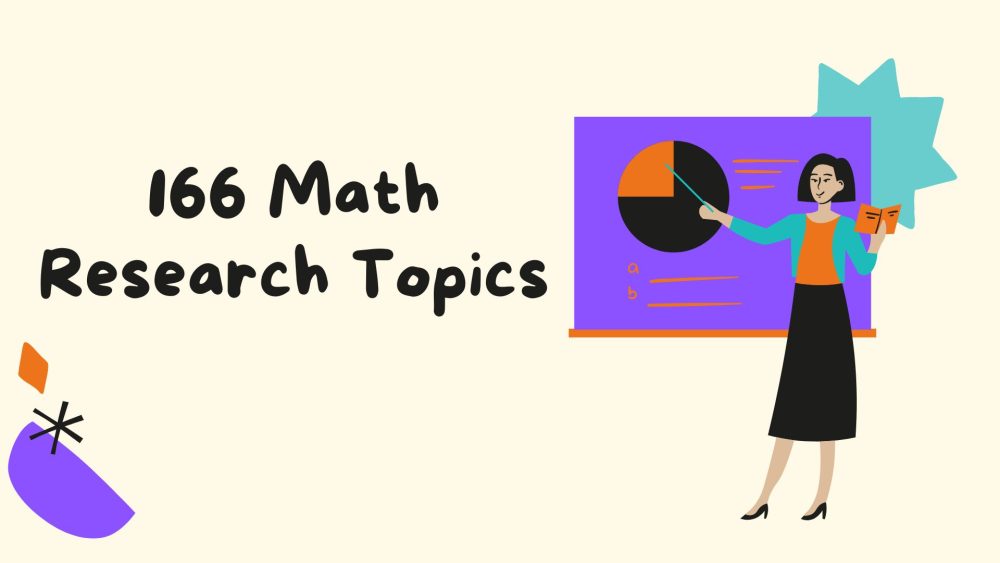
Math research topics cover various genres from which students can choose. Many people think that a research project on a math topic is dull. However, mathematics can be a wonderful and vivid field. Since it’s a universal language, mathematics can describe anything and everything, from galaxies that orbit each other to music. However, the broad nature of this study field also makes selecting a research paper difficult. That’s because learners want to pick interesting topics that will impress educators to award them top scores. This article lists the best math research paper topics. It’s useful because it inspires students to select or customize topics for their academic essays without much struggle.
What Are The Different Types Of Math?
As hinted, math covers several genres. Here are the primary types of mathematics:
Geometry: It’s a math branch that deals with the shapes, size, and relative position of figures. Many people consider geometry a practical math branch because it examines figures, shapes, sizes, and features of various entities, including parts like solids, lines, surfaces, lines, and angles. Algebra: It assists in solving equations and manipulating symbols. This branch helps students represent unknown quantities with alphabets and use them alongside numbers. Calculus: This area is vital in determining rates of change, such as velocity and acceleration. Arithmetic: Arithmetic is the most common and oldest math branch, encompassing basis number operations. These operations include subtraction, addition, divisions, and multiplications, and some schools shorten it as BODMAS. Statistics and Probability: They help analyze numerical data to make predictions. Probability is about chances, while statistics entails handling different data using various techniques. Trigonometry: It assists in calculating angles and distances between points. It mainly deals with triangles’ relationships, sides, and curves.
Now that you understand the types of mathematics, it’s easier to select a suitable research topic. The following are some of the best topic ideas in math.
Undergraduate Math Research Topics
Maybe you’re pursuing your undergraduate studies. However, you have challenges comprehending math topics, yet the professor expects you to write a superior paper. In that case, here’s a list of engaging research topics in math to consider for your essays.
- An in-depth comprehension of the meaning of discrete random variables in math and their identification
- Math evolution- Comprehending the Gauss-Markov
- Primary math theorems- Investigating how they work
- Continuous stochastic process- Exploring its role in the math process
- Analyzing the Dempster-Shafer theory
- The application of the transferable belief model
- Exploring the use of math in artificial intelligence
- The application of mathematics in daily life
- Algebra and its history
- Math and culture- What’s the relationship?
- How drawing and painting could help with mathematics
- Ways to boost math interest among learners
- The social and political significance of learning mathematics
- Circles and their relevance in mathematics
- Challenges to math learning in public schools
- Prove the use of F-Algebras
- Understanding the meaning of abstract algebra
- Discuss geometry and algebra
- How acute square triangulation works
- Discuss the essence of right triangles
- Why non-Euclidean geometry should be compulsory for math students
- Investigating number problems
- Discuss the meaning of Dirac manifolds
- How geometry influences chemistry and physics
- Riemannian manifolds’ application in the Euclidean space
These are exciting math topics for undergraduate students. Nevertheless, prepare adequate time and resources to investigate any of these titles to draft a winning essay. You might have to provide theoretical and practical assessments when writing your essay.
Math Research Topics for High School Learners
Maybe your high school teacher asked you to write a research paper. Choosing a familiar topic is an excellent way to get a high grade. Here are some of the best math research paper topics for high school.
- How to draw a chart representing the financial analysis of a prominent company over the last five years
- How to solve a matrix- The vital principles and formulas to embrace
- Exploring various techniques for solving finance and mathematical gaps
- Discount factor- Why it’s crucial for learners and ways to achieve it
- Calculating the interest rate and its essence in the banking industry
- Why imaginary numbers are important
- Investigating the application of math in the workplace
- Explain why learners hate mathematics teachers
- What makes math a complex subject?
- Is making math compulsory in high school a good thing?
- How to solve a dice question from a probability perspective
- Understanding the Binomial theorem and its essence
- Investigating Egyptian mathematics
- Hyperbola- Understanding it and its use in math
- When should students use calculators in class?
- How to solve linear equations
- Is the Pythagoras theorem important in math?
- The interdependence between math and art
- Philosophy’s role in math
- Numerical data overview
High school learners can pick any of these titles and develop them into an essay. Nevertheless, they should prepare to spend some time investigating their topics to write pieces that will impress their educators. Titles that address math history and its influence on education can also suit high school students. However, learners should select titles that fulfil the academic requirements set by the educators.
Applied Math Research Topics
As a branch, applied math deals with mathematical methods and their real-life applications. These methods are manifest in engineering, finance, medicine, biology, physics, and others. Here are some of the exciting topics in this field.
- Dimensions for examining fingerprints
- Computer tomography and its significance
- Step-stress modelling- What is its importance?
- Explain the essence of data mining- How does it benefit the banking sector?
- A detailed examination of nonlinear models
- How genes discovery helps determine unhealthy and healthy patients
- Algorithms and their role in probabilistic modelling
- Mathematicians and their importance in robots’ development
- Mathematicians’ role in crime prevention and data analysis
- The essence of Law of Motion by Isaac in real life
- The importance of math in energy conservation
- Math and its role in quantum theory
- Analyzing the Lorentz symmetry features
- Evaluating the processing of the statistical signal in detail
- Explain the achievement of Galilean Transformation
These are exciting ideas to explore when writing a research paper in applied math. Nevertheless, take your time to carefully and extensively research your preferred title to write a high-quality essay. Students should also note that some topics in this category require specialized knowledge to write superior papers.
It’s a challenge to write a paper for a high grade. Sometimes every student need a professional help with college paper writing. Therefore, don’t be afraid to hire a writer to complete your assignment. Just write a message “Please, write custom research paper for me” and get time to relax. Contact us today and get a 100% original paper.
Interesting Math Research Topics
Maybe you’re among the learners that prefer working with exciting ideas. In that case, this category has topics that will interest you.
- The uses of numerical analysis in machine learning
- Foundations and philosophical problems
- Convex versus Concave in geometry
- Homological algebra- What is its purpose?
- Is math useful in cryptography
- Probability theory and random variable
- Functional analysis- What are its four conditions?
- Vector calculus versus multivariable
- Mathematics and logicist definitions
- Ways to apply the number theory in daily life
- Studying complex math equations
- How to calculate mode, median, and mean
- Understanding the meaning of the Scholz conjecture
- The definition of the past correspondence problem
- Computational maths- What are its classes?
- Multiplication table and its importance
- What the Boolean satisfiability problem means for a learner
- Understanding the linear speedup theory in mathematics
- The Turing machine description
- Understanding the Markov algorithm
- Investigating the similarities and differences between Buchi automation and Pushdown automation
- What is the meaning of Tree automation?
- Describing the enclosing sphere method and its use in combinations
- Egyptian pyramids and calculus
- Analyzing De Finetti theorem in statistics and probability
- Examining the congruence meaning in math
- Application and purpose of calculus in the banking industry
- Jean d’Alembert’s most famous works
- Boolean algebra- What are its essential elements
- Isaac Newton- His contribution, life, and time in math
- Understanding the meaning of Sphericon
- What is the purpose of Martingales?
- Gauss times, energy, and contributions to math
- Jakob Bernoulli- Exploring his famous works
- A brief history of math
Some learners think writing a math essay is complex and tedious. However, you can find a topic you will enjoy working with throughout the project. These are exciting ideas to explore in research papers. However, prepare to spend sufficient time investigating your chosen title to write a winning paper, although these are generally relaxing titles for math papers and essays.
Math Research Topics for Middle School
Some middle school students worry about the math topics for their research. However, they can choose unique titles that will impress their teachers. Here are some of these ideas.
- The impacts of standard exam curriculum on math education
- Why is learning math so tricky?
- What is the meaning of the commutative ring in algebra?
- The Artin-Wedderburn theorem and its meaning
- How monopolists and epimorphisms differ
- Understanding the Jacobson density theorem
- How linear approximations work
- Root and ratio test definition
- Statistics role in business
- Economic lot scheduling- What does it mean?
- Causes of the stock market crash
- How many traders contribute to the New York Stock Exchange
- The history of revenue management
- Financial signs of an excellent investment
- Depreciation and its odds
- How a poor currency can benefit a country
- How math helps with debt amortization
- Ways to calculate a person’s net worth
- Distinctions in algebra, trigonometry, and calculus
- Discussing the beginning of calculus
- The essence of stochastic in math
- The meaning of limits in math
- Ways to identify a critical point in a graph
- Nonstandard analysis- What does it mean in the probability theory?
- Continuous function description and meaning
- Calculus- What are its primary principles?
- Pythagoras theorem- What are its central tenets?
- Calculus applications in finance
- Theorem value in math
- The application of linear approximations
This list has some of the best titles for middle school learners. But they also require some research to write superior essays. However, finding information on such topics is relatively easy, making them suitable for middle school students.
Math Research Topics for College Students
Maybe you’re pursuing college studies and need a title for a math research paper. In that case, here are exciting titles to consider for your essay.
- What is the purpose of n-dimensional spaces?
- Card counting- How does it work?
- How continuous probability and discrete distribution differ
- Understanding encryption- How Does it work?
- Extremal problems- Investigating them in discrete geometry
- The Mobius strip- Examining the topology
- Why can a math problem be unsolvable?
- Comparing different statistical methods
- Explain the vital number theory concepts
- Analyzing the polynomial functions’ degrees
- Ways to divide complex numbers
- Describe the prize problems with the millennium
- The reasons for the unsolved Riemann hypothesis
- Methods of solving Sudoku with math
- Explain the fractals formation
- Describe the evolution of math
- Explore different types of Tower of Hanoi solutions
- Discuss the uses of Napier’s bones
- With examples, explain the chaos theory
- Why are mathematical equations important all the time?
- Fisher’s fundamental theorem and natural selection- Why are they important?
College professors expect students to draft papers with relevant and valuable information. These are relevant titles for college students. However, they require extensive research to write winning papers.
Cool Math Topics to Research
Maybe you don’t need a complex topic for your research paper. In that case, consider any of these ideas for your essay. If you have a problem writing even with these topics and you’re thinking: “solve my math for me,” you can always reach out to our service.
- How contemporary architectural designs use geometry
- What makes some math equations complex?
- Ways to solve the Rubik’s cube
- Discuss the meaning of prescriptive statistical and predictive analysis
- Understanding the purpose of the chaos theory
- What limits calculus?- Provide relevant examples
- A comparison of universal and abstract algebra- How do they differ?
- The relationship between probability and card tricks
- Pascal’s Triangle- What does it mean?
- Mobius strip- What are its features in geometry?
- Multiple probability ideas- A brief overview
- Discuss the meaning of the Golden Ration in Renaissance period paintings
- How checkers and chess matter in understanding mathematics
- Ways to measure infinity
- Evaluating the Georg Contor theory
- Are hexagons the most balanced shapes in the world?
- The Koch snowflake- Explain the iterations
- The history of various number types and their use
- Game theory use in social science
- Five math types with significant benefits in computer science
These are some of the most excellent math education research topics. However, they also require extensive research to write high-quality papers.
Enlist the Best College Research Paper Writing Service
Perhaps, you have a topic for your paper but not the time to write a winning piece. Maybe you’re not confident in your research, analytical, and writing skills. Thus, you’re unsure that you can write an essay that will compel your educator to award you the highest grade in your class. Well, you’re not the only one. Many students seek cheap research papers due to varied reasons. Whether it’s limited time and resources or a lack of the necessary skills and experience in academic paper writing, our crew can help you. We offer affordable college paper writing services and help in various math branches. Our experts can assist you if you need help with math research topics for high school students, college, or undergraduates. We are a professional team with a reputation for providing the best-rated academic writing assistance. Whether in university, college, or high school, our crew will offer the service you need to excel academically. Contact us now for cheap and reliable help with your academic essays.
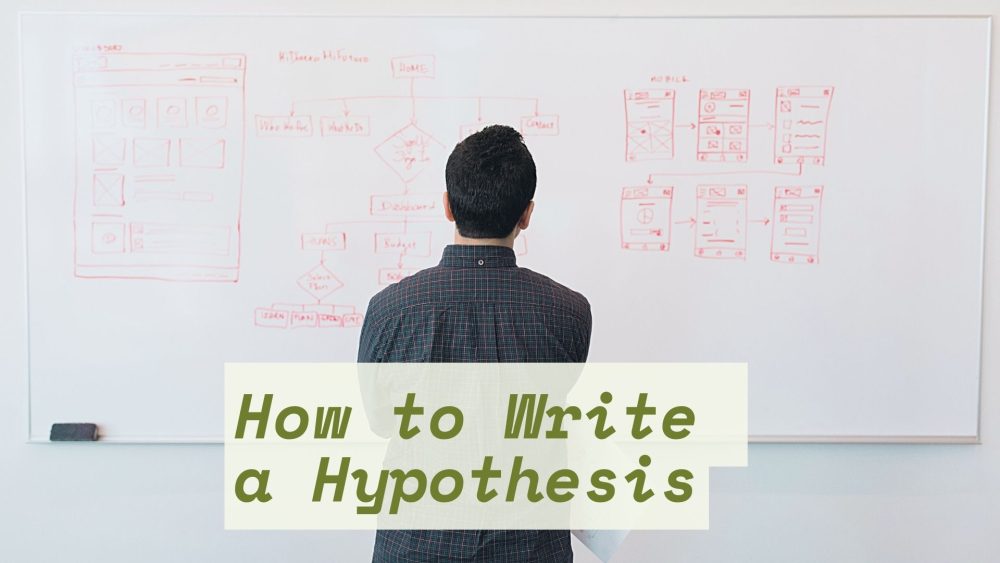
Leave a Reply Cancel reply
Your email address will not be published. Required fields are marked *
Save my name, email, and website in this browser for the next time I comment.
Terms & Conditions Loyalty Program Privacy Policy Money-Back Policy
Copyright © 2013-2024 MyPaperDone.com

Home > College of Natural Sciences > Mathematics > Mathematics Theses, Projects, and Dissertations
Mathematics Theses, Projects, and Dissertations
Theses/projects/dissertations from 2024 2024.
On Cheeger Constants of Knots , Robert Lattimer
Information Based Approach for Detecting Change Points in Inverse Gaussian Model with Applications , Alexis Anne Wallace
Theses/Projects/Dissertations from 2023 2023
DNA SELF-ASSEMBLY OF TRAPEZOHEDRAL GRAPHS , Hytham Abdelkarim
An Exposition of the Curvature of Warped Product Manifolds , Angelina Bisson
Jackknife Empirical Likelihood Tests for Equality of Generalized Lorenz Curves , Anton Butenko
MATHEMATICS BEHIND MACHINE LEARNING , Rim Hammoud
Statistical Analysis of Health Habits for Incoming College Students , Wendy Isamara Lizarraga Noriega
Reverse Mathematics of Ramsey's Theorem , Nikolay Maslov
Distance Correlation Based Feature Selection in Random Forest , Jose Munoz-Lopez
Constructing Hyperbolic Polygons in the Poincaré Disk , Akram Zakaria Samweil
KNOT EQUIVALENCE , Jacob Trubey
Theses/Projects/Dissertations from 2022 2022
SYMMETRIC GENERATIONS AND AN ALGORITHM TO PROVE RELATIONS , Diddier Andrade
The Examination of the Arithmetic Surface (3, 5) Over Q , Rachel J. Arguelles
Error Terms for the Trapezoid, Midpoint, and Simpson's Rules , Jessica E. Coen
de Rham Cohomology, Homotopy Invariance and the Mayer-Vietoris Sequence , Stacey Elizabeth Cox
Symmetric Generation , Ana Gonzalez
SYMMETRIC PRESENTATIONS OF FINITE GROUPS AND RELATED TOPICS , Samar Mikhail Kasouha
Simple Groups and Related Topics , Simrandeep Kaur
Homomorphic Images and Related Topics , Alejandro Martinez
LATTICE REDUCTION ALGORITHMS , Juan Ortega
THE DECOMPOSITION OF THE SPACE OF ALGEBRAIC CURVATURE TENSORS , Katelyn Sage Risinger
Verifying Sudoku Puzzles , Chelsea Schweer
AN EXPOSITION OF ELLIPTIC CURVE CRYPTOGRAPHY , Travis Severns
Theses/Projects/Dissertations from 2021 2021
Non-Abelian Finite Simple Groups as Homomorphic Images , Sandra Bahena
Matroids Determinable by Two Partial Representations , Aurora Calderon Dojaquez
SYMMETRIC REPRESENTATIONS OF FINITE GROUPS AND RELATED TOPICS , Connie Corona
Symmetric Presentation of Finite Groups, and Related Topics , Marina Michelle Duchesne
MEASURE AND INTEGRATION , JeongHwan Lee
A Study in Applications of Continued Fractions , Karen Lynn Parrish
Partial Representations for Ternary Matroids , Ebony Perez
Theses/Projects/Dissertations from 2020 2020
Sum of Cubes of the First n Integers , Obiamaka L. Agu
Permutation and Monomial Progenitors , Crystal Diaz
Tile Based Self-Assembly of the Rook's Graph , Ernesto Gonzalez
Research In Short Term Actuarial Modeling , Elijah Howells
Hyperbolic Triangle Groups , Sergey Katykhin
Exploring Matroid Minors , Jonathan Lara Tejeda
DNA COMPLEXES OF ONE BOND-EDGE TYPE , Andrew Tyler Lavengood-Ryan
Modeling the Spread of Measles , Alexandria Le Beau
Symmetric Presentations and Related Topics , Mayra McGrath
Minimal Surfaces and The Weierstrass-Enneper Representation , Evan Snyder
ASSESSING STUDENT UNDERSTANDING WHILE SOLVING LINEAR EQUATIONS USING FLOWCHARTS AND ALGEBRAIC METHODS , Edima Umanah
Excluded minors for nearly-paving matroids , Vanessa Natalie Vega
Theses/Projects/Dissertations from 2019 2019
Fuchsian Groups , Bob Anaya
Tribonacci Convolution Triangle , Rosa Davila
VANISHING LOCAL SCALAR INVARIANTS ON GENERALIZED PLANE WAVE MANIFOLDS , Brian Matthew Friday
Analogues Between Leibniz's Harmonic Triangle and Pascal's Arithmetic Triangle , Lacey Taylor James
Geodesics on Generalized Plane Wave Manifolds , Moises Pena
Algebraic Methods for Proving Geometric Theorems , Lynn Redman
Pascal's Triangle, Pascal's Pyramid, and the Trinomial Triangle , Antonio Saucedo Jr.
THE EFFECTIVENESS OF DYNAMIC MATHEMATICAL SOFTWARE IN THE INSTRUCTION OF THE UNIT CIRCLE , Edward Simons
CALCULUS REMEDIATION AS AN INDICATOR FOR SUCCESS ON THE CALCULUS AP EXAM , Ty Stockham
Theses/Projects/Dissertations from 2018 2018
PROGENITORS, SYMMETRIC PRESENTATIONS AND CONSTRUCTIONS , Diana Aguirre
Monomial Progenitors and Related Topics , Madai Obaid Alnominy
Progenitors Involving Simple Groups , Nicholas R. Andujo
Simple Groups, Progenitors, and Related Topics , Angelica Baccari
Exploring Flag Matroids and Duality , Zachary Garcia
Images of Permutation and Monomial Progenitors , Shirley Marina Juan
MODERN CRYPTOGRAPHY , Samuel Lopez
Progenitors, Symmetric Presentations, and Related Topics , Joana Viridiana Luna
Symmetric Presentations, Representations, and Related Topics , Adam Manriquez
Toroidal Embeddings and Desingularization , LEON NGUYEN
THE STRUGGLE WITH INVERSE FUNCTIONS DOING AND UNDOING PROCESS , Jesus Nolasco
Tutte-Equivalent Matroids , Maria Margarita Rocha
Symmetric Presentations and Double Coset Enumeration , Charles Seager
MANUAL SYMMETRIC GENERATION , Joel Webster
Theses/Projects/Dissertations from 2017 2017
Investigation of Finite Groups Through Progenitors , Charles Baccari
CONSTRUCTION OF HOMOMORPHIC IMAGES , Erica Fernandez
Making Models with Bayes , Pilar Olid
An Introduction to Lie Algebra , Amanda Renee Talley
SIMPLE AND SEMI-SIMPLE ARTINIAN RINGS , Ulyses Velasco
CONSTRUCTION OF FINITE GROUP , Michelle SoYeong Yeo
Theses/Projects/Dissertations from 2016 2016
Upset Paths and 2-Majority Tournaments , Rana Ali Alshaikh
Regular Round Matroids , Svetlana Borissova
GEODESICS IN LORENTZIAN MANIFOLDS , Amir A. Botros
REALIZING TOURNAMENTS AS MODELS FOR K-MAJORITY VOTING , Gina Marie Cheney
Solving Absolute Value Equations and Inequalities on a Number Line , Melinda A. Curtis
BIO-MATHEMATICS: INTRODUCTION TO THE MATHEMATICAL MODEL OF THE HEPATITIS C VIRUS , Lucille J. Durfee
ANALYSIS AND SYNTHESIS OF THE LITERATURE REGARDING ACTIVE AND DIRECT INSTRUCTION AND THEIR PROMOTION OF FLEXIBLE THINKING IN MATHEMATICS , Genelle Elizabeth Gonzalez
LIFE EXPECTANCY , Ali R. Hassanzadah
PLANAR GRAPHS, BIPLANAR GRAPHS AND GRAPH THICKNESS , Sean M. Hearon
A Dual Fano, and Dual Non-Fano Matroidal Network , Stephen Lee Johnson
Mathematical Reasoning and the Inductive Process: An Examination of The Law of Quadratic Reciprocity , Nitish Mittal
The Kauffman Bracket and Genus of Alternating Links , Bryan M. Nguyen
Probabilistic Methods In Information Theory , Erik W. Pachas
THINKING POKER THROUGH GAME THEORY , Damian Palafox
Indicators of Future Mathematics Proficiency: Literature Review & Synthesis , Claudia Preciado
Ádám's Conjecture and Arc Reversal Problems , Claudio D. Salas
AN INTRODUCTION TO BOOLEAN ALGEBRAS , Amy Schardijn
The Evolution of Cryptology , Gwendolyn Rae Souza
Theses/Projects/Dissertations from 2015 2015
SYMMETRIC PRESENTATIONS AND RELATED TOPICS , Mashael U. Alharbi
Homomorphic Images And Related Topics , Kevin J. Baccari
Geometric Constructions from an Algebraic Perspective , Betzabe Bojorquez
Discovering and Applying Geometric Transformations: Transformations to Show Congruence and Similarity , Tamara V. Bonn
Symmetric Presentations and Generation , Dustin J. Grindstaff
HILBERT SPACES AND FOURIER SERIES , Terri Joan Harris Mrs.
SYMMETRIC PRESENTATIONS OF NON-ABELIAN SIMPLE GROUPS , Leonard B. Lamp
Simple Groups and Related Topics , Manal Abdulkarim Marouf Ms.
Elliptic Curves , Trinity Mecklenburg
A Fundamental Unit of O_K , Susana L. Munoz
CONSTRUCTIONS AND ISOMORPHISM TYPES OF IMAGES , Jessica Luna Ramirez
Advanced Search
- Notify me via email or RSS
- Department, Program, or Office
- Disciplines
Author Corner
- Mathematics Department web site
A service of the John M. Pfau Library

Home | About | FAQ | My Account | Accessibility Statement
Privacy Copyright Acrobat Reader
Thank you for visiting nature.com. You are using a browser version with limited support for CSS. To obtain the best experience, we recommend you use a more up to date browser (or turn off compatibility mode in Internet Explorer). In the meantime, to ensure continued support, we are displaying the site without styles and JavaScript.
- View all journals
Applied mathematics articles from across Nature Portfolio
Applied mathematics is the application of mathematical techniques to describe real-world systems and solve technologically relevant problems. This can include the mechanics of a moving body, the statistics governing the atoms in a gas or developing more efficient algorithms for computational analysis. These ideas are closely linked with those of theoretical physics.
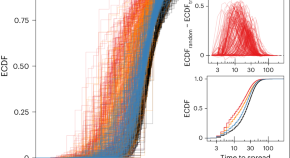
Long ties across networks accelerate the spread of social contagions
Long ties that bridge socially separate regions of networks are critical for the spread of contagions, such as innovations or adoptions of new norms. Contrary to previous thinking, long ties have now been found to accelerate social contagions, even for behaviours that involve the social reinforcement of adoption by network neighbours.
Latest Research and Reviews
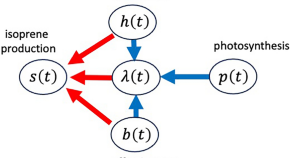
Optimal seasonal schedule for the production of isoprene, a highly volatile biogenic VOC
- Rena Hayashi
- Akiko Satake
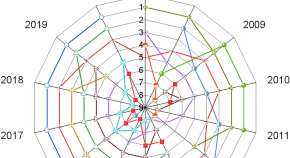
Evaluation and impact factors of international competitiveness of China’s cobalt industry from the perspective of trade networks
- Zhengfang Zhong
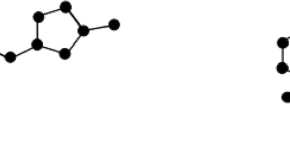
A python based algorithmic approach to optimize sulfonamide drugs via mathematical modeling
- Wakeel Ahmed
- Fekadu Tesgera Agama
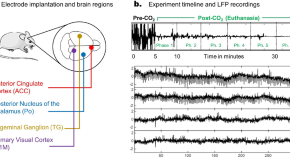
Reconstructing rodent brain signals during euthanasia with eigensystem realization algorithm (ERA)
- Khitam Aqel
- Pedro D. Maia
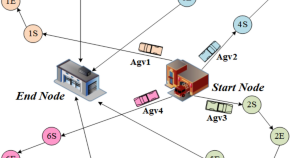
Quantum computing for several AGV scheduling models
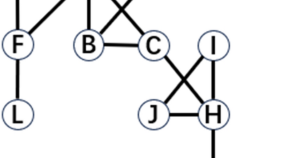
Key node identification for a network topology using hierarchical comprehensive importance coefficients
- Fanshuo Qiu
News and Comment

The curious case of the test set AUROC
The area under the receiver operating characteristic curve (AUROC) of the test set is used throughout machine learning (ML) for assessing a model’s performance. However, when concordance is not the only ambition, this gives only a partial insight into performance, masking distribution shifts of model outputs and model instability.
- Michael Roberts
- Carola-Bibiane Schönlieb
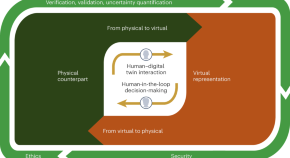
The role of computational science in digital twins
Digital twins hold immense promise in accelerating scientific discovery, but the publicity currently outweighs the evidence base of success. We summarize key research opportunities in the computational sciences to enable digital twin technologies, as identified by a recent National Academies of Sciences, Engineering, and Medicine consensus study report.
- Karen Willcox
- Brittany Segundo
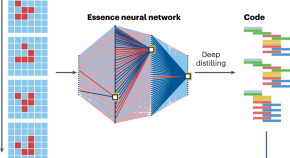
Distilling data into code
One of the greatest limitations of deep neural networks is the difficulty of interpreting what they learn from the data. Deep distilling addresses this problem by extracting human-comprehensible and executable code from observations.
- Joseph Bakarji

Why even specialists struggle with black hole proofs
Mathematical proofs of black hole physics are becoming too complex even for specialists.
- Alejandro Penuela Diaz

Packing finite numbers of spheres efficiently
A paper in Nature Communications reports experiments and simulations of spherical particles that help show how finite numbers of spheres pack in practice.
- Zoe Budrikis
Quick links
- Explore articles by subject
- Guide to authors
- Editorial policies
Thesis Helpers
Find the best tips and advice to improve your writing. Or, have a top expert write your paper.
202 Math Research Topics: List To Vary Your Ideas
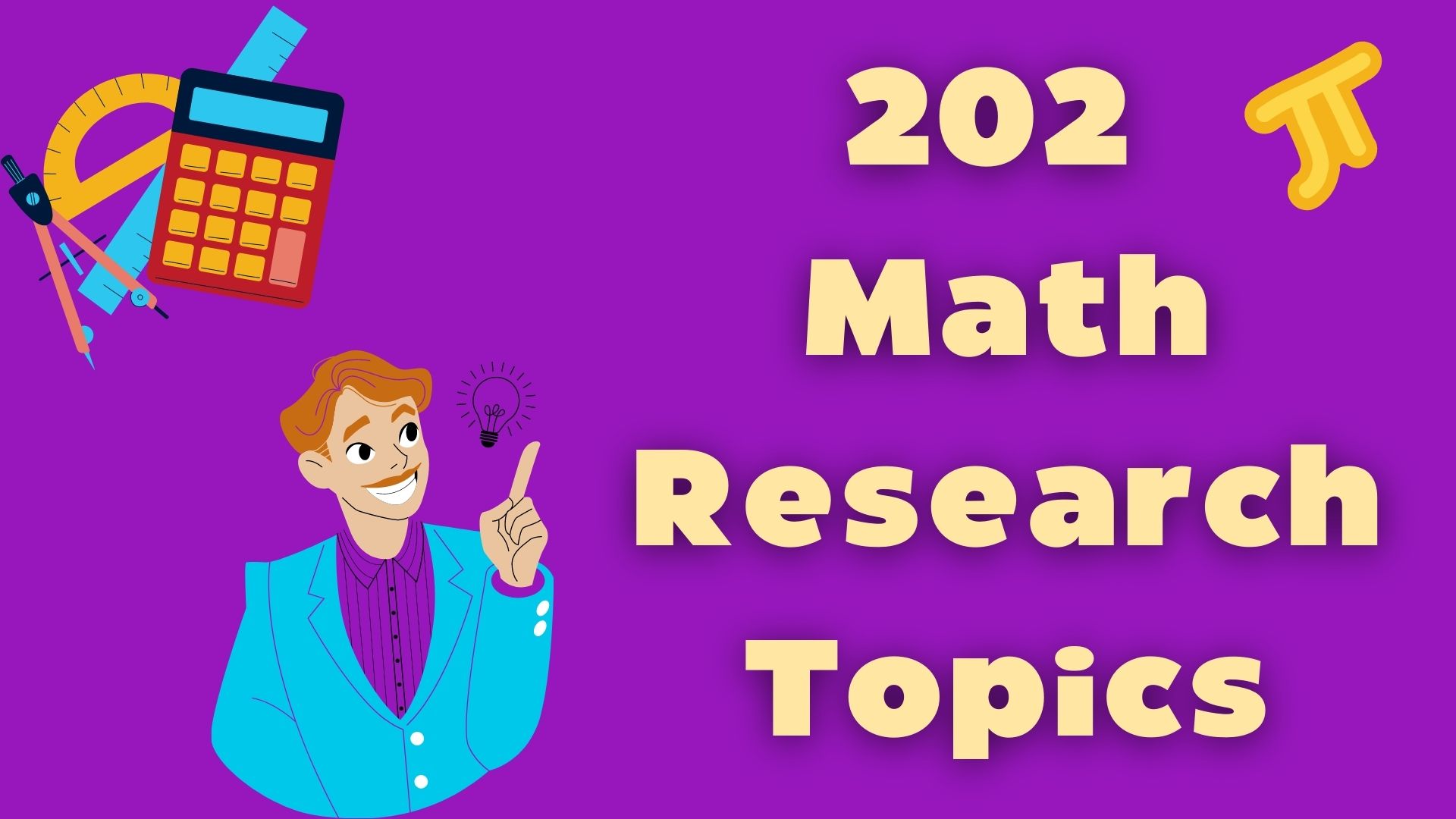
Mathematics is an exceptional field of study dealing primarily with numbers. It also deals with structures, formulas, shapes, spaces, and quantities of where they are contained.
Maths encompasses different types of computations that are applied in the real world.
Math requires a lot of analysis. This is why there are different types of maths. They all encompass different subjects and deal with different things. What are the types of maths?
Arithmetic This is perhaps the commonest type or branch of maths. It is one of the oldest and it encompasses basic numbers operations. These are addition, subtraction, multiplication, and divisions; in some schools, the short word for it is BODMAS. This is known as the Bracket of Division, Multiplication, Addition, and Subtraction. Algebra This is where unknown quantities are represented by alphabets and used along with numbers. The letters these unknown quantities are represented by are usually A, B, X, and Y, and they could also be symbols. Geometry This is considered one of the practical branches of maths as it examines sizes, shapes, figures, and the features of these entities. The most common parts of geometry are lines, points, solids, surfaces, and angles.
There are many other types but the above are the most popular. Others are trigonometry, topology, mathematical analysis, calculus, probability, statistics, and a few others.
As many students find it hard to develop maths research topics on their own, this is a chance for you. It’s okay to be worked up when you can’t find undergraduate math research topics that fit your project, essay or paper choices. This article will provide custom maths education research topics for your use. Before that, how do you structure your math essay or paper?
How to Structure Your Math Essay or Paper
Structuring your essay or paper may require that you’ve been reading critical math journals. Reading them could have made it easy to understand how to structure your paper. However, you don’t have to worry if you haven’t. Structuring your paper as expected is an essential part of writing and you’ll know about it in this section. Before you learn that, how do you choose a topic?
Choosing a Topic to Discuss
One of the difficult yet significant parts of any math essay or paper is choosing your topic. This is because you need to solve a problem or engage in a subject that has got less attention. You also need to understand the background to the subject you want to discuss as you can’t write blindly.
You must also be able to articulate your thoughts well as you must show visible knowledge before you commence the research and writing. How do you go about this? You can consider reading existing research. You can even take notes during classes to see the areas you think more work needs to be done.
After choosing your topic, conduct your research to see if you can investigate the sphere. If you can, you need to structure your research thus:
The Background This includes the discussion on what the essay is about. Depending on what you’re writing about, you need to discuss the primary concepts, including the history of some terms, where essential, in this section. This section is more like general information about the subject you want to discuss with your paper. This helps your readers familiarize themselves with your intended discussion. The Introduction This is where the main ideas behind your essays (and the solutions you hope to proffer) are tended to the readers. This is where you also explain the symbols you’ll use and the principles which are required in your essay. Aside from this, you need to state the basic issues, the solutions you could offer, the laws which are essential to discuss to make your work comprehensible. The Main Body This is where you elaborate on your findings. You need to state the research problem, the formulas, the theories you’ll use in tackling the problem, and many other things. You also need to introduce different sections of maths into the main body which is divided by paragraphs and/or chapters as well as mathematical analysis where needed. Implications This is the last part of your essay or paper. This is where you share the insights of your research with your readers. You offer short explanations of the things you have discussed. If you have treated a subject in applied mathematics, this is where you give summaries of how math is connected to human life and the strategic importance of these to people.
By adhering to this structure, you would have crafted the best rated and high-quality maths paper. Furthermore, remember you always have an option to get help with dissertations and save your time. Since it is sometimes challenging to choose cool maths topics to research on your own, these are some for you:
Research Topics in Math
Math is a broad subject. There is a study of the history of math as well as its influence in education, amongst many other sub-sections. If you’d like to create stunning research, you may choose to discuss any of these research topics in math to fulfill one of your academic requirements:
- What are the distinctions between commutative and noncommutative algebra?
- Discuss the methods of factoring quadratics
- Types of sequences and your understanding of them
- Partial fractions: what are they and how do they work?
- Logarithms: what are they and how do they work?
- An overview of Gaussian elimination
- An overview of Brun’s constant relevant
- A description of the effect of dyscalculia on daily student lives
- Describe Descartes’s Dukes of Signs and their application
- Greeks and geometry: discuss
- Describe Euler’s formula
- The progression in the study of math
- Congruence meaning and methods
- Describe the correlation of CT scans to geometry
- Hypercubes and how they work
- The basis of Cramer’s rule
- The examination of Archimedean solids
- Projective geometry and why it’s studied
- Types of Transformations and the available types
- Picasso’s works and the application of geometry
- Difference between the conventional and unconventional approaches to teaching
- Math education and the process of Improvement in the US
- Rhombicosidodecahedron and how it operates in real life
- What are the STEM career fields and why are they important?
- Why women are needed in STEM
- The goals of teaching maths
- How to teach maths to special students
- The correlation between maths and accounting
- The distinction between computer programming and applied maths
- Applied maths and its dynamics
- Processes of solving Heesch’s problem
- Why should kids learn equations?
- History of calculus
- Why there is a need for math camps in schools
- The need for more maths competition in the US
- Methods of draining flight schedule for a country
- Why are some math problems unsolved?
- Discuss the consequences of the gender gap in math students
- Encryption and prime numbers: how do they apply?
- The significance of maths in day to day living.
Undergraduate Math Research Topics
As an undergraduate, you may also have a difficult time wrapping your head around math research topics. You may need to offer both practical and theoretical assessments while writing your paper or essay. The following are undergraduate math research topics:
- Show the proofs of what F-algebras are used
- Abstract algebra, what does it mean?
- Algebra and geometry: discuss
- Acute square triangulation: how it works
- Right triangles: discuss their importance
- Discuss number problems
- Why every math student should study non-Euclidean geometry
- Dirac manifolds and what it means
- Influence of geometry in physics, chemistry, and others
- The application of Riemannian manifolds in the Euclidean space
- How to improve your mathematical thinking ability
- Technology in maths: how is it used?
- Studies of maths in Europe
- Math anxiety and what it truly means
- Standardized testing and the goals of such
- Challenges of learning maths from public schools
- The significance of circles in maths
- The political and social significance of learning maths
- Research into how to increase student interest in maths
- How painting and drawing could help with maths
- Relationship of culture and maths
- History of algebra
- Role of maths in everyday life
- How math is used in Artificial intelligence
- The transferable belief model and its application
- An analysis of the Dempster-Shafer theory
- The role of continuous stochastic process in mathematics
- The major math theorems: discuss how they work
- Understanding the Gauss-Markov: The Evolution of maths
- Discrete random variable: an in-depth understanding of what it means in math and how to identify one.
Math Research Topics for High School Students
As a high school student writing a research paper, one way to get high grades is to write what you know. If you know any math research paper topics for high school, they are the topics you should pick. You can consider:
- Hyperbola: what it is and how it’s used in math
- When to use a calculator in class
- How to find solutions to linear equations
- The need for Pythagoras theorem in maths
- The role of art in maths and vice versa
- Role of philosophy in maths
- An overview of numerical data
- Egyptian mathematics explained
- Binomial theorem and its importance
- Probability, and how to solve a question on dice
- Why is math made compulsory in schools?
- Why do students hate maths?
- Why do students hate math teachers?
- How is math applied in the workplace?
- What are imaginary numbers and why are they needed
- How to calculate the interest rate and what is their importance in the banking sector?
- Discount factor: how is it achieved and why is it important for students?
- Types of techniques to be used while finding solutions to mathematical and finance gaps
- Solving a matrix: what are the important formulas and principles to embrace?
- How to create a chart on a company’s financial analysis for the past 5 years.
Interesting Math Research Topics
Writing a mathematical essay may seem complex to you if you can’t find simple topics to write about. There are many easy topics which are also general in maths. If you want to choose a relaxing topic for your math essay or paper, you can write about the following:
- The basic elements of Boolean algebra
- The life, time, and contribution of Isaac Newton to maths
- Sphericon and what it means
- Martingales and what they mean
- Hyperboloid and importance in geometry
- Describe the life, times, and contribution of Gauss to maths
- The most famous work of Jakob Bernoulli
- The most famous work of Jean d’Alembert
- Meaning and application of calculus in the banking field
- The meaning of congruence in math
- Analysis of De Finetti theorem in probability and statistics
- Describe Egyptian pyramids in concert with calculus
- Describe the enclosing sphere technique as used in combinatorics
- Tree automation meaning
- Pushdown automaton and Buchi automaton: differences and similarities
- What is the Markov algorithm?
- Describe what a Turing machine is
- What is the linear speedup theory in math?
- The Boolean satisfiability problem and what it means for students
- Why is the multiplication table important?
- Computational maths and its classes
- What does the post correspondence problem mean?
- What does the Scholz conjecture mean?
- How to calculate mean, median, and mode
- A study of the most difficult equations in math.
Cool Math Topics to Research
As a student of any level, you may love to create math topics that are not exactly complex. These are topics that lean on the history of maths, math education research topics, and others. Consider these math research topics for college students for your next essay or paper:
- Discuss what the Golden Ratio means in the paintings of the Renaissance period
- How to learn math
- An overview of the multiple ideas to probability
- How chess and checkers is essential in understanding mathematics
- How Pythagorean theorem is applied in real-life maths
- How to measure infinity
- The features of Mobius strip in geometry
- Describe what is meant by the Pascal’s Triangle
- Evaluate the Georg Cantor set theory
- What is the history of the number types?
- How does probability relate to card tricks?
- Compare and contrast abstract and universal algebra
- Describe Euclid’s role in the evolution of maths
- Evaluate the role of Indians in maths
- Explain the limits of calculus
- Discuss what predictive and prescriptive statistical analysis means
- What does chaos theory mean?
- Explain how to solve the Rubik’s Cube
- Why are some math equations so complex?
- How is geometry used in contemporary architectural designs?
Math Research Topics for Middle School
It’s okay to be worried about math topics for your research as a middle school student. There are still different unique topics that are rebranded from existing ones. You can find some of the right math research paper topics for you here:
- The role of statistics in business
- Definition of economic lot scheduling
- Why stock market crash
- The contribution of many traders in the New York Stock Exchange
- Revenue management and its history
- What are the financial indicators of a good investment?
- What are the odds of depreciation?
- How can any country benefit from the poor currency?
- Describe debt amortization and how math helps
- How to calculate net worth
- Distinctions in calculus, trigonometry, and algebra
- How did calculus start?
- How did trigonometry start?
- Why is Ito stochastic important in math?
- What do limits in math mean?
- How to know critical points in graphs
- What does nonstandard analysis in the probability theory mean?
- Describe continuous function
- The main principles of calculus
- The main principles of Pythagoras theorem
- Application of calculus in finance
- Value theorem in math
- Ratio and root test definition
- Linear approximations and how they work
- What is the Jacobson density theorem?
- Similarities and differences between epimorphisms and monopolists
- What does the Artin-Wedderburn theorem mean?
- Commutative ring and its meaning in algebra
- How difficult is it to teach maths?
- How standards examination curriculum affects math education.
Applied Math Research Topics
Applied math is a branch which deals with the application of mathematical methods in real life. These are manifested by applications in finance, physics, engineering, biology, medicine, and others. Through specialized knowledge, applied math is made possible. These are some topics for you in this area:
- How discovering genes can help determine healthy and unhealthy patients
- Role of algorithms in probabilistic modeling
- The need for mathematicians in developing robots
- The role of mathematicians in crime data analysis and prevention
- How did Isaac’s Laws of Motion help in real life?
- How math helped with energy conservation
- The role of math in quantum theory
- Analyze the features of the Lorentz symmetry
- Evaluate statistical signal processing in details
- Discuss how Galilean Transformation was achieved
- Examine nonlinear models
- Elucidate on the importance of data mining in banking
- The importance of step-stress modeling
- The significance of computer tomography
- What are the dimensions used in examining fingerprints?
Math Research Topics for College Students
As college students, you are at a critical level. You need maths topics for your essays and paper. You may also need them to prepare for your exams. These are some math research topics for you:
- Evolution of mathematics
- Explore the varieties of the Tower of Hanoi solutions
- Discuss how to use Napier’s bones
- Give examples of chaos theory and explain
- Discuss the important mathematical equations of all times
- Examine the nitty-gritty of barcodes
- What is the Traveling Salesman Problem?
- Natural selection and Fisher’s fundamental theorem of understanding it
- The Influence of math in biology
- The Influence of math in chemistry
- What is quantum computing?
- How to solve extremal problems in maths
- Analyze the meaning of fractals
- Discuss Einstein’s field equation theory
- Who created computer vision and object recognition?
- Five formulas and how they are applied
- Give three approaches to understanding maths
- Explain the origin and importance of algebra
- What do you know about the Fibonacci sequence?
- Trace the origin of math
- How does math help in geography?
- What does the operator spaces notion mean?
Get Math Paper Research Help
Do you need professional research paper help? We offer affordable and cheap research paper assistance for students across all levels. If you need help with research papers, you can easily buy dissertation online from our team of academicians.
Our academicians are experts at college research paper writing service online. For a cheap price, they have written the best rated submissions in schools in the US and Europe. With high quality writing, you can hire them and get your paper before your deadline.

Make PhD experience your own
Leave a Reply Cancel reply
Your email address will not be published. Required fields are marked *
Advertisement
Future themes of mathematics education research: an international survey before and during the pandemic
- Open access
- Published: 06 April 2021
- Volume 107 , pages 1–24, ( 2021 )
Cite this article
You have full access to this open access article

- Arthur Bakker ORCID: orcid.org/0000-0002-9604-3448 1 ,
- Jinfa Cai ORCID: orcid.org/0000-0002-0501-3826 2 &
- Linda Zenger 1
30k Accesses
83 Citations
17 Altmetric
Explore all metrics
Before the pandemic (2019), we asked: On what themes should research in mathematics education focus in the coming decade? The 229 responses from 44 countries led to eight themes plus considerations about mathematics education research itself. The themes can be summarized as teaching approaches, goals, relations to practices outside mathematics education, teacher professional development, technology, affect, equity, and assessment. During the pandemic (November 2020), we asked respondents: Has the pandemic changed your view on the themes of mathematics education research for the coming decade? If so, how? Many of the 108 respondents saw the importance of their original themes reinforced (45), specified their initial responses (43), and/or added themes (35) (these categories were not mutually exclusive). Overall, they seemed to agree that the pandemic functions as a magnifying glass on issues that were already known, and several respondents pointed to the need to think ahead on how to organize education when it does not need to be online anymore. We end with a list of research challenges that are informed by the themes and respondents’ reflections on mathematics education research.
Similar content being viewed by others

Learning from Research, Advancing the Field

The Narcissism of Mathematics Education

Educational Research on Learning and Teaching Mathematics
Avoid common mistakes on your manuscript.
1 An international survey in two rounds
Around the time when Educational Studies in Mathematics (ESM) and the Journal for Research in Mathematics Education (JRME) were celebrating their 50th anniversaries, Arthur Bakker (editor of ESM) and Jinfa Cai (editor of JRME) saw a need to raise the following future-oriented question for the field of mathematics education research:
Q2019: On what themes should research in mathematics education focus in the coming decade?
To that end, we administered a survey with just this one question between June 17 and October 16, 2019.
When we were almost ready with the analysis, the COVID-19 pandemic broke out, and we were not able to present the results at the conferences we had planned to attend (NCTM and ICME in 2020). Moreover, with the world shaken up by the crisis, we wondered if colleagues in our field might think differently about the themes formulated for the future due to the pandemic. Hence, on November 26, 2020, we asked a follow-up question to those respondents who in 2019 had given us permission to approach them for elaboration by email:
Q2020: Has the pandemic changed your view on the themes of mathematics education research for the coming decade? If so, how?
In this paper, we summarize the responses to these two questions. Similar to Sfard’s ( 2005 ) approach, we start by synthesizing the voices of the respondents before formulating our own views. Some colleagues put forward the idea of formulating a list of key themes or questions, similar to the 23 unsolved mathematical problems that David Hilbert published around 1900 (cf. Schoenfeld, 1999 ). However, mathematics and mathematics education are very different disciplines, and very few people share Hilbert’s formalist view on mathematics; hence, we do not want to suggest that we could capture the key themes of mathematics education in a similar way. Rather, our overview of themes drawn from the survey responses is intended to summarize what is valued in our global community at the time of the surveys. Reasoning from these themes, we end with a list of research challenges that we see worth addressing in the future (cf. Stephan et al., 2015 ).
2 Methodological approach
2.1 themes for the coming decade (2019).
We administered the 1-question survey through email lists that we were aware of (e.g., Becker, ICME, PME) and asked mathematics education researchers to spread it in their national networks. By October 16, 2019, we had received 229 responses from 44 countries across 6 continents (Table 1 ). Although we were happy with the larger response than Sfard ( 2005 ) received (74, with 28 from Europe), we do not know how well we have reached particular regions, and if potential respondents might have faced language or other barriers. We did offer a few Chinese respondents the option to write in Chinese because the second author offered to translate their emails into English. We also received responses in Spanish, which were translated for us.
Ethical approval was given by the Ethical Review Board of the Faculties of Science and Geo-science of Utrecht University (Bèta L-19247). We asked respondents to indicate if they were willing to be quoted by name and if we were allowed to approach them for subsequent information. If they preferred to be named, we mention their name and country; otherwise, we write “anonymous.” In our selection of quotes, we have focused on content, not on where the response came from. On March 2, 2021, we approached all respondents who were quoted to double-check if they agreed to be quoted and named. One colleague preferred the quote and name to be deleted; three suggested small changes in wording; the others approved.
On September 20, 2019, the three authors met physically at Utrecht University to analyze the responses. After each individual proposal, we settled on a joint list of seven main themes (the first seven in Table 2 ), which were neither mutually exclusive nor exhaustive. The third author (Zenger, then still a student in educational science) next color coded all parts of responses belonging to a category. These formed the basis for the frequencies and percentages presented in the tables and text. The first author (Bakker) then read all responses categorized by a particular code to identify and synthesize the main topics addressed within each code. The second author (Cai) read all of the survey responses and the response categories, and commented. After the initial round of analysis, we realized it was useful to add an eighth theme: assessment (including evaluation).
Moreover, given that a large number of respondents made comments about mathematics education research itself, we decided to summarize these separately. For analyzing this category of research, we used the following four labels to distinguish types of comments on our discipline of mathematics education research: theory, methodology, self-reflection (including ethical considerations), interdisciplinarity, and transdisciplinarity. We then summarized the responses per type of comment.
It has been a daunting and humbling experience to study the huge coverage and diversity of topics that our colleagues care about. Any categorization felt like a reduction of the wealth of ideas, and we are aware of the risks of “sorting things out” (Bowker & Star, 2000 ), which come with foregrounding particular challenges rather than others (Stephan et al., 2015 ). Yet the best way to summarize the bigger picture seemed by means of clustering themes and pointing to their relationships. As we identified these eight themes of mathematics education research for the future, a recurring question during the analysis was how to represent them. A list such as Table 2 does not do justice to the interrelations between the themes. Some relationships are very clear, for example, educational approaches (theme 2) working toward educational or societal goals (theme 1). Some themes are pervasive; for example, equity and (positive) affect are both things that educators want to achieve but also phenomena that are at stake during every single moment of learning and teaching. Diagrams we considered to represent such interrelationships were either too specific (limiting the many relevant options, e.g., a star with eight vertices that only link pairs of themes) or not specific enough (e.g., a Venn diagram with eight leaves such as the iPhone symbol for photos). In the end, we decided to use an image and collaborated with Elisabeth Angerer (student assistant in an educational sciences program), who eventually made the drawing in Fig. 1 to capture themes in their relationships.

Artistic impression of the future themes
2.2 Has the pandemic changed your view? (2020)
On November 26, 2020, we sent an email to the colleagues who responded to the initial question and who gave permission to be approached by email. We cited their initial response and asked: “Has the pandemic changed your view on the themes of mathematics education research for the coming decade? If so, how?” We received 108 responses by January 12, 2021. The countries from which the responses came included China, Italy, and other places that were hit early by the COVID-19 virus. The length of responses varied from a single word response (“no”) to elaborate texts of up to 2215 words. Some people attached relevant publications. The median length of the responses was 87 words, with a mean length of 148 words and SD = 242. Zenger and Bakker classified them as “no changes” (9 responses) or “clearly different views” (8); the rest of the responses saw the importance of their initial themes reinforced (45), specified their initial responses (43), or added new questions or themes (35). These last categories were not mutually exclusive, because respondents could first state that they thought the initial themes were even more relevant than before and provide additional, more specified themes. We then used the same themes that had been identified in the first round and identified what was stressed or added in the 2020 responses.
3 The themes
The most frequently mentioned theme was what we labeled approaches to teaching (64% of the respondents, see Table 2 ). Next was the theme of goals of mathematics education on which research should shed more light in the coming decade (54%). These goals ranged from specific educational goals to very broad societal ones. Many colleagues referred to mathematics education’s relationships with other practices (communities, institutions…) such as home, continuing education, and work. Teacher professional development is a key area for research in which the other themes return (what should students learn, how, how to assess that, how to use technology and ensure that students are interested?). Technology constitutes its own theme but also plays a key role in many other themes, just like affect. Another theme permeating other ones is what can be summarized as equity, diversity, and inclusion (also social justice, anti-racism, democratic values, and several other values were mentioned). These values are not just societal and educational goals but also drivers for redesigning teaching approaches, using technology, working on more just assessment, and helping learners gain access, become confident, develop interest, or even love for mathematics. To evaluate if approaches are successful and if goals have been achieved, assessment (including evaluation) is also mentioned as a key topic of research.
In the 2020 responses, many wise and general remarks were made. The general gist is that the pandemic (like earlier crises such as the economic crisis around 2008–2010) functioned as a magnifying glass on themes that were already considered important. Due to the pandemic, however, systemic societal and educational problems were said to have become better visible to a wider community, and urge us to think about the potential of a “new normal.”
3.1 Approaches to teaching
We distinguish specific teaching strategies from broader curricular topics.
3.1.1 Teaching strategies
There is a widely recognized need to further design and evaluate various teaching approaches. Among the teaching strategies and types of learning to be promoted that were mentioned in the survey responses are collaborative learning, critical mathematics education, dialogic teaching, modeling, personalized learning, problem-based learning, cross-curricular themes addressing the bigger themes in the world, embodied design, visualization, and interleaved learning. Note, however, that students can also enhance their mathematical knowledge independently from teachers or parents through web tutorials and YouTube videos.
Many respondents emphasized that teaching approaches should do more than promote cognitive development. How can teaching be entertaining or engaging? How can it contribute to the broader educational goals of developing students’ identity, contribute to their empowerment, and help them see the value of mathematics in their everyday life and work? We return to affect in Section 3.7 .
In the 2020 responses, we saw more emphasis on approaches that address modeling, critical thinking, and mathematical or statistical literacy. Moreover, respondents stressed the importance of promoting interaction, collaboration, and higher order thinking, which are generally considered to be more challenging in distance education. One approach worth highlighting is challenge-based education (cf. Johnson et al. 2009 ), because it takes big societal challenges as mentioned in the previous section as its motivation and orientation.
3.1.2 Curriculum
Approaches by which mathematics education can contribute to the aforementioned goals can be distinguished at various levels. Several respondents mentioned challenges around developing a coherent mathematics curriculum, smoothing transitions to higher school levels, and balancing topics, and also the typical overload of topics, the influence of assessment on what is taught, and what teachers can teach. For example, it was mentioned that mathematics teachers are often not prepared to teach statistics. There seems to be little research that helps curriculum authors tackle some of these hard questions as well as how to monitor reform (cf. Shimizu & Vithal, 2019 ). Textbook analysis is mentioned as a necessary research endeavor. But even if curricula within one educational system are reasonably coherent, how can continuity between educational systems be ensured (cf. Jansen et al., 2012 )?
In the 2020 responses, some respondents called for free high-quality curriculum resources. In several countries where Internet access is a problem in rural areas, a shift can be observed from online resources to other types of media such as radio and TV.
3.2 Goals of mathematics education
The theme of approaches is closely linked to that of the theme of goals. For example, as Fulvia Furinghetti (Italy) wrote: “It is widely recognized that critical thinking is a fundamental goal in math teaching. Nevertheless it is still not clear how it is pursued in practice.” We distinguish broad societal and more specific educational goals. These are often related, as Jane Watson (Australia) wrote: “If Education is to solve the social, cultural, economic, and environmental problems of today’s data-driven world, attention must be given to preparing students to interpret the data that are presented to them in these fields.”
3.2.1 Societal goals
Respondents alluded to the need for students to learn to function in the economy and in society more broadly. Apart from instrumental goals of mathematics education, some emphasized goals related to developing as a human being, for instance learning to see the mathematics in the world and develop a relation with the world. Mathematics education in these views should empower students to combat anti-expertise and post-fact tendencies. Several respondents mentioned even larger societal goals such as avoiding extinction as a human species and toxic nationalism, resolving climate change, and building a sustainable future.
In the second round of responses (2020), we saw much more emphasis on these bigger societal issues. The urgency to orient mathematics education (and its research) toward resolving these seemed to be felt more than before. In short, it was stressed that our planet needs to be saved. The big question is what role mathematics education can play in meeting these challenges.
3.2.2 Educational goals
Several respondents expressed a concern that the current goals of mathematics education do not reflect humanity’s and societies’ needs and interests well. Educational goals to be stressed more were mathematical literacy, numeracy, critical, and creative thinking—often with reference to the changing world and the planet being at risk. In particular, the impact of technology was frequently stressed, as this may have an impact on what people need to learn (cf. Gravemeijer et al., 2017 ). If computers can do particular things much better than people, what is it that students need to learn?
Among the most frequently mentioned educational goals for mathematics education were statistical literacy, computational and algorithmic thinking, artificial intelligence, modeling, and data science. More generally, respondents expressed that mathematics education should help learners deploy evidence, reasoning, argumentation, and proof. For example, Michelle Stephan (USA) asked:
What mathematics content should be taught today to prepare students for jobs of the future, especially given growth of the digital world and its impact on a global economy? All of the mathematics content in K-12 can be accomplished by computers, so what mathematical procedures become less important and what domains need to be explored more fully (e.g., statistics and big data, spatial geometry, functional reasoning, etc.)?
One challenge for research is that there is no clear methodology to arrive at relevant and feasible learning goals. Yet there is a need to choose and formulate such goals on the basis of research (cf. Van den Heuvel-Panhuizen, 2005 ).
Several of the 2020 responses mentioned the sometimes problematic way in which numbers, data, and graphs are used in the public sphere (e.g., Ernest, 2020 ; Kwon et al., 2021 ; Yoon et al., 2021 ). Many respondents saw their emphasis on relevant educational goals reinforced, for example, statistical and data literacy, modeling, critical thinking, and public communication. A few pandemic-specific topics were mentioned, such as exponential growth.
3.3 Relation of mathematics education to other practices
Many responses can be characterized as highlighting boundary crossing (Akkerman & Bakker, 2011 ) with disciplines or communities outside mathematics education, such as in science, technology, engineering, art, and mathematics education (STEM or STEAM); parents or families; the workplace; and leisure (e.g., drama, music, sports). An interesting example was the educational potential of mathematical memes—“humorous digital objects created by web users copying an existing image and overlaying a personal caption” (Bini et al., 2020 , p. 2). These boundary crossing-related responses thus emphasize the movements and connections between mathematics education and other practices.
In the 2020 responses, we saw that during the pandemic, the relationship between school and home has become much more important, because most students were (and perhaps still are) learning at home. Earlier research on parental involvement and homework (Civil & Bernier, 2006 ; de Abreu et al., 2006 ; Jackson, 2011 ) proves relevant in the current situation where many countries are still or again in lockdown. Respondents pointed to the need to monitor students and their work and to promote self-regulation. They also put more stress on the political, economic, and financial contexts in which mathematics education functions (or malfunctions, in many respondents’ views).
3.4 Teacher professional development
Respondents explicitly mentioned teacher professional development as an important domain of mathematics education research (including teacher educators’ development). For example, Loide Kapenda (Namibia) wrote, “I am supporting UNESCO whose idea is to focus on how we prepare teachers for the future we want.” (e.g., UNESCO, 2015 ) And, Francisco Rojas (Chile) wrote:
Although the field of mathematics education is broad and each time faced with new challenges (socio-political demands, new intercultural contexts, digital environments, etc.), all of them will be handled at school by the mathematics teacher, both in primary as well as in secondary education. Therefore, from my point of view, pre-service teacher education is one of the most relevant fields of research for the next decade, especially in developing countries.
It is evident from the responses that teaching mathematics is done by a large variety of people, not only by people who are trained as primary school teachers, secondary school mathematics teachers, or mathematicians but also parents, out-of-field teachers, and scientists whose primary discipline is not mathematics but who do use mathematics or statistics. How teachers of mathematics are trained varies accordingly. Respondents frequently pointed to the importance of subject-matter knowledge and particularly noted that many teachers seem ill-prepared to teach statistics (e.g., Lonneke Boels, the Netherlands).
Key questions were raised by several colleagues: “How to train mathematics teachers with a solid foundation in mathematics, positive attitudes towards mathematics teaching and learning, and wide knowledge base linking to STEM?” (anonymous); “What professional development, particularly at the post-secondary level, motivates changes in teaching practices in order to provide students the opportunities to engage with mathematics and be successful?” (Laura Watkins, USA); “How can mathematics educators equip students for sustainable, equitable citizenship? And how can mathematics education equip teachers to support students in this?” (David Wagner, Canada)
In the 2020 responses, it was clear that teachers are incredibly important, especially in the pandemic era. The sudden change to online teaching means that
higher requirements are put forward for teachers’ educational and teaching ability, especially the ability to carry out education and teaching by using information technology should be strengthened. Secondly, teachers’ ability to communicate and cooperate has been injected with new connotation. (Guangming Wang, China)
It is broadly assumed that education will stay partly online, though more so in higher levels of education than in primary education. This has implications for teachers, for instance, they will have to think through how they intend to coordinate teaching on location and online. Hence, one important focus for professional development is the use of technology.
3.5 Technology
Technology deserves to be called a theme in itself, but we want to emphasize that it ran through most of the other themes. First of all, some respondents argued that, due to technological advances in society, the societal and educational goals of mathematics education need to be changed (e.g., computational thinking to ensure employability in a technological society). Second, responses indicated that the changed goals have implications for the approaches in mathematics education. Consider the required curriculum reform and the digital tools to be used in it. Students do not only need to learn to use technology; the technology can also be used to learn mathematics (e.g., visualization, embodied design, statistical thinking). New technologies such as 3D printing, photo math, and augmented and virtual reality offer new opportunities for learning. Society has changed very fast in this respect. Third, technology is suggested to assist in establishing connections with other practices , such as between school and home, or vocational education and work, even though there is a great disparity in how successful these connections are.
In the 2020 responses, there was great concern about the current digital divide (cf. Hodgen et al., 2020 ). The COVID-19 pandemic has thus given cause for mathematics education research to understand better how connections across educational and other practices can be improved with the help of technology. Given the unequal distribution of help by parents or guardians, it becomes all the more important to think through how teachers can use videos and quizzes, how they can monitor their students, how they can assess them (while respecting privacy), and how one can compensate for the lack of social, gestural, and embodied interaction that is possible when being together physically.
Where mobile technology was considered very innovative before 2010, smartphones have become central devices in mathematics education in the pandemic with its reliance on distance learning. Our direct experience showed that phone applications such as WhatsApp and WeChat have become key tools in teaching and learning mathematics in many rural areas in various continents where few people have computers (for a report on podcasts distributed through WhatsApp, community loudspeakers, and local radio stations in Colombia, see Saenz et al., 2020 ).
3.6 Equity, diversity, and inclusion
Another cross-cutting theme can be labeled “equity, diversity, and inclusion.” We use this triplet to cover any topic that highlights these and related human values such as equality, social and racial justice, social emancipation, and democracy that were also mentioned by respondents (cf. Dobie & Sherin, 2021 ). In terms of educational goals , many respondents stressed that mathematics education should be for all students, including those who have special needs, who live in poverty, who are learning the instruction language, who have a migration background, who consider themselves LGBTQ+, have a traumatic or violent history, or are in whatever way marginalized. There is broad consensus that everyone should have access to high-quality mathematics education. However, as Niral Shah (USA) notes, less attention has been paid to “how phenomena related to social markers (e.g., race, class, gender) interact with phenomena related to the teaching and learning of mathematical content.”
In terms of teaching approaches , mathematics education is characterized by some respondents from particular countries as predominantly a white space where some groups feel or are excluded (cf. Battey, 2013 ). There is a general concern that current practices of teaching mathematics may perpetuate inequality, in particular in the current pandemic. In terms of assessment , mathematics is too often used or experienced as a gatekeeper rather than as a powerful resource (cf. Martin et al., 2010 ). Steve Lerman (UK) “indicates that understanding how educational opportunities are distributed inequitably, and in particular how that manifests in each end every classroom, is a prerequisite to making changes that can make some impact on redistribution.” A key research aim therefore is to understand what excludes students from learning mathematics and what would make mathematics education more inclusive (cf. Roos, 2019 ). And, what does professional development of teachers that promotes equity look like?
In 2020, many respondents saw their emphasis on equity and related values reinforced in the current pandemic with its risks of a digital divide, unequal access to high-quality mathematics education, and unfair distribution of resources. A related future research theme is how the so-called widening achievement gaps can be remedied (cf. Bawa, 2020 ). However, warnings were also formulated that thinking in such deficit terms can perpetuate inequality (cf. Svensson et al., 2014 ). A question raised by Dor Abrahamson (USA) is, “What roles could digital technology play, and in what forms, in restoring justice and celebrating diversity?”
Though entangled with many other themes, affect is also worth highlighting as a theme in itself. We use the term affect in a very broad sense to point to psychological-social phenomena such as emotion, love, belief, attitudes, interest, curiosity, fun, engagement, joy, involvement, motivation, self-esteem, identity, anxiety, alienation, and feeling of safety (cf. Cobb et al., 2009 ; Darragh, 2016 ; Hannula, 2019 ; Schukajlow et al., 2017 ). Many respondents emphasized the importance of studying these constructs in relation to (and not separate from) what is characterized as cognition. Some respondents pointed out that affect is not just an individual but also a social phenomenon, just like learning (cf. Chronaki, 2019 ; de Freitas et al., 2019 ; Schindler & Bakker, 2020 ).
Among the educational goals of mathematics education, several participants mentioned the need to generate and foster interest in mathematics. In terms of approaches , much emphasis was put on the need to avoid anxiety and alienation and to engage students in mathematical activity.
In the 2020 responses, more emphasis was put on the concern about alienation, which seems to be of special concern when students are socially distanced from peers and teachers as to when teaching takes place only through technology . What was reiterated in the 2020 responses was the importance of students’ sense of belonging in a mathematics classroom (cf. Horn, 2017 )—a topic closely related to the theme of equity, diversity, and inclusion discussed before.
3.8 Assessment
Assessment and evaluation were not often mentioned explicitly, but they do not seem less important than the other related themes. A key challenge is to assess what we value rather than valuing what we assess. In previous research, the assessment of individual students has received much attention, but what seems to be neglected is the evaluation of curricula. As Chongyang Wang (China) wrote, “How to evaluate the curriculum reforms. When we pay much energy in reforming our education and curriculum, do we imagine how to ensure it will work and there will be pieces of evidence found after the new curricula are carried out? How to prove the reforms work and matter?” (cf. Shimizu & Vithal, 2019 )
In the 2020 responses, there was an emphasis on assessment at a distance. Distance education generally is faced with the challenge of evaluating student work, both formatively and summatively. We predict that so-called e-assessment, along with its privacy challenges, will generate much research interest in the near future (cf. Bickerton & Sangwin, 2020 ).
4 Mathematics education research itself
Although we only asked for future themes, many respondents made interesting comments about research in mathematics education and its connections with other disciplines and practices (such as educational practice, policy, home settings). We have grouped these considerations under the subheadings of theory, methodology, reflection on our discipline, and interdisciplinarity and transdisciplinarity. As with the previous categorization into themes, we stress that these four types are not mutually exclusive as theoretical and methodological considerations can be intricately intertwined (Radford, 2008 ).
Several respondents expressed their concern about the fragmentation and diversity of theories used in mathematics education research (cf. Bikner-Ahsbahs & Prediger, 2014 ). The question was raised how mathematics educators can “work together to obtain valid, reliable, replicable, and useful findings in our field” and “How, as a discipline, can we encourage sustained research on core questions using commensurable perspectives and methods?” (Keith Weber, USA). One wish was “comparing theoretical perspectives for explanatory power” (K. Subramaniam, India). At the same time, it was stressed that “we cannot continue to pretend that there is just one culture in the field of mathematics education, that all the theoretical framework may be applied in whichever culture and that results are universal” (Mariolina Bartolini Bussi, Italy). In addition, the wish was expressed to deepen theoretical notions such as numeracy, equity, and justice as they play out in mathematics education.
4.2 Methodology
Many methodological approaches were mentioned as potentially useful in mathematics education research: randomized studies, experimental studies, replication, case studies, and so forth. Particular attention was paid to “complementary methodologies that bridge the ‘gap’ between mathematics education research and research on mathematical cognition” (Christian Bokhove, UK), as, for example, done in Gilmore et al. ( 2018 ). Also, approaches were mentioned that intend to bridge the so-called gap between educational practice and research, such as lesson study and design research. For example, Kay Owens (Australia) pointed to the challenge of studying cultural context and identity: “Such research requires a multi-faceted research methodology that may need to be further teased out from our current qualitative (e.g., ethnographic) and quantitative approaches (‘paper and pencil’ (including computing) testing). Design research may provide further possibilities.”
Francisco Rojas (Chile) highlighted the need for more longitudinal and cross-sectional research, in particular in the context of teacher professional development:
It is not enough to investigate what happens in pre-service teacher education but understand what effects this training has in the first years of the professional career of the new teachers of mathematics, both in primary and secondary education. Therefore, increasingly more longitudinal and cross-sectional studies will be required to understand the complexity of the practice of mathematics teachers, how the professional knowledge that articulates the practice evolves, and what effects have the practice of teachers on the students’ learning of mathematics.
4.3 Reflection on our discipline
Calls were made for critical reflection on our discipline. One anonymous appeal was for more self-criticism and scientific modesty: Is research delivering, or is it drawing away good teachers from teaching? Do we do research primarily to help improve mathematics education or to better understand phenomena? (cf. Proulx & Maheux, 2019 ) The general gist of the responses was a sincere wish to be of value to the world and mathematics education more specifically and not only do “research for the sake of research” (Zahra Gooya, Iran). David Bowers (USA) expressed several reflection-inviting views about the nature of our discipline, for example:
We must normalize (and expect) the full taking up the philosophical and theoretical underpinnings of all of our work (even work that is not considered “philosophical”). Not doing so leads to uncritical analysis and implications.
We must develop norms wherein it is considered embarrassing to do “uncritical” research.
There is no such thing as “neutral.” Amongst other things, this means that we should be cultivating norms that recognize the inherent political nature of all work, and norms that acknowledge how superficially “neutral” work tends to empower the oppressor.
We must recognize the existence of but not cater to the fragility of privilege.
In terms of what is studied, some respondents felt that the mathematics education research “literature has been moving away from the original goals of mathematics education. We seem to have been investigating everything but the actual learning of important mathematics topics.” (Lyn English, Australia) In terms of the nature of our discipline, Taro Fujita (UK) argued that our discipline can be characterized as a design science, with designing mathematical learning environments as the core of research activities (cf. Wittmann, 1995 ).
A tension that we observe in different views is the following: On the one hand, mathematics education research has its origin in helping teachers teach particular content better. The need for such so-called didactical, topic-specific research is not less important today but perhaps less fashionable for funding schemes that promote innovative, ground-breaking research. On the other hand, over time it has become clear that mathematics education is a multi-faceted socio-cultural and political endeavor under the influence of many local and global powers. It is therefore not surprising that the field of mathematics education research has expanded so as to include an increasingly wide scope of themes that are at stake, such as the marginalization of particular groups. We therefore highlight Niral Shah’s (USA) response that “historically, these domains of research [content-specific vs socio-political] have been decoupled. The field would get closer to understanding the experiences of minoritized students if we could connect these lines of inquiry.”
Another interesting reflective theme was raised by Nouzha El Yacoubi (Morocco): To what extent can we transpose “research questions from developed to developing countries”? As members of the plenary panel at PME 2019 (e.g., Kazima, 2019 ; Kim, 2019 ; Li, 2019 ) conveyed well, adopting interventions that were successful in one place in another place is far from trivial (cf. Gorard, 2020 ).
Juan L. Piñeiro (Spain in 2019, Chile in 2020) highlighted that “mathematical concepts and processes have different natures. Therefore, can it be characterized using the same theoretical and methodological tools?” More generally, one may ask if our theories and methodologies—often borrowed from other disciplines—are well suited to the ontology of our own discipline. A discussion started by Niss ( 2019 ) on the nature of our discipline, responded to by Bakker ( 2019 ) and Cai and Hwang ( 2019 ), seems worth continuing.
An important question raised in several comments is how close research should be to existing curricula. One respondent (Benjamin Rott, Germany) noted that research on problem posing often does “not fit into school curricula.” This makes the application of research ideas and findings problematic. However, one could argue that research need not always be tied to existing (local) educational contexts. It can also be inspirational, seeking principles of what is possible (and how) with a longer-term view on how curricula may change in the future. One option is, as Simon Zell (Germany) suggests, to test designs that cover a longer timeframe than typically done. Another way to bridge these two extremes is “collaboration between teachers and researchers in designing and publishing research” (K. Subramaniam, India) as is promoted by facilitating teachers to do PhD research (Bakx et al., 2016 ).
One of the responding teacher-researchers (Lonneke Boels, the Netherlands) expressed the wish that research would become available “in a more accessible form.” This wish raises the more general questions of whose responsibility it is to do such translation work and how to communicate with non-researchers. Do we need a particular type of communication research within mathematics education to learn how to convey particular key ideas or solid findings? (cf. Bosch et al., 2017 )
4.4 Interdisciplinarity and transdisciplinarity
Many respondents mentioned disciplines which mathematics education research can learn from or should collaborate with (cf. Suazo-Flores et al., 2021 ). Examples are history, mathematics, philosophy, psychology, psychometry, pedagogy, educational science, value education (social, emotional), race theory, urban education, neuroscience/brain research, cognitive science, and computer science didactics. “A big challenge here is how to make diverse experts approach and talk to one another in a productive way.” (David Gómez, Chile)
One of the most frequently mentioned disciplines in relation to our field is history. It is a common complaint in, for instance, the history of medicine that historians accuse medical experts of not knowing historical research and that medical experts accuse historians of not understanding the medical discipline well enough (Beckers & Beckers, 2019 ). This tension raises the question who does and should do research into the history of mathematics or of mathematics education and to what broader purpose.
Some responses go beyond interdisciplinarity, because resolving the bigger issues such as climate change and a more equitable society require collaboration with non-researchers (transdisciplinarity). A typical example is the involvement of educational practice and policy when improving mathematics education (e.g., Potari et al., 2019 ).
Let us end this section with a word of hope, from an anonymous respondent: “I still believe (or hope?) that the pandemic, with this making-inequities-explicit, would help mathematics educators to look at persistent and systemic inequalities more consistently in the coming years.” Having learned so much in the past year could indeed provide an opportunity to establish a more equitable “new normal,” rather than a reversion to the old normal, which one reviewer worried about.
5 The themes in their coherence: an artistic impression
As described above, we identified eight themes of mathematics education research for the future, which we discussed one by one. The disadvantage of this list-wise discussion is that the entanglement of the themes is backgrounded. To compensate for that drawback, we here render a brief interpretation of the drawing of Fig. 1 . While doing so, we invite readers to use their own creative imagination and perhaps use the drawing for other purposes (e.g., ask researchers, students, or teachers: Where would you like to be in this landscape? What mathematical ideas do you spot?). The drawing mainly focuses on the themes that emerged from the first round of responses but also hints at experiences from the time of the pandemic, for instance distance education. In Appendix 1 , we specify more of the details in the drawing and we provide a link to an annotated image (available at https://www.fisme.science.uu.nl/toepassingen/28937/ ).
The boat on the river aims to represent teaching approaches. The hand drawing of the boat hints at the importance of educational design: A particular approach is being worked out. On the boat, a teacher and students work together toward educational and societal goals, further down the river. The graduation bridge is an intermediate educational goal to pass, after which there are many paths leading to other goals such as higher education, citizenship, and work in society. Relations to practices outside mathematics education are also shown. In the left bottom corner, the house and parents working and playing with children represent the link of education with the home situation and leisure activity.
The teacher, represented by the captain in the foreground of the ship, is engaged in professional development, consulting a book, but also learning by doing (cf. Bakkenes et al., 2010 , on experimenting, using resources, etc.). Apart from graduation, there are other types of goals for teachers and students alike, such as equity, positive affect, and fluent use of technology. During their journey (and partially at home, shown in the left bottom corner), students learn to orient themselves in the world mathematically (e.g., fractal tree, elliptical lake, a parabolic mountain, and various platonic solids). On their way toward various goals, both teacher and students use particular technology (e.g., compass, binoculars, tablet, laptop). The magnifying glass (representing research) zooms in on a laptop screen that portrays distance education, hinting at the consensus that the pandemic magnifies some issues that education was already facing (e.g., the digital divide).
Equity, diversity, and inclusion are represented with the rainbow, overarching everything. On the boat, students are treated equally and the sailing practice is inclusive in the sense that all perform at their own level—getting the support they need while contributing meaningfully to the shared activity. This is at least what we read into the image. Affect is visible in various ways. First of all, the weather represents moods in general (rainy and dark side on the left; sunny bright side on the right). Second, the individual students (e.g., in the crow’s nest) are interested in, anxious about, and attentive to the things coming up during their journey. They are motivated to engage in all kinds of tasks (handling the sails, playing a game of chance with a die, standing guard in the crow’s nest, etc.). On the bridge, the graduates’ pride and happiness hints at positive affect as an educational goal but also represents the exam part of the assessment. The assessment also happens in terms of checks and feedback on the boat. The two people next to the house (one with a camera, one measuring) can be seen as assessors or researchers observing and evaluating the progress on the ship or the ship’s progress.
More generally, the three types of boats in the drawing represent three different spaces, which Hannah Arendt ( 1958 ) would characterize as private (paper-folded boat near the boy and a small toy boat next to the girl with her father at home), public/political (ships at the horizon), and the in-between space of education (the boat with the teacher and students). The students and teacher on the boat illustrate school as a special pedagogic form. Masschelein and Simons ( 2019 ) argue that the ancient Greek idea behind school (σχολή, scholè , free time) is that students should all be treated as equal and should all get equal opportunities. At school, their descent does not matter. At school, there is time to study, to make mistakes, without having to work for a living. At school, they learn to collaborate with others from diverse backgrounds, in preparation for future life in the public space. One challenge of the lockdown situation as a consequence of the pandemic is how to organize this in-between space in a way that upholds its special pedagogic form.
6 Research challenges
Based on the eight themes and considerations about mathematics education research itself, we formulate a set of research challenges that strike us as deserving further discussion (cf. Stephan et al., 2015 ). We do not intend to suggest these are more important than others or that some other themes are less worthy of investigation, nor do we suggest that they entail a research agenda (cf. English, 2008 ).
6.1 Aligning new goals, curricula, and teaching approaches
There seems to be relatively little attention within mathematics education research for curricular issues, including topics such as learning goals, curriculum standards, syllabi, learning progressions, textbook analysis, curricular coherence, and alignment with other curricula. Yet we feel that we as mathematics education researchers should care about these topics as they may not necessarily be covered by other disciplines. For example, judging from Deng’s ( 2018 ) complaint about the trends in the discipline of curriculum studies, we cannot assume scholars in that field to address issues specific to the mathematics-focused curriculum (e.g., the Journal of Curriculum Studies and Curriculum Inquiry have published only a limited number of studies on mathematics curricula).
Learning goals form an important element of curricula or standards. It is relatively easy to formulate important goals in general terms (e.g., critical thinking or problem solving). As a specific example, consider mathematical problem posing (Cai & Leikin, 2020 ), which curriculum standards have specifically pointed out as an important educational goal—developing students’ problem-posing skills. Students should be provided opportunities to formulate their own problems based on situations. However, there are few problem-posing activities in current mathematics textbooks and classroom instruction (Cai & Jiang, 2017 ). A similar observation can be made about problem solving in Dutch primary textbooks (Kolovou et al., 2009 ). Hence, there is a need for researchers and educators to align problem posing in curriculum standards, textbooks, classroom instruction, and students’ learning.
The challenge we see for mathematics education researchers is to collaborate with scholars from other disciplines (interdisciplinarity) and with non-researchers (transdisciplinarity) in figuring out how the desired societal and educational goals can be shaped in mathematics education. Our discipline has developed several methodological approaches that may help in formulating learning goals and accompanying teaching approaches (cf. Van den Heuvel-Panhuizen, 2005 ), including epistemological analyses (Sierpinska, 1990 ), historical and didactical phenomenology (Bakker & Gravemeijer, 2006 ; Freudenthal, 1986 ), and workplace studies (Bessot & Ridgway, 2000 ; Hoyles et al., 2001 ). However, how should the outcomes of such research approaches be weighed against each other and combined to formulate learning goals for a balanced, coherent curriculum? What is the role of mathematics education researchers in relation to teachers, policymakers, and other stakeholders (Potari et al., 2019 )? In our discipline, we seem to lack a research-informed way of arriving at the formulation of suitable educational goals without overloading the curricula.
6.2 Researching mathematics education across contexts
Though methodologically and theoretically challenging, it is of great importance to study learning and teaching mathematics across contexts. After all, students do not just learn at school; they can also participate in informal settings (Nemirovsky et al., 2017 ), online forums, or affinity networks (Ito et al., 2018 ) where they may share for instance mathematical memes (Bini et al., 2020 ). Moreover, teachers are not the only ones teaching mathematics: Private tutors, friends, parents, siblings, or other relatives can also be involved in helping children with their mathematics. Mathematics learning could also be situated on streets or in museums, homes, and other informal settings. This was already acknowledged before 2020, but the pandemic has scattered learners and teachers away from the typical central school locations and thus shifted the distribution of labor.
In particular, physical and virtual spaces of learning have been reconfigured due to the pandemic. Issues of timing also work differently online, for example, if students can watch online lectures or videos whenever they like (asynchronously). Such reconfigurations of space and time also have an effect on the rhythm of education and hence on people’s energy levels (cf. Lefebvre, 2004 ). More specifically, the reconfiguration of the situation has affected many students’ levels of motivation and concentration (e.g., Meeter et al., 2020 ). As Engelbrecht et al. ( 2020 ) acknowledged, the pandemic has drastically changed the teaching and learning model as we knew it. It is quite possible that some existing theories about teaching and learning no longer apply in the same way. An interesting question is whether and how existing theoretical frameworks can be adjusted or whether new theoretical orientations need to be developed to better understand and promote productive ways of blended or online teaching, across contexts.
6.3 Focusing teacher professional development
Professional development of teachers and teacher educators stands out from the survey as being in need of serious investment. How can teachers be prepared for the unpredictable, both in terms of beliefs and actions? During the pandemic, teachers have been under enormous pressure to make quick decisions in redesigning their courses, to learn to use new technological tools, to invent creative ways of assessment, and to do what was within their capacity to provide opportunities to their students for learning mathematics—even if technological tools were limited (e.g., if students had little or no computer or internet access at home). The pressure required both emotional adaption and instructional adjustment. Teachers quickly needed to find useful information, which raises questions about the accessibility of research insights. Given the new situation, limited resources, and the uncertain unfolding of education after lockdowns, focusing teacher professional development on necessary and useful topics will need much attention. In particular, there is a need for longitudinal studies to investigate how teachers’ learning actually affects teachers’ classroom instruction and students’ learning.
In the surveys, respondents mainly referred to teachers as K-12 school mathematics teachers, but some also stressed the importance of mathematics teacher educators (MTEs). In addition to conducting research in mathematics education, MTEs are acting in both the role of teacher educators and of mathematics teachers. There has been increased research on MTEs as requiring professional development (Goos & Beswick, 2021 ). Within the field of mathematics education, there is an emerging need and interest in how mathematics teacher educators themselves learn and develop. In fact, the changing situation also provides an opportunity to scrutinize our habitual ways of thinking and become aware of what Jullien ( 2018 ) calls the “un-thought”: What is it that we as educators and researchers have not seen or thought about so much about that the sudden reconfiguration of education forces us to reflect upon?
6.4 Using low-tech resources
Particular strands of research focus on innovative tools and their applications in education, even if they are at the time too expensive (even too labor intensive) to use at large scale. Such future-oriented studies can be very interesting given the rapid advances in technology and attractive to funding bodies focusing on innovation. Digital technology has become ubiquitous, both in schools and in everyday life, and there is already a significant body of work capitalizing on aspects of technology for research and practice in mathematics education.
However, as Cai et al. ( 2020 ) indicated, technology advances so quickly that addressing research problems may not depend so much on developing a new technological capability as on helping researchers and practitioners learn about new technologies and imagine effective ways to use them. Moreover, given the millions of students in rural areas who during the pandemic have only had access to low-tech resources such as podcasts, radio, TV, and perhaps WhatsApp through their parents’ phones, we would like to see more research on what learning, teaching, and assessing mathematics through limited tools such as Whatsapp or WeChat look like and how they can be improved. In fact, in China, a series of WeChat-based mini-lessons has been developed and delivered through the WeChat video function during the pandemic. Even when the pandemic is under control, mini-lessons are still developed and circulated through WeChat. We therefore think it is important to study the use and influence of low-tech resources in mathematics education.
6.5 Staying in touch online
With the majority of students learning at home, a major ongoing challenge for everyone has been how to stay in touch with each other and with mathematics. With less social interaction, without joint attention in the same physical space and at the same time, and with the collective only mediated by technology, becoming and staying motivated to learn has been a widely felt challenge. It is generally expected that in the higher levels of education, more blended or distant learning elements will be built into education. Careful research on the affective, embodied, and collective aspects of learning and teaching mathematics is required to overcome eventually the distance and alienation so widely experienced in online education. That is, we not only need to rethink social interactions between students and/or teachers in different settings but must also rethink how to engage and motivate students in online settings.
6.6 Studying and improving equity without perpetuating inequality
Several colleagues have warned, for a long time, that one risk of studying achievement gaps, differences between majority and minority groups, and so forth can also perpetuate inequity. Admittedly, pinpointing injustice and the need to invest in particular less privileged parts of education is necessary to redirect policymakers’ and teachers’ attention and gain funding. However, how can one reorient resources without stigmatizing? For example, Svensson et al. ( 2014 ) pointed out that research findings can fuel political debates about groups of people (e.g., parents with a migration background), who then may feel insecure about their own capacities. A challenge that we see is to identify and understand problematic situations without legitimizing problematic stereotyping (Hilt, 2015 ).
Furthermore, the field of mathematics education research does not have a consistent conceptualization of equity. There also seem to be regional differences: It struck us that equity is the more common term in the responses from the Americas, whereas inclusion and diversity were more often mentioned in the European responses. Future research will need to focus on both the conceptualization of equity and on improving equity and related values such as inclusion.
6.7 Assessing online
A key challenge is how to assess online and to do so more effectively. This challenge is related to both privacy, ethics, and performance issues. It is clear that online assessment may have significant advantages to assess student mathematics learning, such as more flexibility in test-taking and fast scoring. However, many teachers have faced privacy concerns, and we also have the impression that in an online environment it is even more challenging to successfully assess what we value rather than merely assessing what is relatively easy to assess. In particular, we need to systematically investigate any possible effect of administering assessments online as researchers have found a differential effect of online assessment versus paper-and-pencil assessment (Backes & Cowan, 2019 ). What further deserves careful ethical attention is what happens to learning analytics data that can and are collected when students work online.
6.8 Doing and publishing interdisciplinary research
When analyzing the responses, we were struck by a discrepancy between what respondents care about and what is typically researched and published in our monodisciplinary journals. Most of the challenges mentioned in this section require interdisciplinary or even transdisciplinary approaches (see also Burkhardt, 2019 ).
An overarching key question is: What role does mathematics education research play in addressing the bigger and more general challenges mentioned by our respondents? The importance of interdisciplinarity also raises a question about the scope of journals that focus on mathematics education research. Do we need to broaden the scope of monodisciplinary journals so that they can publish important research that combines mathematics education research with another disciplinary perspective? As editors, we see a place for interdisciplinary studies as long as there is one strong anchor in mathematics education research. In fact, there are many researchers who do not identify themselves as mathematics education researchers but who are currently doing high-quality work related to mathematics education in fields such as educational psychology and the cognitive and learning sciences. Encouraging the reporting of high-quality mathematics education research from a broader spectrum of researchers would serve to increase the impact of the mathematics education research journals in the wider educational arena. This, in turn, would serve to encourage further collaboration around mathematics education issues from various disciplines. Ultimately, mathematics education research journals could act as a hub for interdisciplinary collaboration to address the pressing questions of how mathematics is learned and taught.
7 Concluding remarks
In this paper, based on a survey conducted before and during the pandemic, we have examined how scholars in the field of mathematics education view the future of mathematics education research. On the one hand, there are no major surprises about the areas we need to focus on in the future; the themes are not new. On the other hand, the responses also show that the areas we have highlighted still persist and need further investigation (cf. OECD, 2020 ). But, there are a few areas, based on both the responses of the scholars and our own discussions and views, that stand out as requiring more attention. For example, we hope that these survey results will serve as propelling conversation about mathematics education research regarding online assessment and pedagogical considerations for virtual teaching.
The survey results are limited in two ways. The set of respondents to the survey is probably not representative of all mathematics education researchers in the world. In that regard, perhaps scholars in each country could use the same survey questions to survey representative samples within each country to understand how the scholars in that country view future research with respect to regional needs. The second limitation is related to the fact that mathematics education is a very culturally dependent field. Cultural differences in the teaching and learning of mathematics are well documented. Given the small numbers of responses from some continents, we did not break down the analysis for regional comparison. Representative samples from each country would help us see how scholars from different countries view research in mathematics education; they will add another layer of insights about mathematics education research to complement the results of the survey presented here. Nevertheless, we sincerely hope that the findings from the surveys will serve as a discussion point for the field of mathematics education to pursue continuous improvement.
Akkerman, S. F., & Bakker, A. (2011). Boundary crossing and boundary objects. Review of Educational Research , 81 (2), 132–169. https://doi.org/10.3102/0034654311404435
Article Google Scholar
Arendt, H. (1958/1998). The human condition (2nd ed.). University of Chicago Press.
Backes, B., & Cowan, J. (2019). Is the pen mightier than the keyboard? The effect of online testing on measured student achievement. Economics of Education Review , 68 , 89–103. https://doi.org/10.1016/j.econedurev.2018.12.007
Bakkenes, I., Vermunt, J. D., & Wubbels, T. (2010). Teacher learning in the context of educational innovation: Learning activities and learning outcomes of experienced teachers. Learning and Instruction , 20 (6), 533–548. https://doi.org/10.1016/j.learninstruc.2009.09.001
Bakker, A. (2019). What is worth publishing? A response to Niss. For the Learning of Mathematics , 39 (3), 43–45.
Google Scholar
Bakker, A., & Gravemeijer, K. P. (2006). An historical phenomenology of mean and median. Educational Studies in Mathematics , 62 (2), 149–168. https://doi.org/10.1007/s10649-006-7099-8
Bakx, A., Bakker, A., Koopman, M., & Beijaard, D. (2016). Boundary crossing by science teacher researchers in a PhD program. Teaching and Teacher Education , 60 , 76–87. https://doi.org/10.1016/j.tate.2016.08.003
Battey, D. (2013). Access to mathematics: “A possessive investment in whiteness”. Curriculum Inquiry , 43 (3), 332–359.
Bawa, P. (2020). Learning in the age of SARS-COV-2: A quantitative study of learners’ performance in the age of emergency remote teaching. Computers and Education Open , 1 , 100016. https://doi.org/10.1016/j.caeo.2020.100016
Beckers, D., & Beckers, A. (2019). ‘Newton was heel exact wetenschappelijk – ook in zijn chemische werk’. Nederlandse wetenschapsgeschiedenis in niet-wetenschapshistorische tijdschriften, 1977–2017. Studium , 12 (4), 185–197. https://doi.org/10.18352/studium.10203
Bessot, A., & Ridgway, J. (Eds.). (2000). Education for mathematics in the workplace . Springer.
Bickerton, R. T., & Sangwin, C. (2020). Practical online assessment of mathematical proof. arXiv preprint:2006.01581 . https://arxiv.org/pdf/2006.01581.pdf .
Bikner-Ahsbahs, A., & Prediger, S. (Eds.). (2014). Networking of theories as a research practice in mathematics education . Springer.
Bini, G., Robutti, O., & Bikner-Ahsbahs, A. (2020). Maths in the time of social media: Conceptualizing the Internet phenomenon of mathematical memes. International Journal of Mathematical Education in Science and Technology , 1–40. https://doi.org/10.1080/0020739x.2020.1807069
Bosch, M., Dreyfus, T., Primi, C., & Shiel, G. (2017, February). Solid findings in mathematics education: What are they and what are they good for? CERME 10 . Ireland: Dublin https://hal.archives-ouvertes.fr/hal-01849607
Bowker, G. C., & Star, S. L. (2000). Sorting things out: Classification and its consequences . MIT Press. https://doi.org/10.7551/mitpress/6352.001.0001
Burkhardt, H. (2019). Improving policy and practice. Educational Designer , 3 (12) http://www.educationaldesigner.org/ed/volume3/issue12/article46/
Cai, J., & Hwang, S. (2019). Constructing and employing theoretical frameworks in (mathematics) education research. For the Learning of Mathematics , 39 (3), 44–47.
Cai, J., & Jiang, C. (2017). An analysis of problem-posing tasks in Chinese and U.S. elementary mathematics textbooks. International Journal of Science and Mathematics Education , 15 (8), 1521–1540. https://doi.org/10.1007/s10763-016-9758-2
Cai, J., & Leikin, R. (2020). Affect in mathematical problem posing: Conceptualization, advances, and future directions for research. Educational Studies in Mathematics , 105 , 287–301. https://doi.org/10.1007/s10649-020-10008-x
Cai, J., Morris, A., Hohensee, C., Hwang, S., Robison, V., Cirillo, M., … Hiebert, J. (2020). Improving the impact of research on practice: Capitalizing on technological advances for research. Journal for Research in Mathematics Education , 51 (5), 518–529 https://pubs.nctm.org/view/journals/jrme/51/5/article-p518.xml
Chronaki, A. (2019). Affective bodying of mathematics, children and difference: Choreographing ‘sad affects’ as affirmative politics in early mathematics teacher education. ZDM-Mathematics Education , 51 (2), 319–330. https://doi.org/10.1007/s11858-019-01045-9
Civil, M., & Bernier, E. (2006). Exploring images of parental participation in mathematics education: Challenges and possibilities. Mathematical Thinking and Learning , 8 (3), 309–330. https://doi.org/10.1207/s15327833mtl0803_6
Cobb, P., Gresalfi, M., & Hodge, L. L. (2009). An interpretive scheme for analyzing the identities that students develop in mathematics classrooms. Journal for Research in Mathematics Education , 40 ( 1 ), 40–68 https://pubs.nctm.org/view/journals/jrme/40/1/article-p40.xml
Darragh, L. (2016). Identity research in mathematics education. Educational Studies in Mathematics , 93 (1), 19–33. https://doi.org/10.1007/s10649-016-9696-5
de Abreu, G., Bishop, A., & Presmeg, N. C. (Eds.). (2006). Transitions between contexts of mathematical practices . Kluwer.
de Freitas, E., Ferrara, F., & Ferrari, G. (2019). The coordinated movements of collaborative mathematical tasks: The role of affect in transindividual sympathy. ZDM-Mathematics Education , 51 (2), 305–318. https://doi.org/10.1007/s11858-018-1007-4
Deng, Z. (2018). Contemporary curriculum theorizing: Crisis and resolution. Journal of Curriculum Studies , 50 (6), 691–710. https://doi.org/10.1080/00220272.2018.1537376
Dobie, T. E., & Sherin, B. (2021). The language of mathematics teaching: A text mining approach to explore the zeitgeist of US mathematics education. Educational Studies in Mathematics . https://doi.org/10.1007/s10649-020-10019-8
Eames, C., & Eames, R. (1977). Powers of Ten [Film]. YouTube. https://www.youtube.com/watch?v=0fKBhvDjuy0
Engelbrecht, J., Borba, M. C., Llinares, S., & Kaiser, G. (2020). Will 2020 be remembered as the year in which education was changed? ZDM-Mathematics Education , 52 (5), 821–824. https://doi.org/10.1007/s11858-020-01185-3
English, L. (2008). Setting an agenda for international research in mathematics education. In L. D. English (Ed.), Handbook of international research in mathematics education (2nd ed., pp. 3–19). Routledge.
Ernest, P. (2020). Unpicking the meaning of the deceptive mathematics behind the COVID alert levels. Philosophy of Mathematics Education Journal , 36 http://socialsciences.exeter.ac.uk/education/research/centres/stem/publications/pmej/pome36/index.html
Freudenthal, H. (1986). Didactical phenomenology of mathematical structures . Springer.
Gilmore, C., Göbel, S. M., & Inglis, M. (2018). An introduction to mathematical cognition . Routledge.
Goos, M., & Beswick, K. (Eds.). (2021). The learning and development of mathematics teacher educators: International perspectives and challenges . Springer. https://doi.org/10.1007/978-3-030-62408-8
Gorard, S. (Ed.). (2020). Getting evidence into education. Evaluating the routes to policy and practice . Routledge.
Gravemeijer, K., Stephan, M., Julie, C., Lin, F.-L., & Ohtani, M. (2017). What mathematics education may prepare students for the society of the future? International Journal of Science and Mathematics Education , 15 (1), 105–123. https://doi.org/10.1007/s10763-017-9814-6
Hannula, M. S. (2019). Young learners’ mathematics-related affect: A commentary on concepts, methods, and developmental trends. Educational Studies in Mathematics , 100 (3), 309–316. https://doi.org/10.1007/s10649-018-9865-9
Hilt, L. T. (2015). Included as excluded and excluded as included: Minority language pupils in Norwegian inclusion policy. International Journal of Inclusive Education , 19 (2), 165–182.
Hodgen, J., Taylor, B., Jacques, L., Tereshchenko, A., Kwok, R., & Cockerill, M. (2020). Remote mathematics teaching during COVID-19: Intentions, practices and equity . UCL Institute of Education https://discovery.ucl.ac.uk/id/eprint/10110311/
Horn, I. S. (2017). Motivated: Designing math classrooms where students want to join in . Heinemann.
Hoyles, C., Noss, R., & Pozzi, S. (2001). Proportional reasoning in nursing practice. Journal for Research in Mathematics Education , 32 (1), 4–27. https://doi.org/10.2307/749619
Ito, M., Martin, C., Pfister, R. C., Rafalow, M. H., Salen, K., & Wortman, A. (2018). Affinity online: How connection and shared interest fuel learning . NYU Press.
Jackson, K. (2011). Approaching participation in school-based mathematics as a cross-setting phenomenon. The Journal of the Learning Sciences , 20 (1), 111–150. https://doi.org/10.1080/10508406.2011.528319
Jansen, A., Herbel-Eisenmann, B., & Smith III, J. P. (2012). Detecting students’ experiences of discontinuities between middle school and high school mathematics programs: Learning during boundary crossing. Mathematical Thinking and Learning , 14 (4), 285–309. https://doi.org/10.1080/10986065.2012.717379
Johnson, L. F., Smith, R. S., Smythe, J. T., & Varon, R. K. (2009). Challenge-based learning: An approach for our time (pp. 1–38). The New Media Consortium https://www.learntechlib.org/p/182083
Jullien, F. (2018). Living off landscape: Or the unthought-of in reason . Rowman & Littlefield.
Kazima, M. (2019). What is proven to work in successful countries should be implemented in other countries: The case of Malawi and Zambia. In M. Graven, H. Venkat, A. A. Essien, & P. Vale (Eds.), Proceedings of the 43rd conference of the international group for the Psychology of Mathematics Education (Vol. 1, pp. 73–78). PME.
Kim, H. (2019). Ask again, “why should we implement what works in successful countries?” In M. Graven, H. Venkat, A. A. Essien, & P. Vale (Eds.), Proceedings of the 43rd conference of the international group for the Psychology of Mathematics Education (Vol. 1, pp. 79–82). PME.
Kolovou, A., Van Den Heuvel-Panhuizen, M., & Bakker, A. (2009). Non-routine problem solving tasks in primary school mathematics textbooks—a needle in a haystack. Mediterranean Journal for Research in Mathematics Education , 8 (2), 29–66.
Kwon, O. N., Han, C., Lee, C., Lee, K., Kim, K., Jo, G., & Yoon, G. (2021). Graphs in the COVID-19 news: A mathematics audit of newspapers in Korea. Educational Studies in Mathematics . https://doi.org/10.1007/s10649-021-10029-0
Lefebvre, H. (2004). Rhythmanalysis: Space, time and everyday life (Original 1992; Translation by S. Elden & G. Moore) . Bloomsbury Academic. https://doi.org/10.5040/9781472547385 .
Li, Y. (2019). Should what works in successful countries be implemented in other countries? In M. Graven, H. Venkat, A. A. Essien, & P. Vale (Eds.), Proceedings of the 43rd conference of the international group for the Psychology of Mathematics Education (Vol. 1, pp. 67–72). PME.
Martin, D., Gholson, M., & Leonard, J. (2010). Mathematics as gatekeeper: Power and privilege in the production of power. Journal of Urban Mathematics Education , 3 (2), 12–24.
Masschelein, J., & Simons, M. (2019). Bringing more ‘school’ into our educational institutions. Reclaiming school as pedagogic form. In A. Bikner-Ahsbahs & M. Peters (Eds.), Unterrichtsentwicklung macht Schule (pp. 11–26) . Springer. https://doi.org/10.1007/978-3-658-20487-7_2
Meeter, M., Bele, T., den Hartogh, C., Bakker, T., de Vries, R. E., & Plak, S. (2020). College students’ motivation and study results after COVID-19 stay-at-home orders. https://psyarxiv.com .
Nemirovsky, R., Kelton, M. L., & Civil, M. (2017). Toward a vibrant and socially significant informal mathematics education. In J. Cai (Ed.), Compendium for Research in Mathematics Education (pp. 968–979). National Council of Teachers of Mathematics.
Niss, M. (2019). The very multi-faceted nature of mathematics education research. For the Learning of Mathematics , 39 (2), 2–7.
OECD. (2020). Back to the Future of Education: Four OECD Scenarios for Schooling. Educational Research and Innovation . OECD Publishing. https://doi.org/10.1787/20769679
Potari, D., Psycharis, G., Sakonidis, C., & Zachariades, T. (2019). Collaborative design of a reform-oriented mathematics curriculum: Contradictions and boundaries across teaching, research, and policy. Educational Studies in Mathematics , 102 (3), 417–434. https://doi.org/10.1007/s10649-018-9834-3
Proulx, J., & Maheux, J. F. (2019). Effect sizes, epistemological issues, and identity of mathematics education research: A commentary on editorial 102(1). Educational Studies in Mathematics , 102 (2), 299–302. https://doi.org/10.1007/s10649-019-09913-7
Roos, H. (2019). Inclusion in mathematics education: An ideology, A way of teaching, or both? Educational Studies in Mathematics , 100 (1), 25–41. https://doi.org/10.1007/s10649-018-9854-z
Saenz, M., Medina, A., & Urbine Holguin, B. (2020). Colombia: La prender al onda (to turn on the wave). Education continuity stories series . OECD Publishing https://oecdedutoday.com/wp-content/uploads/2020/12/Colombia-a-prender-la-onda.pdf
Schindler, M., & Bakker, A. (2020). Affective field during collaborative problem posing and problem solving: A case study. Educational Studies in Mathematics , 105 , 303–324. https://doi.org/10.1007/s10649-020-09973-0
Schoenfeld, A. H. (1999). Looking toward the 21st century: Challenges of educational theory and practice. Educational Researcher , 28 (7), 4–14. https://doi.org/10.3102/0013189x028007004
Schukajlow, S., Rakoczy, K., & Pekrun, R. (2017). Emotions and motivation in mathematics education: Theoretical considerations and empirical contributions. ZDM-Mathematics Education , 49 (3), 307–322. https://doi.org/10.1007/s11858-017-0864-6
Sfard, A. (2005). What could be more practical than good research? Educational Studies in Mathematics , 58 (3), 393–413. https://doi.org/10.1007/s10649-005-4818-5
Shimizu, Y., & Vithal, R. (Eds.). (2019). ICMI Study 24 Conference Proceedings. School mathematics curriculum reforms: Challenges, changes and opportunities . ICMI: University of Tsukuba & ICMI http://www.human.tsukuba.ac.jp/~icmi24/
Sierpinska, A. (1990). Some remarks on understanding in mathematics. For the Learning of Mathematics , 10 (3), 24–41.
Stephan, M. L., Chval, K. B., Wanko, J. J., Civil, M., Fish, M. C., Herbel-Eisenmann, B., … Wilkerson, T. L. (2015). Grand challenges and opportunities in mathematics education research. Journal for Research in Mathematics Education , 46 (2), 134–146. https://doi.org/10.5951/jresematheduc.46.2.0134
Suazo-Flores, E., Alyami, H., Walker, W. S., Aqazade, M., & Kastberg, S. E. (2021). A call for exploring mathematics education researchers’ interdisciplinary research practices. Mathematics Education Research Journal , 1–10. https://doi.org/10.1007/s13394-021-00371-0
Svensson, P., Meaney, T., & Norén, E. (2014). Immigrant students’ perceptions of their possibilities to learn mathematics: The case of homework. For the Learning of Mathematics , 34 (3), 32–37.
UNESCO. (2015). Teacher policy development guide . UNESCO, International Task Force on Teachers for Education 2030. https://teachertaskforce.org/sites/default/files/2020-09/370966eng_0_1.pdf .
Van den Heuvel-Panhuizen, M. (2005). Can scientific research answer the ‘what’ question of mathematics education? Cambridge Journal of Education , 35 (1), 35–53. https://doi.org/10.1080/0305764042000332489
Wittmann, E. C. (1995). Mathematics education as a ‘design science’. Educational Studies in Mathematics , 29 (4), 355–374.
Yoon, H., Byerley, C. O. N., Joshua, S., Moore, K., Park, M. S., Musgrave, S., Valaas, L., & Drimalla, J. (2021). United States and South Korean citizens’ interpretation and assessment of COVID-19 quantitative data. The Journal of Mathematical Behavior . https://doi.org/10.1016/j.jmathb.2021.100865 .
Download references
Acknowledgments
We thank Anna Sfard for her advice on the survey, based on her own survey published in Sfard ( 2005 ). We are grateful for Stephen Hwang’s careful copyediting for an earlier version of the manuscript. Thanks also to Elisabeth Angerer, Elske de Waal, Paul Ernest, Vilma Mesa, Michelle Stephan, David Wagner, and anonymous reviewers for their feedback on earlier drafts.
Author information
Authors and affiliations.
Utrecht University, Utrecht, Netherlands
Arthur Bakker & Linda Zenger
University of Delaware, Newark, DE, USA
You can also search for this author in PubMed Google Scholar
Corresponding author
Correspondence to Arthur Bakker .
Ethics declarations
In line with the guidelines of the Code of Publication Ethics (COPE), we note that the review process of this article was blinded to the authors.
Additional information
Publisher’s note.
Springer Nature remains neutral with regard to jurisdictional claims in published maps and institutional affiliations.
Appendix 1: Explanation of Fig. 1
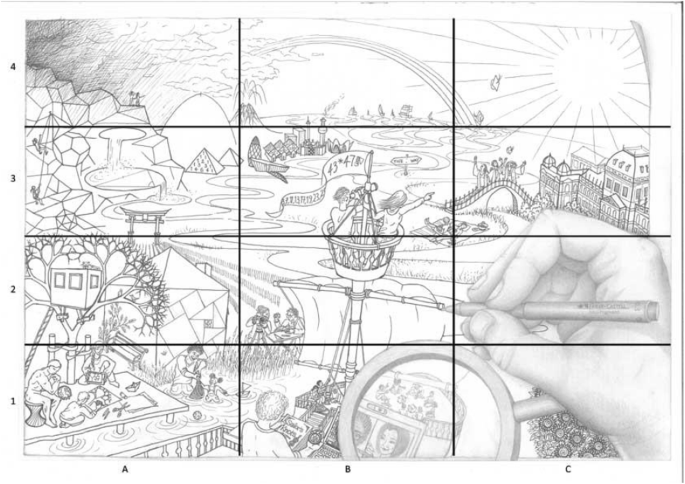
We have divided Fig. 1 in 12 rectangles called A1 (bottom left) up to C4 (top right) to explain the details (for image annotation go to https://www.fisme.science.uu.nl/toepassingen/28937 )
Rights and permissions
Open Access This article is licensed under a Creative Commons Attribution 4.0 International License, which permits use, sharing, adaptation, distribution and reproduction in any medium or format, as long as you give appropriate credit to the original author(s) and the source, provide a link to the Creative Commons licence, and indicate if changes were made. The images or other third party material in this article are included in the article's Creative Commons licence, unless indicated otherwise in a credit line to the material. If material is not included in the article's Creative Commons licence and your intended use is not permitted by statutory regulation or exceeds the permitted use, you will need to obtain permission directly from the copyright holder. To view a copy of this licence, visit http://creativecommons.org/licenses/by/4.0/ .
Reprints and permissions
About this article
Bakker, A., Cai, J. & Zenger, L. Future themes of mathematics education research: an international survey before and during the pandemic. Educ Stud Math 107 , 1–24 (2021). https://doi.org/10.1007/s10649-021-10049-w
Download citation
Accepted : 04 March 2021
Published : 06 April 2021
Issue Date : May 2021
DOI : https://doi.org/10.1007/s10649-021-10049-w
Share this article
Anyone you share the following link with will be able to read this content:
Sorry, a shareable link is not currently available for this article.
Provided by the Springer Nature SharedIt content-sharing initiative
- Grand challenges
- Mathematics education research
- Research agenda
- Find a journal
- Publish with us
- Track your research
Mathematics Research Paper Topics

See our list of mathematics research paper topics . Mathematics is the science that deals with the measurement, properties, and relationships of quantities, as expressed in either numbers or symbols. For example, a farmer might decide to fence in a field and plant oats there. He would have to use mathematics to measure the size of the field, to calculate the amount of fencing needed for the field, to determine how much seed he would have to buy, and to compute the cost of that seed. Mathematics is an essential part of every aspect of life—from determining the correct tip to leave for a waiter to calculating the speed of a space probe as it leaves Earth’s atmosphere.
Academic Writing, Editing, Proofreading, And Problem Solving Services
Get 10% off with 24start discount code.
- Boolean algebra
- Chaos theory
- Complex numbers
- Correlation
- Fraction, common
- Game theory
- Graphs and graphing
- Imaginary number
- Multiplication
- Natural numbers
- Number theory
- Numeration systems
- Probability theory
- Proof (mathematics)
- Pythagorean theorem
- Trigonometry
Mathematics undoubtedly began as an entirely practical activity— measuring fields, determining the volume of liquids, counting out coins, and the like. During the golden era of Greek science, between about the sixth and third centuries B.C., however, mathematicians introduced a new concept to their study of numbers. They began to realize that numbers could be considered as abstract concepts. The number 2, for example, did not necessarily have to mean 2 cows, 2 coins, 2 women, or 2 ships. It could also represent the idea of “two-ness.” Modern mathematics, then, deals both with problems involving specific, concrete, and practical number concepts (25,000 trucks, for example) and with properties of numbers themselves, separate from any practical meaning they may have (the square root of 2 is 1.4142135, for example).
Fields of Mathematics
Mathematics can be subdivided into a number of special categories, each of which can be further subdivided. Probably the oldest branch of mathematics is arithmetic, the study of numbers themselves. Some of the most fascinating questions in modern mathematics involve number theory. For example, how many prime numbers are there? (A prime number is a number that can be divided only by 1 and itself.) That question has fascinated mathematicians for hundreds of years. It doesn’t have any particular practical significance, but it’s an intriguing brainteaser in number theory.
Geometry, a second branch of mathematics, deals with shapes and spatial relationships. It also was established very early in human history because of its obvious connection with practical problems. Anyone who wants to know the distance around a circle, square, or triangle, or the space contained within a cube or a sphere has to use the techniques of geometry.
Algebra was established as mathematicians recognized the fact that real numbers (such as 4 and 5.35) can be represented by letters. It became a way of generalizing specific numerical problems to more general situations.
Analytic geometry was founded in the early 1600s as mathematicians learned to combine algebra and geometry. Analytic geometry uses algebraic equations to represent geometric figures and is, therefore, a way of using one field of mathematics to analyze problems in a second field of mathematics.
Over time, the methods used in analytic geometry were generalized to other fields of mathematics. That general approach is now referred to as analysis, a large and growing subdivision of mathematics. One of the most powerful forms of analysis—calculus—was created almost simultaneously in the early 1700s by English physicist and mathematician Isaac Newton (1642–1727) and German mathematician Gottfried Wilhelm Leibniz (1646–1716). Calculus is a method for analyzing changing systems, such as the changes that take place as a planet, star, or space probe moves across the sky.
Statistics is a field of mathematics that grew in significance throughout the twentieth century. During that time, scientists gradually came to realize that most of the physical phenomena they study can be expressed not in terms of certainty (“A always causes B”), but in terms of probability (“A is likely to cause B with a probability of XX%”). In order to analyze these phenomena, then, they needed to use statistics, the field of mathematics that analyzes the probability with which certain events will occur.
Each field of mathematics can be further subdivided into more specific specialties. For example, topology is the study of figures that are twisted into all kinds of bizarre shapes. It examines the properties of those figures that are retained after they have been deformed.
Back to Science Research Paper Topics .
ORDER HIGH QUALITY CUSTOM PAPER


Exploring Best Math Research Topics That Push the Boundaries
Mathematics is a vast and fascinating field that encompasses a wide range of topics and research areas. Whether you are an undergraduate student, graduate student, or a professional mathematician, engaging in math research opens doors to exploration, discovery, and the advancement of knowledge. The world of math research is filled with exciting challenges, unsolved problems, and groundbreaking ideas waiting to be explored.
In this guide, we will delve into the realm of math research topics, providing you with a glimpse into the diverse areas of mathematical inquiry. From pure mathematics to applied mathematics, this guide will present a variety of research areas that span different branches and interdisciplinary intersections. Whether you are interested in algebra, analysis, geometry, number theory, statistics, or computational mathematics, there is a wealth of captivating topics to consider.
Math research topics are not only intellectually stimulating but also have significant real-world applications. Mathematical discoveries and advancements underpin various fields such as engineering, physics, computer science, finance, cryptography, and data analysis. By immersing yourself in math research, you have the opportunity to contribute to the development of these applications and make a meaningful impact on society.
Throughout this guide, we will explore different research areas, discuss their significance, and provide insights into potential research questions and directions. However, keep in mind that this is not an exhaustive list, and there are countless other exciting topics awaiting exploration.
Embarking on a math research journey requires dedication, perseverance, and a passion for discovery. As you dive into the world of math research, embrace the challenges, seek guidance from mentors and experts, hire a math tutor , and foster a curious and open mindset.. Math research is a dynamic and ever-evolving field, and by engaging in it, you become part of a vibrant community of mathematicians pushing the boundaries of knowledge.
So, let us embark on this exploration of math research topics together, where new ideas, connections, and insights await. Prepare to unravel the mysteries of numbers, patterns, and structures, and embrace the thrill of contributing to the ever-expanding tapestry of mathematical understanding.
What is math research?
Table of Contents
Math research is the process of investigating new mathematical problems and developing new mathematical theories. It is a vital part of mathematics, as it helps to expand our understanding of the world and to develop new mathematical tools that can be used in other fields, such as science, engineering, and technology.
Math research is a challenging but rewarding endeavor. It requires a deep understanding of mathematics and a strong ability to think logically and creatively. Math researchers must be able to identify new problems, develop new ideas, and prove their ideas correct.
There are many different ways to get involved in math research. One way is to attend a math research conference. Another way is to join a math research group. You can also get involved in math research by working on a math research project with a mentor.
Math Research Topics
A few examples of math research topics:
Number theory
Number theory is a branch of mathematics that studies the properties of integers and other related objects. It is a vast and active field of research, with many open problems that have yet to be solved. Some of the current research topics in number theory include:
The Riemann hypothesis
This is one of the most important unsolved problems in mathematics. It states that the non-trivial zeros of the Riemann zeta function have real part 1/2.
The Birch and Swinnerton-Dyer conjecture
This conjecture relates the zeta function of an elliptic curve to the behavior of its rational points.
The Langlands program
This is a vast program in number theory that seeks to unify many different areas of the field.
The classification of finite simple groups
This is a complete classification of all finite simple groups, which are the building blocks of all other finite groups.
The study of cryptography
Number theory is used in many cryptographic algorithms, such as RSA and Diffie-Hellman.
The study of prime numbers
Prime numbers are fundamental to number theory, and there are many open problems related to them, such as the Goldbach conjecture and the twin prime conjecture.
The study of algebraic number theory
This is a branch of number theory that studies the properties of algebraic numbers, which are roots of polynomials with integer coefficients.
The study of combinatoric number theory
This is a branch of number theory that uses tools from combinatorics to study problems in number theory.
The study of computational number theory
This is a branch of number theory that uses computers to solve problems in number theory.
These are just a few of the many research topics in number theory. The field is constantly evolving, and new problems are being discovered all the time.
Topology is a branch of mathematics that studies the properties of spaces that are preserved under continuous deformations. Some of the most important research topics in topology include:
Algebraic topology
This branch of topology studies topological spaces using algebraic tools, such as homology and cohomology. Algebraic topology has been used to great effect in the study of knot theory, 3-manifolds, and other important topological spaces.
Geometric topology
This branch of topology studies topological spaces using geometric tools, such as triangulations and manifolds. Geometric topology has been used to great effect in the study of surfaces, 3-manifolds, and other important topological spaces.
Differential topology
This branch of topology studies topological spaces using differential geometry. Differential topology has been used to great effect in the study of manifolds, including the study of their smooth structures and their underlying topological structures.
Knot theory
This branch of topology studies knots, which are closed curves in 3-space. Knot theory has applications in many other areas of mathematics, including physics, chemistry, and computer science.
Low-dimensional topology
This branch of topology studies topological spaces of low dimension, such as surfaces and 3-manifolds. Low-dimensional topology has been used to great effect in the study of knot theory, 3-manifolds, and other important topological spaces.
Topological quantum field theory
This branch of mathematics studies the relationship between topology and quantum field theory. Topological quantum field theory has applications in many areas of physics, including string theory and quantum gravity.
Topological data analysis
This branch of mathematics studies the use of topological methods to analyze data. Topological data analysis has applications in many areas, including machine learning, computer vision, and bioinformatics.
These are just a few of the many research topics in topology. Topology is a vast and growing field, and there are many exciting new directions for research.
Differential geometry research topics
Differential geometry is a branch of mathematics that studies the geometry of smooth manifolds. Some of the most important research topics in differential geometry include:
Riemannian geometry
This branch of differential geometry studies Riemannian manifolds, which are smooth manifolds equipped with a Riemannian metric. Riemannian geometry has applications in many areas of mathematics, including physics, chemistry, and computer science.
Complex geometry
This branch of differential geometry studies complex manifolds, which are smooth manifolds that are holomorphically equivalent to a complex vector space. Complex geometry has applications in many areas of mathematics, including physics, chemistry, and computer science.
Geometric analysis
This branch of differential geometry studies the interplay between differential geometry and analysis. Geometric analysis has applications in many areas of mathematics, including physics, chemistry, and computer science.
Mathematical physics
This branch of mathematics uses differential geometry to study physical systems. Mathematical physics has applications in many areas of physics, including general relativity, quantum field theory, and string theory.
Computer graphics
This field of computer science uses differential geometry to create realistic images and animations. Computer graphics has applications in many areas, including video games, movies, and simulations.
Medical imaging
This field of medicine uses differential geometry to create images of the human body. Medical imaging has applications in many areas, including diagnosis, treatment, and research.
These are just a few of the many research topics in differential geometry. Differential geometry is a vast and growing field, and there are many exciting new directions for research.
Algebraic geometry research topics
Algebraic geometry is a branch of mathematics that studies geometric objects using the tools of abstract algebra. Some of the most important research topics in algebraic geometry include:
Algebraic curves
This branch of algebraic geometry studies curves, which are one-dimensional algebraic varieties. Algebraic curves have applications in many areas of mathematics, including number theory, representation theory, and mathematical physics.

Algebraic surfaces
This branch of algebraic geometry studies surfaces, which are two-dimensional algebraic varieties. Algebraic surfaces have applications in many areas of mathematics, including topology, differential geometry, and number theory.
Algebraic threefolds
This branch of algebraic geometry studies threefolds, which are three-dimensional algebraic varieties. Algebraic threefolds have applications in many areas of mathematics, including topology, differential geometry, and number theory.
Algebraic varieties
This branch of algebraic geometry studies varieties, which are arbitrary-dimensional algebraic sets. Algebraic varieties have applications in many areas of mathematics, including topology, differential geometry, and number theory.
Algebraic groups
This branch of algebraic geometry studies groups that are also algebraic varieties. Algebraic groups have applications in many areas of mathematics, including number theory, representation theory, and mathematical physics.
Moduli spaces
This branch of algebraic geometry studies moduli spaces, which are spaces that parameterize objects of a certain type. Moduli spaces have applications in many areas of mathematics, including number theory, representation theory, and mathematical physics.
Arithmetic geometry
This branch of algebraic geometry studies the intersection of algebraic geometry and number theory. Arithmetic geometry has applications in many areas of mathematics, including number theory, representation theory, and mathematical physics.
Complex algebraic geometry
This branch of algebraic geometry studies algebraic varieties over the complex numbers. Complex algebraic geometry has applications in many areas of mathematics, including topology, differential geometry, and mathematical physics.
Algebraic combinatorics
This branch of algebraic geometry studies the intersection of algebraic geometry and combinatorics. Algebraic combinatorics has applications in many areas of mathematics, including combinatorics, computer science, and mathematical physics.
These are just a few of the many research topics in algebraic geometry. Algebraic geometry is a vast and growing field, and there are many exciting new directions for research.
Mathematical physics research topics
Mathematical physics is a field of study that uses the tools of mathematics to study physical systems. Some of the most important research topics in mathematical physics include:
Quantum mechanics
This branch of physics studies the behavior of matter and energy at the atomic and subatomic level. Quantum mechanics has applications in many areas of physics, including chemistry, biology, and engineering.
This branch of physics studies the relationship between space and time. Relativity has applications in many areas of physics, including cosmology, astrophysics, and nuclear physics.
Statistical mechanics
This branch of physics studies the behavior of systems of many particles. Statistical mechanics has applications in many areas of physics, including thermodynamics, chemistry, and biology.
Chaos theory
This branch of physics studies the behavior of systems that are sensitive to initial conditions. Chaos theory has applications in many areas of physics, including meteorology, economics, and biology.
Mathematical finance
This field of mathematics uses the tools of mathematics to study financial markets. Mathematical finance has applications in many areas of finance, including investment banking, insurance, and risk management.
Computational physics
This field of mathematics uses the tools of mathematics to solve physical problems. Computational physics has applications in many areas of physics, including materials science, engineering, and medicine.
Mathematical biology
This field of mathematics uses the tools of mathematics to study biological systems. Mathematical biology has applications in many areas of biology, including genetics, ecology, and evolution.
Mathematical chemistry
This field of mathematics uses the tools of mathematics to study chemical systems. Mathematical chemistry has applications in many areas of chemistry, including materials science, biochemistry, and pharmacology.
Mathematical engineering
This field of mathematics uses the tools of mathematics to study engineering systems. Mathematical engineering has applications in many areas of engineering, including civil engineering, mechanical engineering, and electrical engineering.
These are just a few of the many research topics in mathematical physics. Mathematical physics is a vast and growing field, and there are many exciting new directions for research.
Mathematical biology research topics
Mathematical biology is a field of study that uses the tools of mathematics to study biological systems. Some of the most important research topics in mathematical biology include:
Modeling of biological systems
This branch of mathematical biology uses mathematical models to study the behavior of biological systems. Mathematical models can be used to understand the dynamics of biological systems, to predict how they will respond to changes in their environment, and to design new interventions to improve their health.
Computational biology
This field of mathematical biology uses computational methods to study biological systems. Computational methods can be used to analyze large amounts of biological data, to simulate biological systems, and to design new experiments.
Biostatistics
This field of mathematical biology uses statistical methods to study biological data. Biostatistical methods can be used to identify patterns in biological data, to test hypotheses about biological systems, and to design clinical trials.
Mathematical epidemiology
This field of mathematical biology uses mathematical models to study the spread of diseases. Mathematical models can be used to predict the course of an epidemic, to design public health interventions, and to assess the effectiveness of those interventions.
Mathematical ecology
This field of mathematical biology uses mathematical models to study the interactions between species in an ecosystem. Mathematical models can be used to predict how ecosystems will respond to changes in their environment, to design conservation strategies, and to assess the effectiveness of those strategies.
Mathematical neuroscience
This field of mathematical biology uses mathematical models to study the nervous system. Mathematical models can be used to understand how the nervous system works, to design new treatments for neurological disorders, and to assess the effectiveness of those treatments.
Mathematical genetics
This field of mathematical biology uses mathematical models to study genetics. Mathematical models can be used to understand how genes work, to design new treatments for genetic disorders, and to assess the effectiveness of those treatments.
Mathematical evolution
This field of mathematical biology uses mathematical models to study evolution. Mathematical models can be used to understand how evolution works, to design new conservation strategies, and to assess the effectiveness of those strategies.
These are just a few of the many research topics in mathematical biology. Mathematical biology is a vast and growing field, and there are many exciting new directions for research.
Mathematical finance research topics
Mathematical finance is a field of study that uses the tools of mathematics to study financial markets. Some of the most important research topics in mathematical finance include:
Asset pricing
This branch of mathematical finance studies the prices of assets, such as stocks, bonds, and options. Asset pricing models are used to price new financial products, to manage risk, and to make investment decisions.
Portfolio optimization
This branch of mathematical finance studies how to allocate money between different assets in a portfolio. Portfolio optimization models are used to maximize returns, to minimize risk, and to achieve other investment goals.
Derivative pricing
This branch of mathematical finance studies the prices of derivatives, such as options and futures. Derivatives are used to hedge risk, to speculate on future prices, and to generate income.
Risk management
This branch of mathematical finance studies how to measure and manage risk. Risk management models are used to identify and quantify risks, to develop strategies to mitigate risks, and to comply with regulations.
Market microstructure
This branch of mathematical finance studies the structure and dynamics of financial markets. Market microstructure models are used to understand how markets work, to design new trading systems, and to improve market efficiency.
Financial econometrics
This branch of mathematical finance uses statistical methods to study financial data. Financial econometrics models are used to identify patterns in financial data, to test hypotheses about financial markets, and to forecast future prices.
Computational finance
This field of mathematical finance uses computational methods to solve financial problems. Computational finance methods are used to price financial products, to manage risk, and to simulate financial markets.
Mathematical finance and machine learning
This field of mathematical finance uses machine learning methods to study financial markets and to make financial predictions. Machine learning methods are used to identify patterns in financial data, to predict future prices, and to develop new trading strategies.
These are just a few of the many research topics in mathematical finance. Mathematical finance is a vast and growing field, and there are many exciting new directions for research.
Numerical analysis research topics
Numerical analysis is a branch of mathematics that deals with the approximation of functions and solutions to differential equations using numerical methods. Some of the most important research topics in numerical analysis include:
Error analysis
This branch of numerical analysis studies the errors that are introduced when approximate solutions are used to represent exact solutions. Error analysis is used to design numerical methods that are accurate and efficient.
Stability analysis
This branch of numerical analysis studies the stability of numerical methods. Stability analysis is used to design numerical methods that are guaranteed to converge to the correct solution.
Convergence analysis
This branch of numerical analysis studies the convergence of numerical methods. Convergence analysis is used to design numerical methods that will converge to the correct solution in a finite number of steps.
Adaptive methods
This branch of numerical analysis studies adaptive methods. Adaptive methods are numerical methods that can automatically adjust their step size or mesh size to improve accuracy.
Parallel methods
This branch of numerical analysis studies parallel methods. Parallel methods are numerical methods that can be used to solve problems on multiple processors.
Heterogeneous computing
This branch of numerical analysis studies heterogeneous computing. Heterogeneous computing is the use of multiple processors with different architectures to solve problems.
Nonlinear problems
This branch of numerical analysis studies nonlinear problems. Nonlinear problems are problems that cannot be solved using linear methods.
Optimization
This branch of numerical analysis studies methods for finding the best solution to a problem. Optimization methods are used to find the best parameters for a numerical method, to find the best solution to a problem, and to find the best way to solve a problem.
Scientific computing
This branch of numerical analysis studies the use of numerical methods to solve problems in science and engineering. Scientific computing is used to solve problems in areas such as physics, chemistry, biology, and engineering.
This branch of numerical analysis studies the use of numerical methods to solve problems in physics. Computational physics is used to solve problems in areas such as fluid dynamics, solid mechanics, and quantum mechanics.
Computational chemistry
This branch of numerical analysis studies the use of numerical methods to solve problems in chemistry. Computational chemistry is used to solve problems in areas such as molecular dynamics, quantum chemistry, and materials science.
This branch of numerical analysis studies the use of numerical methods to solve problems in biology. Computational biology is used to solve problems in areas such as genetics, molecular biology, and neuroscience.
These are just a few of the many research topics in numerical analysis. Numerical analysis is a vast and growing field, and there are many exciting new directions for research.
Probability research topics
Probability is a branch of mathematics that deals with the analysis of random phenomena. Some of the most important research topics in probability include:
Foundations of probability
This branch of probability studies the axioms and foundations of probability theory. Foundations of probability is important for understanding the basic concepts of probability and for developing new probability theories.
Stochastic processes
This branch of probability studies the evolution of random phenomena over time. Stochastic processes are used to model a wide variety of phenomena, such as stock prices, traffic patterns, and disease outbreaks.
Random graphs
This branch of probability studies graphs whose vertices and edges are chosen randomly. Random graphs are used to model a wide variety of networks, such as social networks, computer networks, and biological networks.
Markov chains
This branch of probability studies stochastic processes whose future state depends only on its current state. Markov chains are used to model a wide variety of phenomena, such as queuing systems, genetics, and epidemiology.
Queueing theory
This branch of probability studies the behavior of queues. Queues are used to model a wide variety of systems, such as call centers, hospitals, and traffic systems.
Optimal stopping theory
This branch of probability studies the problem of choosing when to stop a stochastic process. Optimal stopping theory is used to make decisions in a wide variety of situations, such as gambling, investing, and medical diagnosis.
Information theory
This branch of probability studies the quantification and manipulation of information. Information theory is used in a wide variety of fields, such as communication, cryptography, and machine learning.
Computational probability
This branch of probability studies the use of computers to solve probability problems. Computational probability is used to solve a wide variety of problems, such as simulating random phenomena, computing probabilities, and designing algorithms .
Applied probability
This branch of probability studies the use of probability in other fields, such as physics, chemistry, biology, and economics. Applied probability is used to solve a wide variety of problems in these fields.
These are just a few of the many research topics in probability. Probability is a vast and growing field, and there are many exciting new directions for research.
Statistics research topics
Statistics is a field of study that deals with the collection, analysis, interpretation, presentation, and organization of data. Some of the most important research topics in statistics include:
This branch of statistics studies the analysis of large and complex datasets. Big data is used in a wide variety of fields, such as business, finance, healthcare, and government.
Machine learning
This branch of statistics studies the development of algorithms that can learn from data without being explicitly programmed. Machine learning is used in a wide variety of fields, such as natural language processing, computer vision, and fraud detection.
Data mining
This branch of statistics studies the extraction of knowledge from data. Data mining is used in a wide variety of fields, such as marketing, customer relationship management, and fraud detection.
Bayesian statistics
This branch of statistics uses Bayes’ theorem to update beliefs in the face of new evidence. Bayesian statistics is used in a wide variety of fields, such as medical diagnosis, finance, and weather forecasting.
Nonparametric statistics
This branch of statistics uses methods that do not make assumptions about the distribution of the data. Nonparametric statistics is used in a wide variety of fields, such as social science, medical research, and environmental science.
Multivariate statistics
This branch of statistics studies the analysis of data that has multiple variables. Multivariate statistics is used in a wide variety of fields, such as marketing, finance, and environmental science.
Time series analysis
This branch of statistics studies the analysis of data that changes over time. Time series analysis is used in a wide variety of fields, such as economics, finance, and meteorology.
Survival analysis
This branch of statistics studies the analysis of data that records the time until an event occurs. Survival analysis is used in a wide variety of fields, such as medical research, epidemiology, and finance.
Quality control
This branch of statistics studies the methods used to ensure that products or services meet a certain level of quality. Quality control is used in a wide variety of fields, such as manufacturing, healthcare, and government.
These are just a few of the many research topics in statistics. Statistics is a vast and growing field, and there are many exciting new directions for research.
How to find math research topics
Here are some tips on how to find math research topics:
Talk to your professors and advisors
They will be able to give you insights into current research in your area of interest and help you identify potential topics.
Read math journals and conferences
This will help you stay up-to-date on the latest research and identify areas where you could make a contribution.
Attend math conferences and workshops
This is a great way to meet other mathematicians and learn about their research.
Think about your own interests and passions
What are you curious about? What do you want to learn more about? These can be great starting points for research topics.
Don’t be afraid to ask for help. If you’re struggling to find a research topic, talk to your professors, advisors, or other mathematicians. They will be happy to help you get started.
How to get started with math research
Getting started with math research can be daunting, but it doesn’t have to be. Here are some tips to help you get started:
Find a mentor
A mentor can help you find a research topic, develop your research skills, and navigate the research process. Talk to your professors, advisors, or other mathematicians to find someone who is interested in your research interests.
Do your research
Read articles, books, and papers on your topic. Talk to experts in the field. The more you know about your topic, the better equipped you will be to conduct research.
Develop a research plan
A research plan will help you stay organized and on track. It should include your research goals, methods, and timeline.
Research can be a slow and challenging process. Don’t get discouraged if you don’t make progress immediately. Just keep working hard and you will eventually reach your goals.
Start small
Don’t try to tackle too much at once. Start with a small research project that you can complete in a reasonable amount of time.
Get feedback
Share your work with others and get their feedback. This will help you identify areas where you can improve.
Don’t be afraid to ask for help
If you’re struggling with something, don’t be afraid to ask for help from your mentor, advisor, or other mathematicians.
Research can be a rewarding experience. By following these tips, you can increase your chances of success.
In conclusion, exploring math research topics provides an opportunity to delve into the fascinating world of mathematics and contribute to its advancement.
The wide range of potential research areas ensures that there is something for everyone, whether you are interested in pure mathematics, applied mathematics, or interdisciplinary studies. By engaging in math research, you can deepen your understanding of mathematical principles, develop problem-solving skills, and contribute to the collective knowledge of the field.
Remember to choose a research topic that aligns with your interests and goals, and seek guidance from mentors and experts in the field to maximize your research potential. Embrace the challenge, curiosity, and creativity that math research offers, and embark on a journey that can lead to exciting discoveries and breakthroughs in the realm of mathematics.
Frequently Asked Question
How do i choose a math research topic.
When choosing a math research topic, consider your interests, background knowledge, and future goals. Explore various branches of mathematics and identify areas that intrigue you. Additionally, consult with professors, mentors, and professionals in the field for guidance and suggestions.
Can I pursue research in math as an undergraduate student?
Yes, many universities and research institutions offer opportunities for undergraduate students to engage in math research. Reach out to your professors or department advisors to inquire about available research programs or projects suitable for undergraduates.
What are some emerging areas in math research?
Math research is a constantly evolving field. Some emerging areas include computational mathematics, data science, cryptography, mathematical biology, quantum computing, and mathematical physics. Staying updated with current research trends and attending conferences or seminars can help you identify new and exciting research avenues.
How can I conduct math research effectively?
Effective math research involves a systematic approach. Start by thoroughly understanding the existing literature on your chosen topic. Develop clear research questions and hypotheses, and apply appropriate mathematical techniques and methodologies.
Can math research have real-world applications?
Absolutely! Math research has numerous real-world applications in fields such as engineering, finance, computer science, cryptography, data analysis, and physics. Mathematical models and algorithms play a crucial role in solving complex problems and optimizing various processes in diverse industries.
What resources can I use for math research?
Utilize academic journals, online databases, research papers, books, and mathematical software to access relevant information and tools. Libraries, online platforms, and research institutions also provide access to valuable resources and databases specific to mathematical research.
Similar Articles

How To Do Homework Fast – 11 Tips To Do Homework Fast
Homework is one of the most important parts that have to be done by students. It has been around for…

How to Write an Assignment Introduction – 6 Best Tips
In essence, the writing tasks in academic tenure students are an integral part of any curriculum. Whether in high school,…
Leave a Comment Cancel Reply
Your email address will not be published. Required fields are marked *
This site uses Akismet to reduce spam. Learn how your comment data is processed .
- Welcome from the Chair
- Michalik Distinguished Lecture Series
- Open Faculty Positions
- Advising & Support
- Calculus Curriculum
- Degree Programs/Requirements
- Extracurricular Activities
- Math Placement Assessment
- Math Assistance Center/Posvar Computing Lab
- Research/Career Opportunities
- Admissions & Financial Aid
- Degree Programs
- Graduate Employment
- Graduate Handbook
- Information for Incoming Graduate Students
- Organizations
- Research Opportunities
- Teaching Opportunities
Research Areas
- Graduate Research
- Undergraduate Research
- Mathematics Research Center
- Technical Reports
- Publications
- Gallery of Research Images
- Faculty Admin
- Adjunct Faculty
- Part-Time Faculty
- Emeritus Faculty
- Post-Doctoral Associates
- Graduate Students
- Stay in Touch
- Newsletter Archive
- Upcoming Events
- Past Events
- Prospective Students
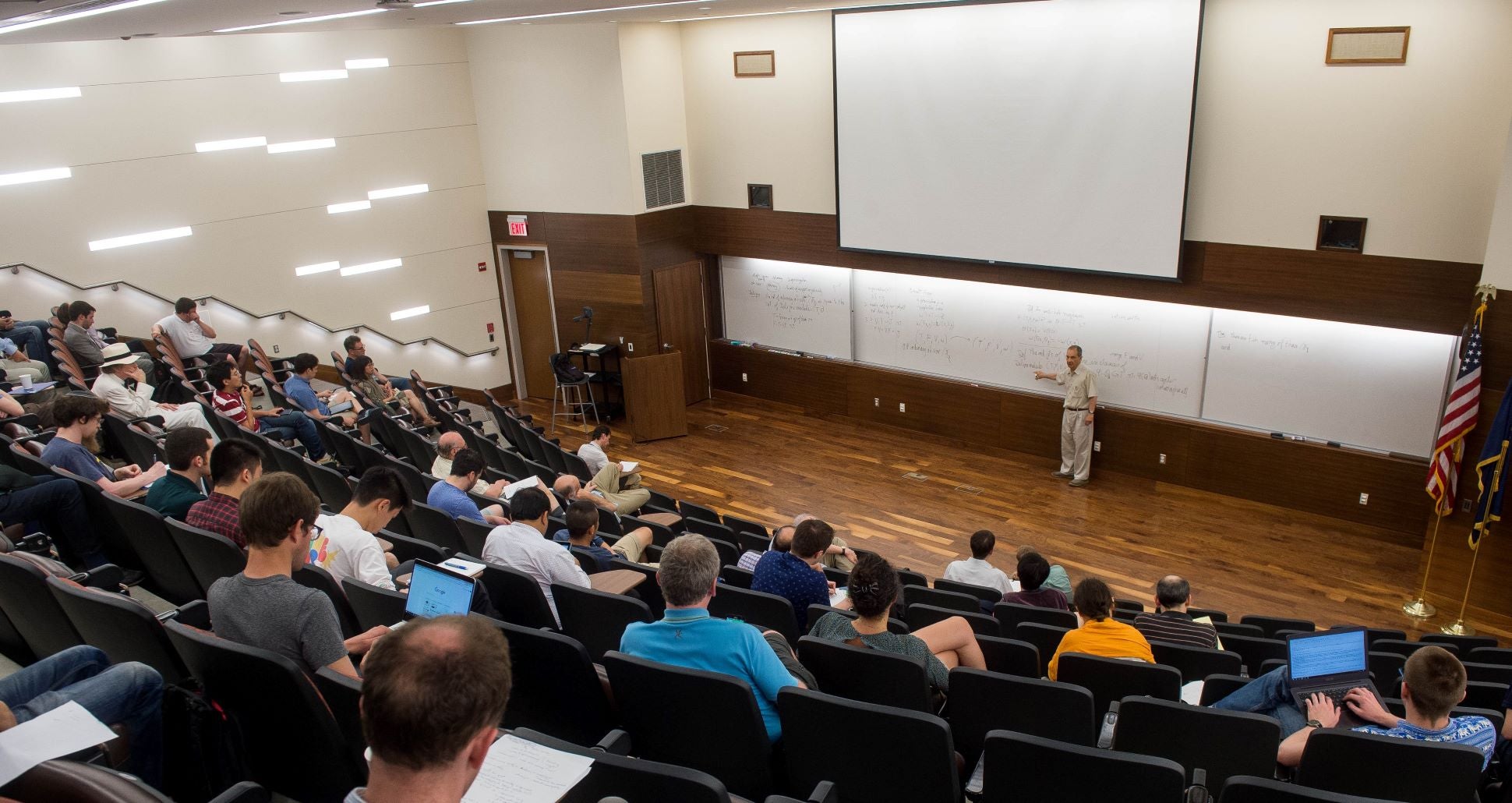
Department members engage in cutting-edge research on a wide variety of topics in mathematics and its applications. Topics continually evolve to reflect emerging interests and developments, but can roughly grouped into the following areas.
Algebra, Combinatorics, and Geometry
Algebra, combinatorics, and geometry are areas of very active research at the University of Pittsburgh.
Analysis and Partial Differential Equations
The research of the analysis group covers functional analysis, harmonic analysis, several complex variables, partial differential equations, and analysis on metric and Carnot-Caratheodory spaces.
Applied Analysis
The department is a leader in the analysis of systems of nonlinear differential equations and dynamical systems that arise in modeling a variety of physical phenomena. They include problems in biology, chemistry, phase transitions, fluid flow, flame propagation, diffusion processes, and pattern formation in nonlinear stochastic partial differential equations.
Mathematical Biology
The biological world stands as the next great frontier for mathematical modeling and analysis. This group studies complex systems and dynamics arising in various biological phenomena.
Mathematical Finance
A rapidly growing area of mathematical finance is Quantitative Behavioral Finance. The high-tech boom and bust of the late 1990s followed by the housing and financial upheavals of 2008 have made a convincing case for the necessity of adopting broader assumptions in finance.
Numerical Analysis and Scientific Computing
The diversity of this group is reflected in its research interests: numerical analysis of partial differential equations , adaptive methods for scientific computing, computational methods of fluid dynamics and turbulence, numerical solution of nonlinear problems arising from porous media flow and transport, optimal control, and simulation of stochastic reaction diffusion systems.
Topology and Differential Geometry
Research in analytic topology continues in the broad area of generalized metric spaces. This group studies relativity theory and differential geometry, with emphasis on twistor methods, as well as geometric and topological aspects of quantum field theory, string theory, and M-theory.
all the numbers are changing, but what doesn't change is the relationship between x and y: y is always one more than twice x. That is, y=2x+1. Finding what doesn't change "tames" the situation. So, you have tamed this problem! Yay. And if you want a fancy mathematical name for things that don’t vary, we call these things "invariants." The number of messed-up recruits is invariant, even though they are all wiggling back and forth, trying to figure out which way is right!
3) Encourage generalizations
So, of course, the next question that comes to my mind is how to generalize what you’ve already discovered: there are 15 ways that 2 mistakes can be arranged in a line of 6 recruits. What about a different number of mistakes? Or a different number of recruits? Is there some way to predict? Or, alternatively, is there some way to predict how these 15 ways of making mistakes will play out as the recruits try to settle themselves down? Which direction interests you?
4) Inquire about reasoning and rigor
The students were looking at the number of ways the recruits could line up with 2 out of n faced the wrong way: Anyway, I had a question of my own. It looks like the number of possibilities increases pretty fast, as the number of recruits increases. For example, I counted 15 possibilities in your last set (the line of six). What I wonder is this: when the numbers get that large, how you can possibly know that you've found all the possibilities? (For example, I noticed that >>>><< is missing.) The question "How do I know I've counted 'em all?" is actually quite a big deal in mathematics, as mathematicians are often called upon to find ways of counting things that nobody has ever listed (exactly like the example you are working on).
The students responded by finding a pattern for generating the lineups in a meaningful order: The way that we can prove that we have all the possibilities is that we can just add the number of places that the second wrong person could be in. For example, if 2 are wrong in a line of 6, then the first one doesn’t move and you count the space in which the second one can move in. So for the line of six, it would be 5+4+3+2+1=15. That is the way to make sure that we have all the ways. Thanks so much for giving challenges. We enjoyed thinking!
5) Work towards proof
a) The group wrote the following: When we found out that 6 recruits had 15 different starting arrangements, we needed more information. We needed to figure out how many starting positions are there for a different number of recruits.
By drawing out the arrangements for 5 recruits and 7 recruits we found out that the number of starting arrangements for the recruit number before plus that recruit number before it would equal the number of starting arrangements for that number of recruits.
We also found out that if you divide the starting arrangements by the number of recruits there is a pattern.
To which the mentor replied: Wow! I don't think (in all the years I've been hanging around mathematics) I've ever seen anyone describe this particular pattern before! Really nice! If you already knew me, you'd be able to predict what I'm about to ask, but you don't, so I have to ask it: "But why?" That is, why is this pattern (the 6, 10, 15, 21, 28…) the pattern that you find for this circumstance (two recruits wrong in lines of lengths, 4, 5, 6, 7, 8…)? Answering that—explaining why you should get those numbers and why the pattern must continue for longer lines—is doing the kind of thing that mathematics is really about.
b) Responding to students studying a circular variation of raw recruits that never settled down: This is a really interesting conclusion! How can you show that it will always continue forever and that it doesn’t matter what the original arrangement was? Have you got a reason or did you try all the cases or…? I look forward to hearing more from you.
6) Distinguish between examples and reasons
a) You have very thoroughly dealt with finding the answer to the problem you posed—it really does seem, as you put it, "safe to say" how many there will be. Is there a way that you can show that that pattern must continue? I guess I’d look for some reason why adding the new recruit adds exactly the number of additional cases that you predict. If you could say how the addition of one new recruit depends on how long the line already is, you’d have a complete proof. Want to give that a try?
b) A student, working on Amida Kuji and having provided an example, wrote the following as part of a proof: In like manner, to be given each relationship of objects in an arrangement, you can generate the arrangement itself, for no two different arrangements can have the same object relationships. The mentor response points out the gap and offers ways to structure the process of extrapolating from the specific to the general: This statement is the same as your conjecture, but this is not a proof. You repeat your claim and suggest that the example serves as a model for a proof. If that is so, it is up to you to make the connections explicit. How might you prove that a set of ordered pairs, one per pair of objects forces a unique arrangement for the entire list? Try thinking about a given object (e.g., C) and what each of its ordered pairs tells us? Try to generalize from your example. What must be true for the set of ordered pairs? Are all sets of n C2 ordered pairs legal? How many sets of n C2 ordered pairs are there? Do they all lead to a particular arrangement? Your answers to these questions should help you work toward a proof of your conjecture.
9) Encourage extensions
What you’ve done—finding the pattern, but far more important, finding the explanation (and stating it so clearly)—is really great! (Perhaps I should say "finding and stating explanations like this is real mathematics"!) Yet it almost sounded as if you put it down at the very end, when you concluded "making our project mostly an interesting coincidence." This is a truly nice piece of work!
The question, now, is "What next?" You really have completely solved the problem you set out to solve: found the answer, and proved that you’re right!
I began looking back at the examples you gave, and noticed patterns in them that I had never seen before. At first, I started coloring parts red, because they just "stuck out" as noticeable and I wanted to see them better. Then, it occurred to me that I was coloring the recruits that were back-to-back, and that maybe I should be paying attention to the ones who were facing each other, as they were "where the action was," so I started coloring them pink. (In one case, I recopied your example to do the pinks.) To be honest, I’m not sure what I’m looking for, but there was such a clear pattern of the "action spot" moving around that I thought it might tell me something new. Anything come to your minds?
10) Build a Mathematical Community
I just went back to another paper and then came back to yours to look again. There's another pattern in the table. Add the recruits and the corresponding starting arrangements (for example, add 6 and 15) and you get the next number of starting arrangements. I don't know whether this, or your 1.5, 2, 2.5, 3, 3.5… pattern will help you find out why 6, 10, 15… make sense as answers, but they might. Maybe you can work with [your classmates] who made the other observation to try to develop a complete understanding of the problem.
11) Highlight Connections
Your rule—the (n-1)+(n-2)+(n-3)+… +3+2+1 part—is interesting all by itself, as it counts the number of dots in a triangle of dots. See how?
12) Wrap Up
This is really a very nice and complete piece of work: you've stated a problem, found a solution, and given a proof (complete explanation of why that solution must be correct). To wrap it up and give it the polish of a good piece of mathematical research, I'd suggest two things.
The first thing is to extend the idea to account for all but two mistakes and the (slightly trivial) one mistake and all but one mistake. (If you felt like looking at 3 and all but 3, that'd be nice, too, but it's more work—though not a ton—and the ones that I suggested are really not more work.)
The second thing I'd suggest is to write it all up in a way that would be understandable by someone who did not know the problem or your class: clear statement of the problem, the solution, what you did to get the solution, and the proof.
I look forward to seeing your masterpiece!
Advice for Keeping a Formal Mathematics Research Logbook
As part of your mathematics research experience, you will keep a mathematics research logbook. In this logbook, keep a record of everything you do and everything you read that relates to this work. Write down questions that you have as you are reading or working on the project. Experiment. Make conjectures. Try to prove your conjectures. Your journal will become a record of your entire mathematics research experience. Don’t worry if your writing is not always perfect. Often journal pages look rough, with notes to yourself, false starts, and partial solutions. However, be sure that you can read your own notes later and try to organize your writing in ways that will facilitate your thinking. Your logbook will serve as a record of where you are in your work at any moment and will be an invaluable tool when you write reports about your research.
Ideally, your mathematics research logbook should have pre-numbered pages. You can often find numbered graph paper science logs at office supply stores. If you can not find a notebook that has the pages already numbered, then the first thing you should do is go through the entire book putting numbers on each page using pen.
• Date each entry.
• Work in pen.
• Don’t erase or white out mistakes. Instead, draw a single line through what you would like ignored. There are many reasons for using this approach:
– Your notebook will look a lot nicer if it doesn’t have scribbled messes in it.
– You can still see what you wrote at a later date if you decide that it wasn’t a mistake after all.
– It is sometimes useful to be able to go back and see where you ran into difficulties.
– You’ll be able to go back and see if you already tried something so you won’t spend time trying that same approach again if it didn’t work.
• When you do research using existing sources, be sure to list the bibliographic information at the start of each section of notes you take. It is a lot easier to write down the citation while it is in front of you than it is to try to find it at a later date.
• Never tear a page out of your notebook. The idea is to keep a record of everything you have done. One reason for pre-numbering the pages is to show that nothing has been removed.
• If you find an interesting article or picture that you would like to include in your notebook, you can staple or tape it onto a page.
Advice for Keeping a Loose-Leaf Mathematics Research Logbook
Get yourself a good loose-leaf binder, some lined paper for notes, some graph paper for graphs and some blank paper for pictures and diagrams. Be sure to keep everything that is related to your project in your binder.
– Your notebook will look a lot nicer if it does not have scribbled messes in it.
• Be sure to keep everything related to your project. The idea is to keep a record of everything you have done.
• If you find an interesting article or picture that you would like to include in your notebook, punch holes in it and insert it in an appropriate section in your binder.
Making Mathematics Home | Mathematics Projects | Students | Teachers | Mentors | Parents | Hard Math Café |
Help | Advanced Search
Mathematics > Statistics Theory
Title: adaptive estimation of the $\mathbb{l}_2$-norm of a probability density and related topics ii. upper bounds via the oracle approach.
Abstract: This is the second part of the research project initiated in Cleanthous et al (2024). We deal with the problem of the adaptive estimation of the $\mathbb{L}_2$-norm of a probability density on $\mathbb{R}^d$, $d\geq 1$, from independent observations. The unknown density is assumed to be uniformly bounded by unknown constant and to belong to the union of balls in the isotropic/anisotropic Nikolskii's spaces. In Cleanthous et al (2024) we have proved that the optimally adaptive estimators do no exist in the considered problem and provided with several lower bounds for the adaptive risk. In this part we show that these bounds are tight and present the adaptive estimator which is obtained by a data-driven selection from a family of kernel-based estimators. The proposed estimation procedure as well as the computation of its risk are heavily based on new concentration inequalities for decoupled $U$-statistics of order two established in Section 4. It is also worth noting that all our results are derived from the unique oracle inequality which may be of independent interest.
Submission history
Access paper:.
- HTML (experimental)
- Other Formats
References & Citations
- Google Scholar
- Semantic Scholar
BibTeX formatted citation
Bibliographic and Citation Tools
Code, data and media associated with this article, recommenders and search tools.
- Institution
arXivLabs: experimental projects with community collaborators
arXivLabs is a framework that allows collaborators to develop and share new arXiv features directly on our website.
Both individuals and organizations that work with arXivLabs have embraced and accepted our values of openness, community, excellence, and user data privacy. arXiv is committed to these values and only works with partners that adhere to them.
Have an idea for a project that will add value for arXiv's community? Learn more about arXivLabs .
Pure Mathematics Research
Pure mathematics fields.
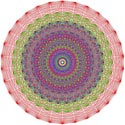
- Algebra & Algebraic Geometry
- Algebraic Topology
- Analysis & PDEs
- Geometry & Topology
- Mathematical Logic & Foundations
- Number Theory
- Probability & Statistics
- Representation Theory
Pure Math Committee
Suggestions or feedback?
MIT News | Massachusetts Institute of Technology
- Machine learning
- Social justice
- Black holes
- Classes and programs
Departments
- Aeronautics and Astronautics
- Brain and Cognitive Sciences
- Architecture
- Political Science
- Mechanical Engineering
Centers, Labs, & Programs
- Abdul Latif Jameel Poverty Action Lab (J-PAL)
- Picower Institute for Learning and Memory
- Lincoln Laboratory
- School of Architecture + Planning
- School of Engineering
- School of Humanities, Arts, and Social Sciences
- Sloan School of Management
- School of Science
- MIT Schwarzman College of Computing
The origin of the sun’s magnetic field could lie close to its surface
Press contact :, media download.

*Terms of Use:
Images for download on the MIT News office website are made available to non-commercial entities, press and the general public under a Creative Commons Attribution Non-Commercial No Derivatives license . You may not alter the images provided, other than to crop them to size. A credit line must be used when reproducing images; if one is not provided below, credit the images to "MIT."

Previous image Next image
The sun’s surface is a brilliant display of sunspots and flares driven by the solar magnetic field, which is internally generated through a process called dynamo action. Astrophysicists have assumed that the sun’s field is generated deep within the star. But an MIT study finds that the sun’s activity may be shaped by a much shallower process.
In a paper appearing today in Nature , researchers at MIT, the University of Edinburgh, and elsewhere find that the sun’s magnetic field could arise from instabilities within the sun’s outermost layers.
The team generated a precise model of the sun’s surface and found that when they simulated certain perturbations, or changes in the flow of plasma (ionized gas) within the top 5 to 10 percent of the sun, these surface changes were enough to generate realistic magnetic field patterns, with similar characteristics to what astronomers have observed on the sun. In contrast, their simulations in deeper layers produced less realistic solar activity.
The findings suggest that sunspots and flares could be a product of a shallow magnetic field, rather than a field that originates deeper in the sun, as scientists had largely assumed.
“The features we see when looking at the sun, like the corona that many people saw during the recent solar eclipse, sunspots, and solar flares, are all associated with the sun’s magnetic field,” says study author Keaton Burns, a research scientist in MIT’s Department of Mathematics. “We show that isolated perturbations near the sun’s surface, far from the deeper layers, can grow over time to potentially produce the magnetic structures we see.”
If the sun’s magnetic field does in fact arise from its outermost layers, this might give scientists a better chance at forecasting flares and geomagnetic storms that have the potential to damage satellites and telecommunications systems.
“We know the dynamo acts like a giant clock with many complex interacting parts,” says co-author Geoffrey Vasil, a researcher at the University of Edinburgh. “But we don't know many of the pieces or how they fit together. This new idea of how the solar dynamo starts is essential to understanding and predicting it.”
The study’s co-authors also include Daniel Lecoanet and Kyle Augustson of Northwestern University, Jeffrey Oishi of Bates College, Benjamin Brown and Keith Julien of the University of Colorado at Boulder, and Nicholas Brummell of the University of California at Santa Cruz.
The sun is a white-hot ball of plasma that’s boiling on its surface. This boiling region is called the “convection zone,” where layers and plumes of plasma roil and flow. The convection zone comprises the top one-third of the sun’s radius and stretches about 200,000 kilometers below the surface.
“One of the basic ideas for how to start a dynamo is that you need a region where there’s a lot of plasma moving past other plasma, and that shearing motion converts kinetic energy into magnetic energy,” Burns explains. “People had thought that the sun’s magnetic field is created by the motions at the very bottom of the convection zone.”
To pin down exactly where the sun’s magnetic field originates, other scientists have used large three-dimensional simulations to try to solve for the flow of plasma throughout the many layers of the sun’s interior. “Those simulations require millions of hours on national supercomputing facilities, but what they produce is still nowhere near as turbulent as the actual sun,” Burns says.
Rather than simulating the complex flow of plasma throughout the entire body of the sun, Burns and his colleagues wondered whether studying the stability of plasma flow near the surface might be enough to explain the origins of the dynamo process.
To explore this idea, the team first used data from the field of “helioseismology,” where scientists use observed vibrations on the sun’s surface to determine the average structure and flow of plasma beneath the surface.
“If you take a video of a drum and watch how it vibrates in slow motion, you can work out the drumhead’s shape and stiffness from the vibrational modes,” Burns says. “Similarly, we can use vibrations that we see on the solar surface to infer the average structure on the inside.”
Solar onion
For their new study, the researchers collected models of the sun’s structure from helioseismic observations. “These average flows look sort like an onion, with different layers of plasma rotating past each other,” Burns explains. “Then we ask: Are there perturbations, or tiny changes in the flow of plasma, that we could superimpose on top of this average structure, that might grow to cause the sun’s magnetic field?”
To look for such patterns, the team utilized the Dedalus Project — a numerical framework that Burns developed that can simulate many types of fluid flows with high precision. The code has been applied to a wide range of problems, from modeling the dynamics inside individual cells, to ocean and atmospheric circulations.
“My collaborators have been thinking about the solar magnetism problem for years, and the capabilities of Dedalus have now reached the point where we could address it,” Burns says.
The team developed algorithms that they incorporated into Dedalus to find self-reinforcing changes in the sun’s average surface flows. The algorithm discovered new patterns that could grow and result in realistic solar activity. In particular, the team found patterns that match the locations and timescales of sunspots that have been have observed by astronomers since Galileo in 1612.
Sunspots are transient features on the surface of the sun that are thought to be shaped by the sun’s magnetic field. These relatively cooler regions appear as dark spots in relation to the rest of the sun’s white-hot surface. Astronomers have long observed that sunspots occur in a cyclical pattern, growing and receding every 11 years, and generally gravitating around the equator, rather than near the poles.
In the team’s simulations, they found that certain changes in the flow of plasma, within just the top 5 to 10 percent of the sun’s surface layers, were enough to generate magnetic structures in the same regions. In contrast, changes in deeper layers produce less realistic solar fields that are concentrated near the poles, rather than near the equator.
The team was motivated to take a closer look at flow patterns near the surface as conditions there resembled the unstable plasma flows in entirely different systems: the accretion disks around black holes. Accretion disks are massive disks of gas and stellar dust that rotate in towards a black hole, driven by the “magnetorotational instability,” which generates turbulence in the flow and causes it to fall inward.
Burns and his colleagues suspected that a similar phenomena is at play in the sun, and that the magnetorotational instability in the sun’s outermost layers could be the first step in generating the sun’s magnetic field.
“I think this result may be controversial,” he ventures. “Most of the community has been focused on finding dynamo action deep in the sun. Now we’re showing there’s a different mechanism that seems to be a better match to observations.” Burns says that the team is continuing to study if the new surface field patterns can generate individual sunspots and the full 11-year solar cycle.
“This is far from the final word on the problem,” says Steven Balbus, a professor of astronomy at Oxford University, who was not involved with the study. “However, it is a fresh and very promising avenue for further study. The current findings are very suggestive and the approach is innovative, and not in line with the current received wisdom. When the received wisdom has not been very fruitful for an extended period, something more creative is indicated, and that is what this work offers.”
This research was supported, in part, by NASA.
Share this news article on:
Press mentions, smithsonian magazine.
Researchers at MIT and elsewhere have found that the sun’s magnetic field “could form much closer to the star’s surface than previously thought,” reports Will Sullivan for Smithsonian Magazine . “The findings could help improve forecasts of solar activity that can affect satellites, power grids and communications systems on Earth—and produce magnificent auroras,” explains Sullivan.
Previous item Next item
Related Links
- Keaton Burns
- Dedalus Project
- Department of Mathematics
Related Topics
- Astrophysics
- Computer modeling
- Fluid dynamics
- Mathematics
- Space, astronomy and planetary science
Related Articles
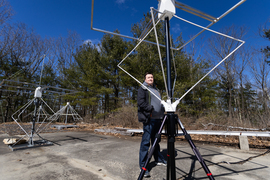
MIT Haystack scientists prepare a constellation of instruments to observe the solar eclipse’s effects

3Q: A bold mission to touch the sun
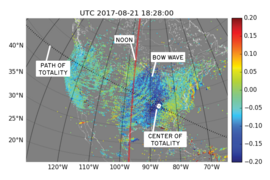
Solar eclipse caused bow waves in Earth's atmosphere
More mit news.

Modular, scalable hardware architecture for a quantum computer
Read full story →

Looking for a specific action in a video? This AI-based method can find it for you
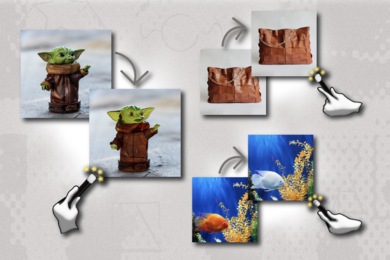
Controlled diffusion model can change material properties in images

Sophia Chen: It’s our duty to make the world better through empathy, patience, and respect

Using art and science to depict the MIT family from 1861 to the present

Convening for cultural change
- More news on MIT News homepage →
Massachusetts Institute of Technology 77 Massachusetts Avenue, Cambridge, MA, USA
- Map (opens in new window)
- Events (opens in new window)
- People (opens in new window)
- Careers (opens in new window)
- Accessibility
- Social Media Hub
- MIT on Facebook
- MIT on YouTube
- MIT on Instagram
share this!
May 21, 2024
This article has been reviewed according to Science X's editorial process and policies . Editors have highlighted the following attributes while ensuring the content's credibility:
fact-checked
peer-reviewed publication
trusted source
Math discovery provides new method to study cell activity, aging
by Meg Henderson, Mississippi State University

New mathematical tools revealing how quickly cell proteins break down are poised to uncover deeper insights into how we age, according to a recently published paper co-authored by a Mississippi State researcher and his colleagues from Harvard Medical School and the University of Cambridge.
Galen Collins, assistant professor in MSU's Department of Biochemistry, Molecular Biology, Entomology and Plant Pathology, co-authored the paper published in the Proceedings of the National Academy of Sciences in April.
"We already understand how quickly proteins are made, which can happen in a matter of minutes," said Collins, who is also a scientist in the Mississippi Agricultural and Forestry Experiment Station. "Until now, we've had a very poor understanding of how much time it takes them to break down."
The paper in applied mathematics, " Maximum entropy determination of mammalian proteome dynamics ," presents the new tools that quantify the degradation rates of cell proteins—how quickly they break down—helping us understand how cells grow and die and how we age. Proteins— complex molecules made from various combinations of amino acids—carry the bulk of the workload within a cell, providing its structure, responding to messages from outside the cell and removing waste.
The results proved that not all proteins degrade at the same pace but instead fall into one of three categories, breaking down over the course of minutes, hours or days. While previous research has examined cell protein breakdown, this study was the first to quantify mathematically the degradation rates of all cell protein molecules, using a technique called maximum entropy.
"For certain kinds of scientific questions, experiments can often reveal infinitely many possible answers; however, they are not all equally plausible," said lead author Alexander Dear, research fellow in applied mathematics at Harvard University.
"The principle of maximum entropy is a mathematical law that shows us how to precisely calculate the plausibility of each answer—its 'entropy'—so that we can choose the one that is the most likely."
"This kind of math is sort of like a camera that zooms in on your license plate from far away and figures out what the numbers should be," Collins said. "Maximum entropy gives us a clear and precise picture of how protein degradation occurs in cells."
In addition, the team used these tools to study some specific implications of protein degradation for humans and animals. For one, they examined how those rates change as muscles develop and adapt to starvation.
"We found that starvation had the greatest impact on the intermediate group of proteins in muscular cells, which have a half-life of a few hours, causing the breakdown to shift and accelerate," Collins said. "This discovery could have implications for cancer patients who experience cachexia, or muscle wasting due to the disease and its treatments."
They also explored how a shift in the breakdown of certain cell proteins contributes to neurodegenerative disease.
"These diseases occur when waste proteins, which usually break down quickly, live longer than they should," Collins said. "The brain becomes like a teenager's bedroom, accumulating trash, and when you don't clean it up, it becomes uninhabitable."
Dear affirmed the study's value lies not only in what it revealed about cell protein degeneration, but also in giving scientists a new method to investigate cell activity with precision.
"Our work provides a powerful new experimental method for quantifying protein metabolism in cells," he said. "Its simplicity and rapidity make it particularly well-suited for studying metabolic changes."
Journal information: Proceedings of the National Academy of Sciences
Provided by Mississippi State University
Explore further
Feedback to editors

Researchers create materials with unique combination of stiffness, thermal insulation
3 minutes ago

Scientists identify gene that could lead to resilient 'pixie' corn
25 minutes ago

New antibiotic kills pathogenic bacteria, spares healthy gut microbes
54 minutes ago

Researchers discover that hnRNPM guards integrity of cellular protein production

Acute sense of touch helps hummingbirds hover near a flower without bumping into it, study shows

Study suggests children are often exposed to problematic click bait during YouTube searches

Complete X and Y chromosome sequences of living great ape species determined

Researchers elucidate the spatial structure and molecular mechanisms of 'prime editor,' a novel gene-editing tool

Research team demonstrates modular, scalable hardware architecture for a quantum computer

New study is step towards energy-efficient quantum computing in magnets
Relevant physicsforums posts, question about branch of logarithm.
17 hours ago
Memorizing trigonometric identities
May 26, 2024
Graphing trip efficiency - distance over time
May 20, 2024
Help with Recurrence Equation
May 18, 2024
Numerically how to approximate exponential decay in a discrete signal
May 16, 2024
Flat surface to curved surface
May 13, 2024
More from General Math
Related Stories

AI helps map the 'postal workers' in cells
May 11, 2023

Scientists identify class of binding molecules that can be used for targeted protein degradation
Apr 3, 2024

The birth and death of proteins in a single cell
Aug 23, 2018

Scientists generate new targeted protein degradation system that tunes a cell's own proteins
Mar 15, 2024

What is a protein? A biologist explains
Jan 13, 2021

Entropy explains RNA diffusion rates in cells
Aug 7, 2019
Recommended for you

Mechanistic model shows how much gossip is needed to foster social cooperation
May 15, 2024

Random processes shape science and math: Researchers propose a unified, probabilistic framework
May 9, 2024

Study of new method used to preserve privacy with US census data suggests accuracy has suffered
May 6, 2024

New study is first to use statistical physics to corroborate 1940s social balance theory
May 3, 2024

Too many vehicles, slow reactions and reckless merging: New math model explains how traffic and bacteria move
Apr 30, 2024

Theoretical biologists test two modes of social reasoning and find surprising truths in simplicity
Apr 29, 2024
Let us know if there is a problem with our content
Use this form if you have come across a typo, inaccuracy or would like to send an edit request for the content on this page. For general inquiries, please use our contact form . For general feedback, use the public comments section below (please adhere to guidelines ).
Please select the most appropriate category to facilitate processing of your request
Thank you for taking time to provide your feedback to the editors.
Your feedback is important to us. However, we do not guarantee individual replies due to the high volume of messages.
E-mail the story
Your email address is used only to let the recipient know who sent the email. Neither your address nor the recipient's address will be used for any other purpose. The information you enter will appear in your e-mail message and is not retained by Phys.org in any form.
Newsletter sign up
Get weekly and/or daily updates delivered to your inbox. You can unsubscribe at any time and we'll never share your details to third parties.
More information Privacy policy
Donate and enjoy an ad-free experience
We keep our content available to everyone. Consider supporting Science X's mission by getting a premium account.
E-mail newsletter
Cookies on GOV.UK
We use some essential cookies to make this website work.
We’d like to set additional cookies to understand how you use GOV.UK, remember your settings and improve government services.
We also use cookies set by other sites to help us deliver content from their services.
You have accepted additional cookies. You can change your cookie settings at any time.
You have rejected additional cookies. You can change your cookie settings at any time.
- Education, training and skills
- School curriculum
- Primary curriculum, key stage 2
- Maths (key stage 2)
Key stage 2 tests: 2024 mathematics test materials
Mathematics test materials administered to eligible pupils at the end of key stage 2 in May 2024.
2024 key stage 2 mathematics Paper 1: arithmetic
Ref: ISBN 978-1-83507-032-1, STA/24/8817/e
PDF , 543 KB , 20 pages
2024 key stage 2 mathematics Paper 2: reasoning
Ref: ISBN 978-1-83507-033-8, STA/24/8818/e
PDF , 2.46 MB , 24 pages
2024 key stage 2 mathematics Paper 3: reasoning
Ref: ISBN 978-1-83507-034-5, STA/24/8819/e
PDF , 321 KB , 24 pages
2024 key stage 2 mathematics - administering Paper 1: arithmetic
Ref: ISBN 978-1-83507-145-8, STA/24/8830/e
PDF , 224 KB , 4 pages
2024 key stage 2 mathematics - administering Paper 2: reasoning
Ref: ISBN 978-1-83507-146-5, STA/24/8831/e
PDF , 247 KB , 8 pages
2024 key stage 2 mathematics - administering Paper 3: reasoning
Ref: ISBN 978-1-83507-147-2, STA/24/8832/e
PDF , 248 KB , 8 pages
2024 key stage 2 mathematics mark schemes
Ref: ISBN 978-1-83507-035-2, STA/24/8820/e
PDF , 1.13 MB , 40 pages
2024 copyright ownership: key stage 2 national curriculum tests
Key stage 2 mathematics tests were administered in schools in May 2024. Test administration instructions and mark schemes are also provided.
Please refer to the copyright ownership report for details of how schools, educational establishments and third parties can use these materials.
Related content
Is this page useful.
- Yes this page is useful
- No this page is not useful
Help us improve GOV.UK
Don’t include personal or financial information like your National Insurance number or credit card details.
To help us improve GOV.UK, we’d like to know more about your visit today. Please fill in this survey (opens in a new tab) .
People's Understanding of Inflation
This paper studies people's understanding of inflation—their perceived causes, consequences, trade-offs—and the policies supported to mitigate its effects. We design a new, detailed online survey based on the rich existing literature in economics with two experimental components—a conjoint experiment and an information experiment—to examine how well public views align with established economic theories. Our key findings show that the major perceived causes of inflation include government actions, such as increased foreign aid and war-related expenditures, alongside rises in production costs attributed to recent events like the COVID-19 pandemic, oil price fluctuations, and supply chain disruptions. Respondents' anticipate many negative consequences of inflation but the most noted one is the increased complexity and difficulty in household decision-making. Partisan differences emerge distinctly, with Republicans more likely to attribute inflation to government policies and foresee broader negative outcomes, whereas Democrats anticipate greater inequality effects. Inflation is perceived as an unambiguously negative phenomenon without any potential positive economic correlates. Notably, there is a widespread belief that managing inflation can be achieved without significant trade-offs, such as reducing economic activity or increasing unemployment. These perceptions are hard to move experimentally. In terms of policy responses, there is resistance to monetary tightening, consistent with the perceived absence of trade-offs and the belief that it is unnecessary to reduce economic activity to fight inflation. The widespread misconception that inflation rises following increases in interest rates even leads to support for rate cuts to reduce inflation. There is a clear preference for policies that are perceived to have other benefits, such as reducing government debt in progressive ways or increasing corporate taxes, and for support for vulnerable households, despite potential inflationary effects.
The project is approved by IRB at Harvard University (IRB24-0213). The views expressed herein are those of the authors and do not necessarily reflect the views of the National Bureau of Economic Research.
MARC RIS BibTeΧ
Download Citation Data
Working Groups
Conferences, more from nber.
In addition to working papers , the NBER disseminates affiliates’ latest findings through a range of free periodicals — the NBER Reporter , the NBER Digest , the Bulletin on Retirement and Disability , the Bulletin on Health , and the Bulletin on Entrepreneurship — as well as online conference reports , video lectures , and interviews .


IMAGES
VIDEO
COMMENTS
251+ Math Research Topics: Beginners To Advanced. Prime Number Distribution in Arithmetic Progressions. Diophantine Equations and their Solutions. Applications of Modular Arithmetic in Cryptography. The Riemann Hypothesis and its Implications. Graph Theory: Exploring Connectivity and Coloring Problems.
If you are an undergraduate looking for some research topics for your next math paper, you will surely appreciate our list of interesting undergraduate math research topics: Methods to count discrete objects. The origins of Greek symbols in mathematics. Methods to solve simultaneous equations. Real-world applications of the theorem of Pythagoras.
260 Interesting Math Topics for Essays & Research Papers. (45 votes) Mathematics is the science of numbers and shapes. Writing about it can give you a fresh perspective and help to clarify difficult concepts. You can even use mathematical writing as a tool in problem-solving.
Mathematics, Pure and Applied Math | Explore the latest full-text research PDFs, articles, conference papers, preprints and more on MATHEMATICS. Find methods information, sources, references or ...
Mathematics (since February 1992) For a specific paper, enter the identifier into the top right search box. Browse: new (most recent mailing, ... math.MP is an alias for math-ph. Articles in this category focus on areas of research that illustrate the application of mathematics to problems in physics, develop mathematical methods for such ...
Here are some of the best math research paper topics for high school. How to draw a chart representing the financial analysis of a prominent company over the last five years. How to solve a matrix- The vital principles and formulas to embrace. Exploring various techniques for solving finance and mathematical gaps.
Pure mathematics uses mathematics to explore abstract ideas, mathematics that does not necessarily describe a real physical system. This can include developing the fundamental tools used by ...
In applied mathematics, we look for important connections with other disciplines that may inspire interesting and useful mathematics, and where innovative mathematical reasoning may lead to new insights and applications. Combinatorics. Computational Biology. Physical Applied Mathematics. Computational Science & Numerical Analysis.
Explores how the application of mathematics and statistics can drive scientific developments across data science, engineering, finance, physics, biology, ecology, business, medicine, and beyond ... 120 Research Topics Guest edit your own article collection Suggest a topic. Submission. null. Submission
Research in the Mathematical Sciences is an international, peer-reviewed journal encompassing the full scope of theoretical and applied mathematics, as well as theoretical computer science. Encourages submission of longer articles for more complex and detailed analysis and proofing of theorems. Publishes shorter research communications (Letters ...
bio-mathematics: introduction to the mathematical model of the hepatitis c virus, lucille j. durfee. pdf. analysis and synthesis of the literature regarding active and direct instruction and their promotion of flexible thinking in mathematics, genelle elizabeth gonzalez. pdf. life expectancy, ali r. hassanzadah. pdf
Applied mathematics is the application of mathematical techniques to describe real-world systems and solve technologically relevant problems. This can include the mechanics of a moving body, the ...
202 Math Research Topics: List To Vary Your Ideas. Mathematics is an exceptional field of study dealing primarily with numbers. It also deals with structures, formulas, shapes, spaces, and quantities of where they are contained. Maths encompasses different types of computations that are applied in the real world. Math requires a lot of analysis.
In this paper, we summarize the responses to these two questions. Similar to Sfard's approach, we start by synthesizing the voices of the respondents before formulating our own views.Some colleagues put forward the idea of formulating a list of key themes or questions, similar to the 23 unsolved mathematical problems that David Hilbert published around 1900 (cf. Schoenfeld, 1999).
Mathematics Research Paper Topics. Mathematics undoubtedly began as an entirely practical activity— measuring fields, determining the volume of liquids, counting out coins, and the like. During the golden era of Greek science, between about the sixth and third centuries B.C., however, mathematicians introduced a new concept to their study of ...
Algebraic combinatorics has applications in many areas of mathematics, including combinatorics, computer science, and mathematical physics. These are just a few of the many research topics in algebraic geometry. Algebraic geometry is a vast and growing field, and there are many exciting new directions for research.
Department members engage in cutting-edge research on a wide variety of topics in mathematics and its applications. Topics continually evolve to reflect emerging interests and developments, but can roughly grouped into the following areas. Algebra, Combinatorics, and Geometry Algebra, combinatorics, and geometry are areas of very active research at the University of Pittsburgh.
Research Paper Topics ; 25 Maths Research Paper Topics; 25 Maths Research Paper Topics. Some may think that writing a research paper on Math can be dull, but let us assure you that the world of mathematics is vivid and wonderful. Mathematics is the universal language that can describe everything and anything: from music to galaxies orbiting ...
Research in Mathematics, Volume 11, Issue 1 (2024) See all volumes and issues. Volume 11, 2024 Vol 10, 2023 Vol 9, 2022 Vol 8, 2021 Vol 7, 2020 Vol 6, 2019 Vol 5, 2018 Vol 4, 2017 Vol 3, 2016 Vol 2, 2015 Vol 1, 2014. Download citations Download PDFs Download issue. Browse by section (All)
Mathematics research influences student learning in a number of ways: Research provides students with an understanding of what it means to do mathematics and of mathematics as a living, growing field. Writing mathematics and problem-solving become central to student's learning. Students develop mastery of mathematics topics.
Research in Mathematics Education, Volume 26, Issue 1 (2024) See all volumes and issues. Volume 26, 2024 Vol 25, 2023 Vol 24, 2022 Vol 23, 2021 Vol 22, 2020 Vol 21, 2019 Vol 20, 2018 Vol 19, 2017 Vol 18, 2016 Vol 17, 2015 Vol 16, 2014 Vol 15, 2013 Vol 14, 2012 Vol 13, 2011 Vol 12, 2010 Vol 11, 2009 Vol 10, 2008 Vol 9, 2007 Vol 8, 2006 Vol 7 ...
This is the second part of the research project initiated in Cleanthous et al (2024). ... View a PDF of the paper titled Adaptive estimation of the $\mathbb{L}_2$-norm of a probability density and related topics II. Upper bounds via the oracle approach, by Galatia Cleanthous and 1 other authors.
Pure Mathematics Fields. The E 8 Lie group. Algebra & Algebraic Geometry. Algebraic Topology. Analysis & PDEs. Geometry & Topology. Mathematical Logic & Foundations. Number Theory.
Topic modeling is a widely utilized tool in text analysis. We investigate the optimal rate for estimating a topic model. Specifically, we consider a scenario with n documents, a vocabulary of size p, and document lengths at the order N. When N≥c·p, referred to as the long-document case, the optimal rate is established in the literature at p/(Nn). However, when N=o(p), referred to as the ...
A Feature Paper should be a substantial original Article that involves several techniques or approaches, provides an outlook for future research directions and describes possible research applications. Feature papers are submitted upon individual invitation or recommendation by the scientific editors and must receive positive feedback from the ...
Researchers at MIT and elsewhere have found that the sun's magnetic field "could form much closer to the star's surface than previously thought," reports Will Sullivan for Smithsonian Magazine.. "The findings could help improve forecasts of solar activity that can affect satellites, power grids and communications systems on Earth—and produce magnificent auroras," explains Sullivan.
The paper in applied mathematics, "Maximum entropy determination of mammalian proteome dynamics," presents the new tools that quantify the degradation rates of cell proteins—how quickly they ...
Mathematics test materials administered to eligible pupils at the end of key stage 2 in May 2024. ... Research and statistics. ... 2024 key stage 2 mathematics Paper 1: arithmetic. Ref: ISBN 978-1 ...
Algorithmic Bias and Historical…. Algorithmic Bias and Historical Injustice: Race and Digital Profiling. Abigail Matthew, Amalia R. Miller & Catherine Tucker. Share. X. Working Paper 32485. DOI 10.3386/w32485. Issue DateMay 2024. This paper studies the implications of attempts at "ethnic-affinity" profiling on Facebook that reflects users ...
DOI 10.3386/w32497. Issue Date May 2024. This paper studies people's understanding of inflation—their perceived causes, consequences, trade-offs—and the policies supported to mitigate its effects. We design a new, detailed online survey based on the rich existing literature in economics with two experimental components—a conjoint ...